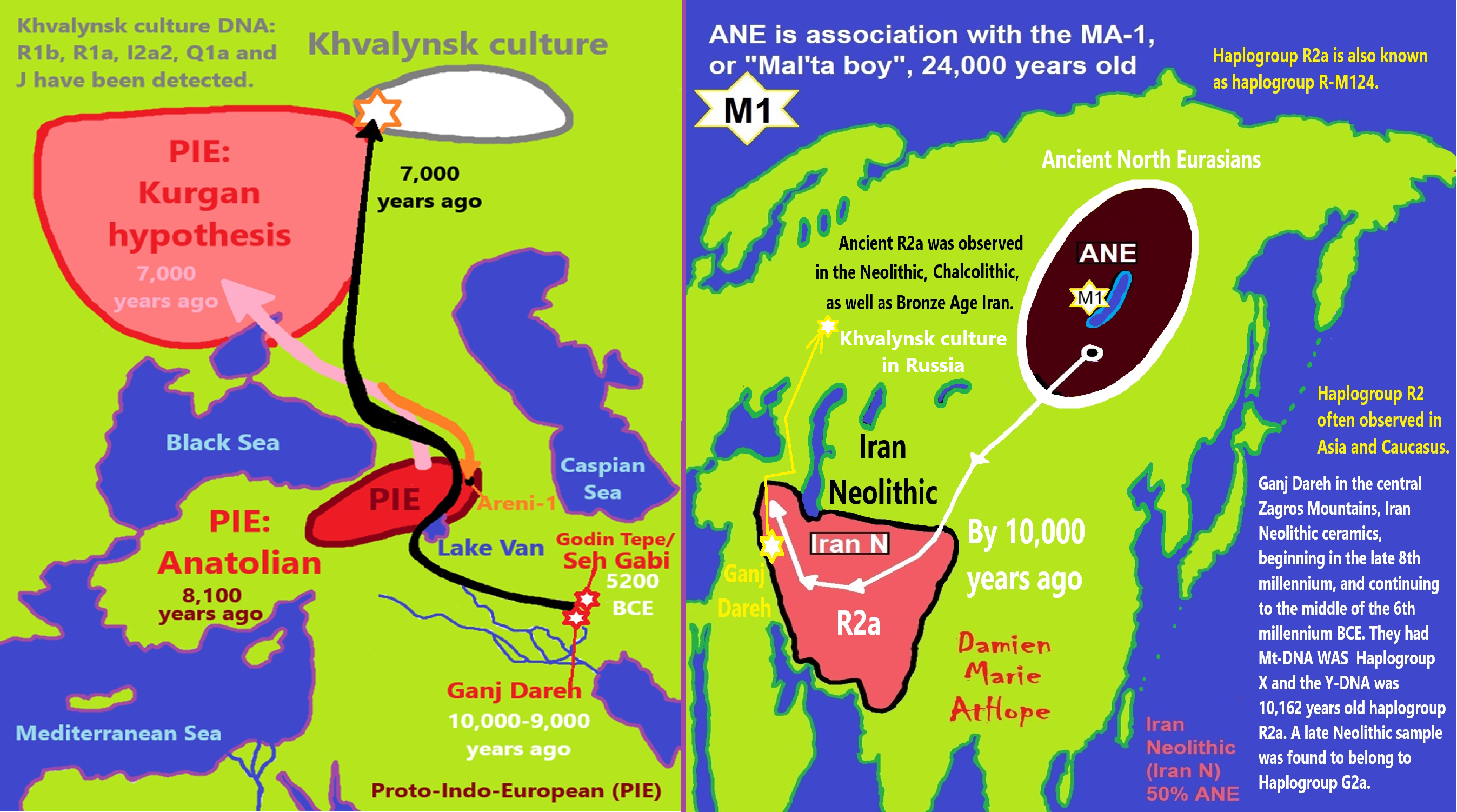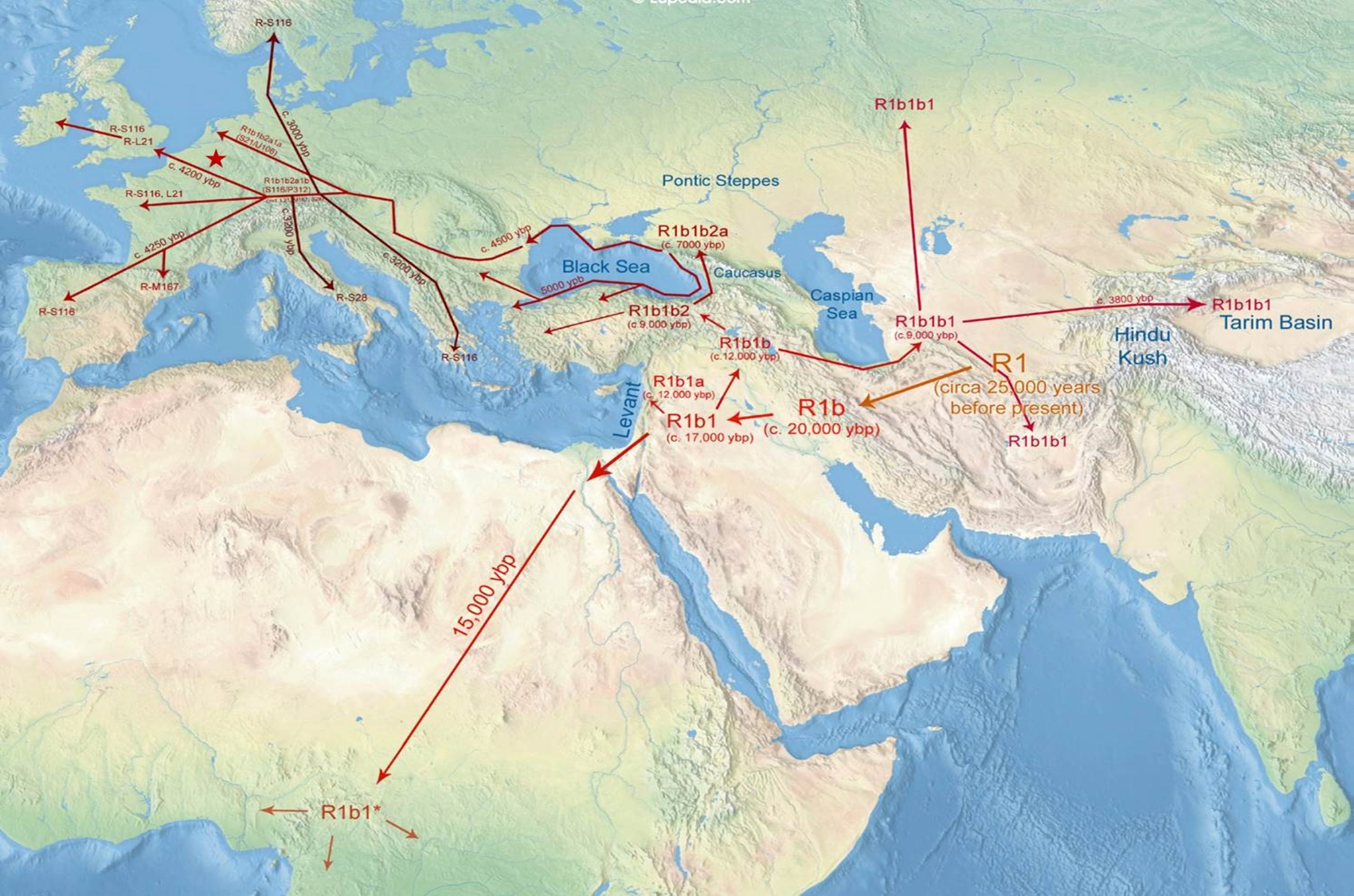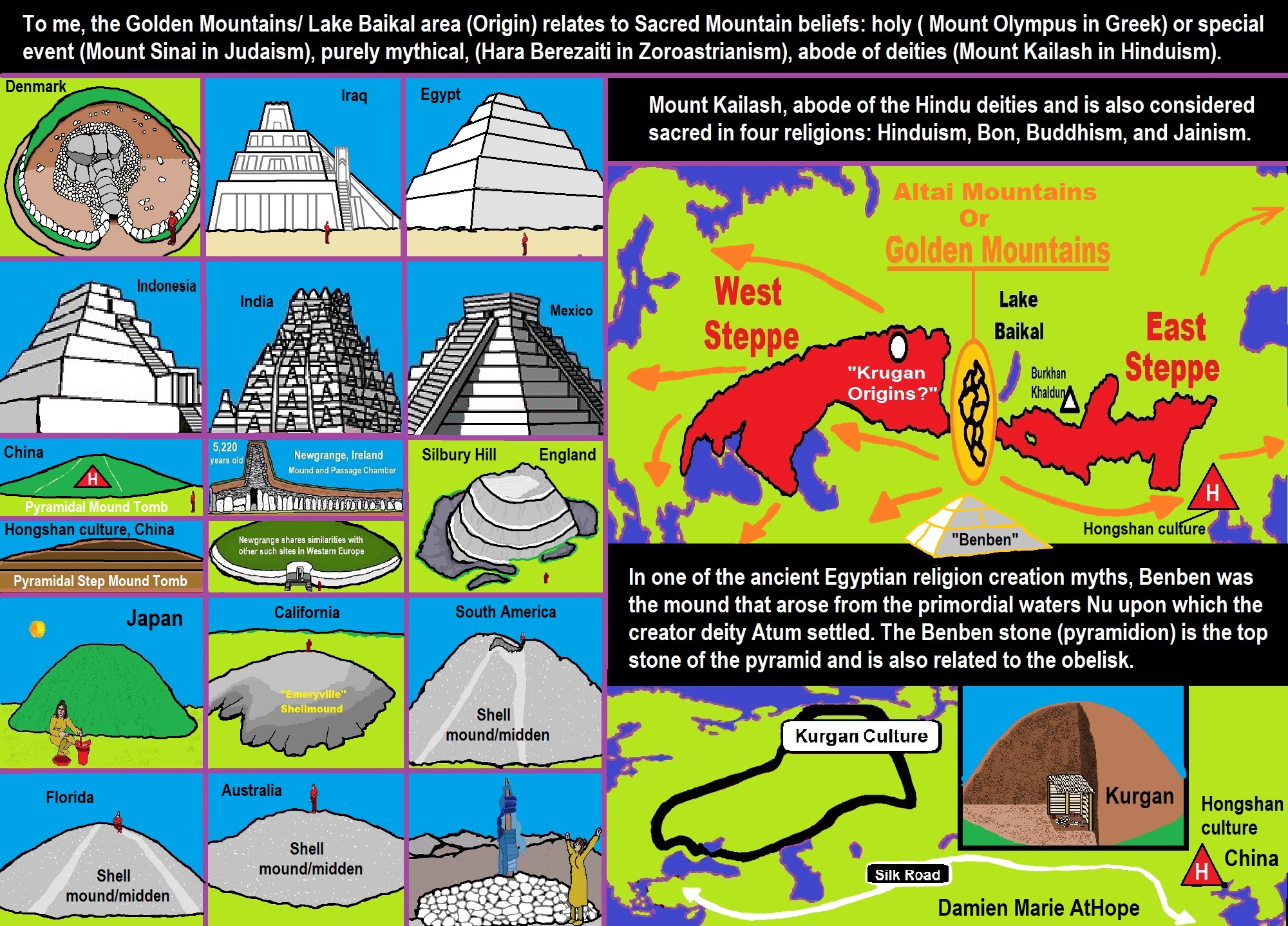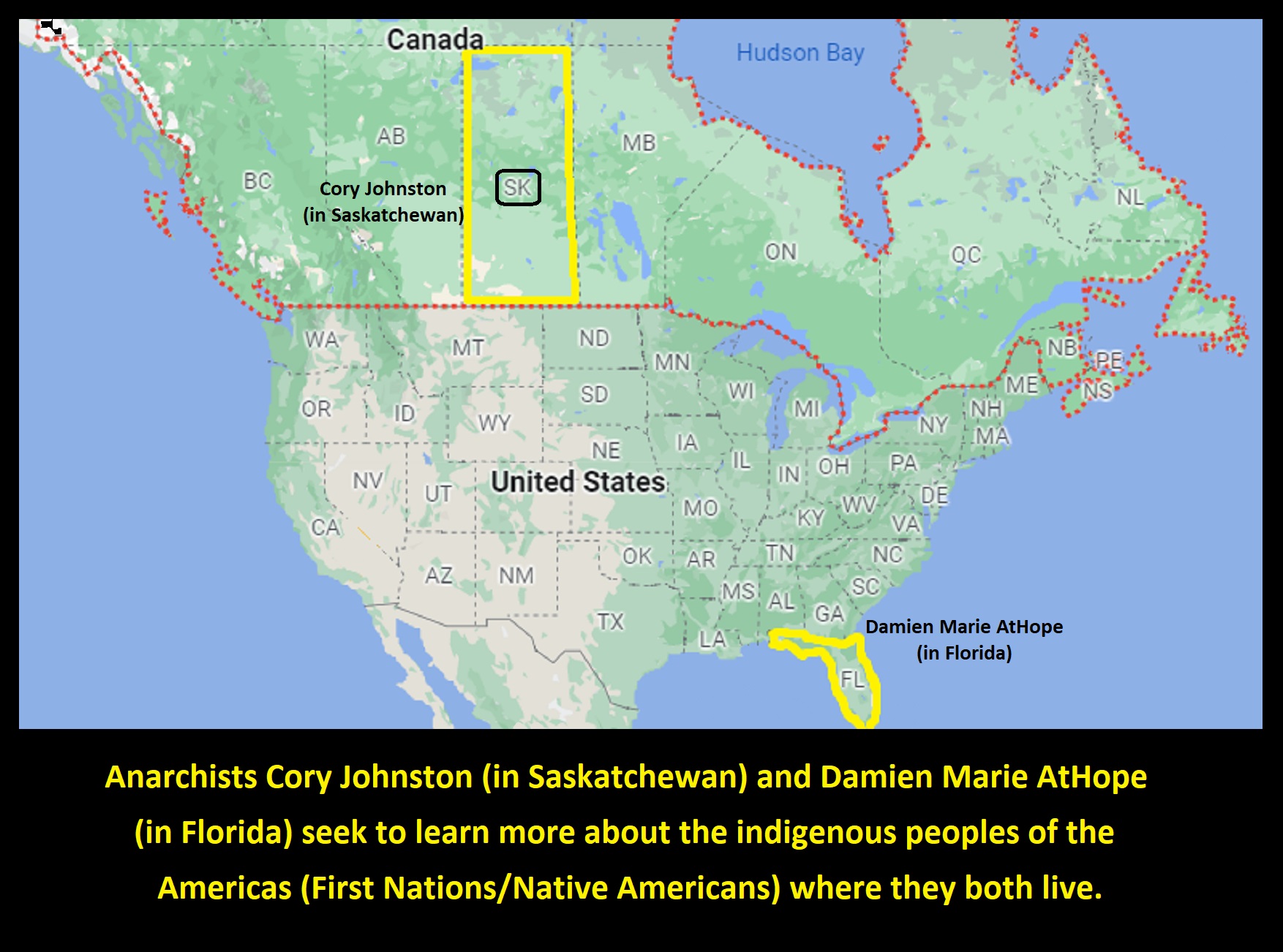
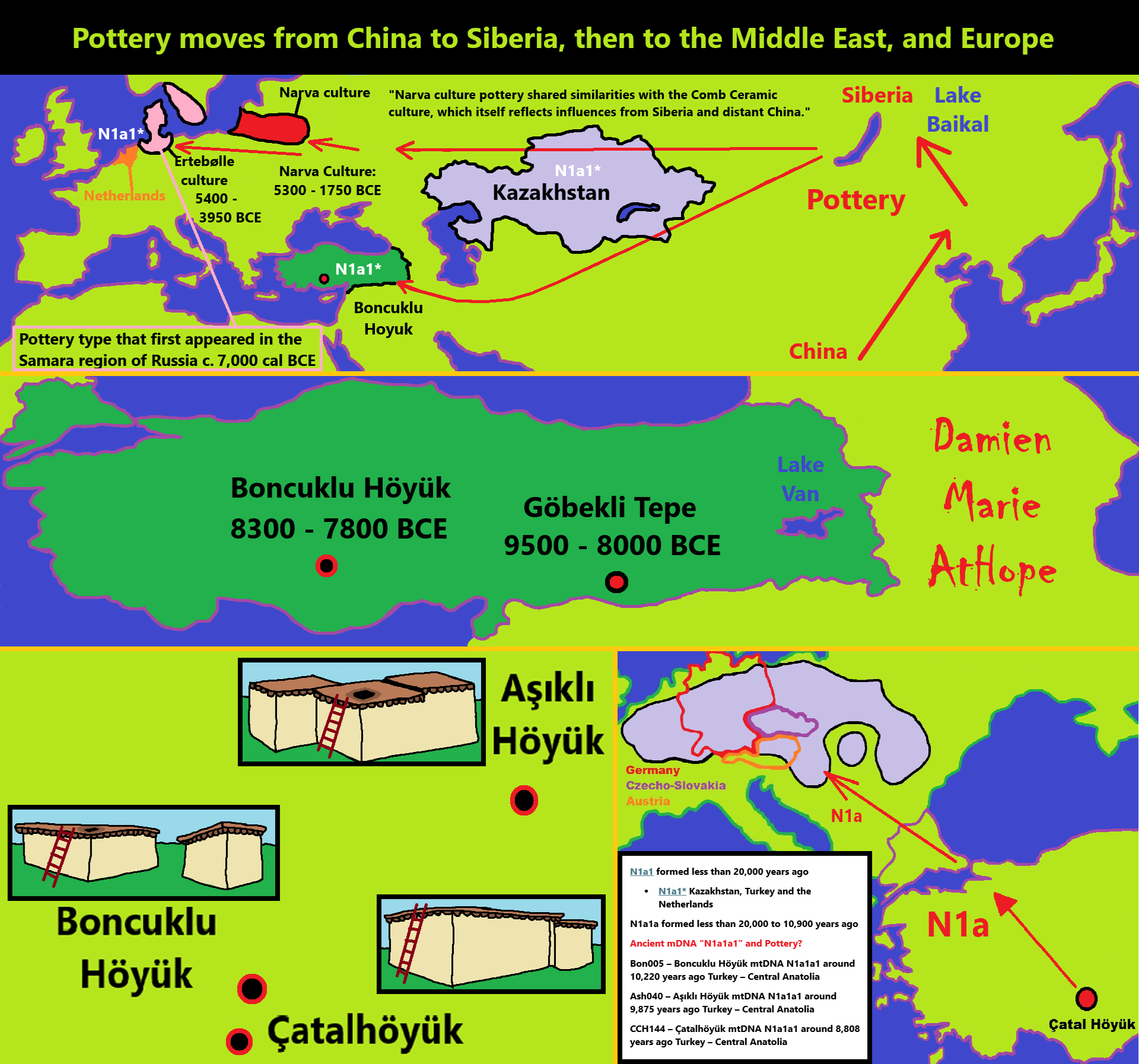
Pottery from at 10,000 at Boncuklu Höyük, to Aşıklı Höyük, to Çatalhöyük, then Europe by around 7,500 years ago.
Pottery moves from China to Siberia, then to the Middle East, and Europe
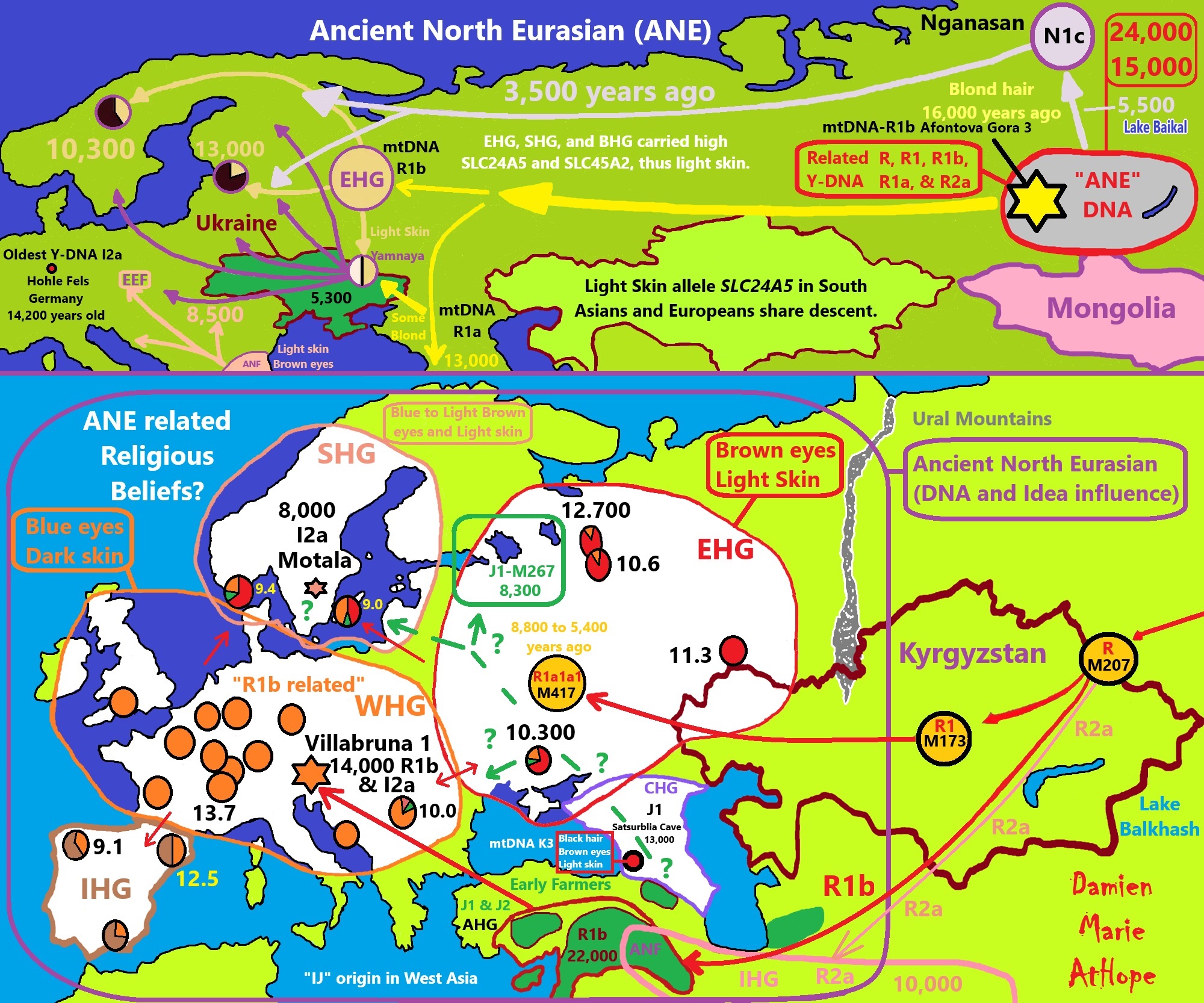
ref, ref, ref, ref, ref, ref, ref, ref, ref, ref, ref, ref, ref, ref, ref, ref, ref, ref, ref, ref, ref, ref, ref, ref, ref, ref, ref, ref, ref
Genetic Relations to Ancient North Eurasians (ANE):
Eastern hunter-gatherer (EHG)
Caucasus hunter-gatherer (CHG)
Zagros/Iranian Hunter-Gatherer (IHG)
Iranian Neolithic Farmers (INF)
Anatolian hunter-gatherer (AHG)
Anatolian Neolithic Farmers (ANF)
Early European Farmers (EEF)
Yamnaya/Steppe Herders (WSH)
Villabruna 1 (burial)/Ripari Villabruna rock shelter in northern Italy (14,000 years old)
Satsurblia Cave (burial) in the Country of Georgia (13,000 years old)
Motala (burial) (8,000 years old)
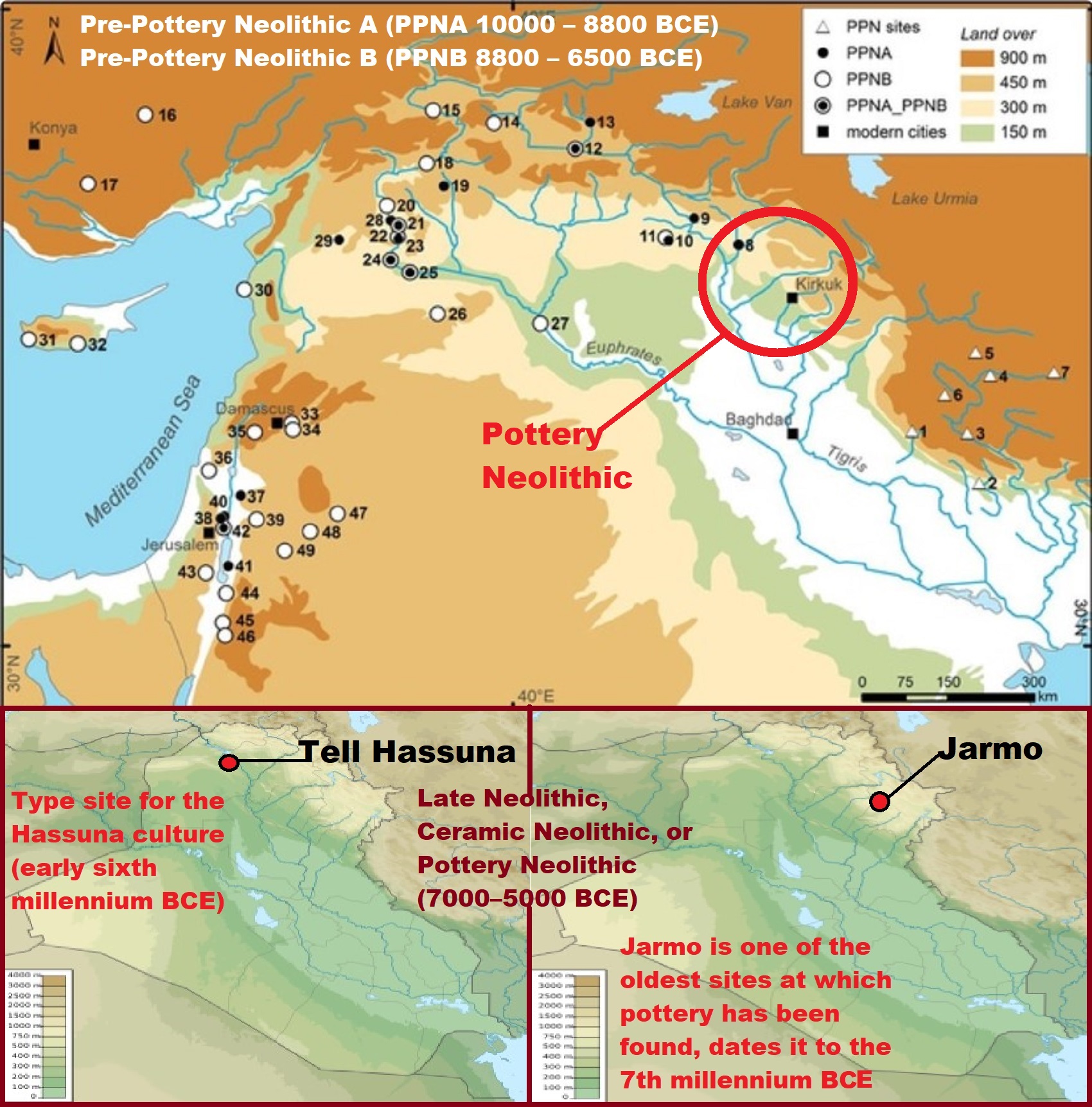
“Location of important archaeological sites in the Fertile Crescent: 1 – Chogha Golan, 2 – Ali Kosh, 3 – Chia Sabz, 4 – Ganj Dareh Tepe, 5 – Sheikh-e Abad, 6 – Jani, 7 – Tepe Abdul Hosein, 8 – M’lefaat, 9 – Nemrik, 10 – Qermez Dere, 11 – Magzalia, 12 – Körtik Tepe, 13 – Hallan Cemi, 14 – Cayonu, 15 – Cafer Hoyuk, 16 – Asikli Hoyuk, 17 – Can Hasan III, 18 – Nevali Cori, 19 – Göbekli Tepe, 20 – Akarcay Tepe, 21 – Djade, 22 – Halula, 23 – Jerf el Ahmar, 24 – Mureybet, 25 – Abu Hureyra, 26 – El Kowm I and II, 27 – Bouqras, 28 – Abr, 29 – Qaramel, 30 – Tell Ras Shamra, 31 – Kissonerga, 32 – Parekklisha-Shillourokambos, 33 – Tell Ghoraifé, 34 – Tell Aswad, 35 – Tell Ramad, 36 – Yiftah’el, 37 – Iraq ed Dubb, 38 – Gilgal, 39 – ‘Ain Ghazal, 40 – Netiv Hagdud, 41 – Dhra, 42 – Jericho, 43 – Nahal Hemar, 44 – Wadi Fidan, 45 – Beidha, 46 – Basta, 47 – Dhuweila, 48 – Azraq 31, 49 – Wadi Jilat 7 (Simone Riehl et al)” ref
PPNA /PPNB /PPNC: “Beyond the Pre-pottery Neolithic B interaction sphere” by Eleni Asouti
PPNA /PPNB /PPNC: “Our Place: Our Place in the World. Newsletter. January 2014” by Lee Clare
Animal domestication: “Subsistence and beyond: Animals in Neolithic Anatolia” by Benjamin Arbuckle
“EARLY ANIMAL PRODUCTION FOR MARITAL TRADE: A NEOLITHIC BRIDE-PRICE?” by Cedric Bodet
Pre-Pottery Neolithic
(10,000 – 6,500 BCE or 12,022-8,522 years ago)
“The Pre-Pottery Neolithic (PPN) represents the early Neolithic in the Levantine and upper Mesopotamian region of the Fertile Crescent, dating to c. 12,000 – c. 8,500 years ago, (10000 – 6500 BCE). It succeeds the Natufian culture of the Epipalaeolithic Near East (also called Mesolithic), as the domestication of plants and animals was in its formative stages, having possibly been induced by the Younger Dryas. The Pre-Pottery Neolithic culture came to an end around the time of the 8.2-kiloyear event, a cool spell centered on 6200 BCE that lasted several hundred years. It is succeeded by the Pottery Neolithic, also known as the Late Neolithic, or the Ceramic Neolithic” ref
“The time period is characterized by tiny circular mud-brick dwellings, the cultivation of crops, the hunting of wild game, and unique burial customs in which bodies were buried below the floors of dwellings. The Pre-Pottery Neolithic A and the following Pre-Pottery Neolithic B (PPNB) were originally defined by Kathleen Kenyon in the type site of Jericho (Palestine). During this time, pottery was not yet in use. They precede the ceramic Neolithic (Yarmukian). PPNA succeeds the Natufian culture of the Epipaleolithic (Mesolithic).” ref
“PPNA archaeological sites are much larger than those of the preceding Natufian hunter-gatherer culture, and contain traces of communal structures, such as the famous Tower of Jericho. PPNA settlements are characterized by round, semi-subterranean houses with stone foundations and terrazzo-floors. The upper walls were constructed of unbaked clay mudbricks with plano-convex cross-sections. The hearths were small and covered with cobbles. Heated rocks were used in cooking, which led to an accumulation of fire-cracked rock in the buildings, and almost every settlement contained storage bins made of either stones or mud-brick.” ref
“As of 2013 Gesher, modern Israel, became the earliest known of all known Neolithic sites (PPNA), with a calibrated Carbon 14 date of 10,459 BCE ± 348 years, analysis suggesting that it may have been the starting point of a Neolithic revolution. A contemporary site is Mureybet in modern Syria. One of the most notable PPNA settlements is Jericho, thought to be the world’s first town (c. 9,000 BCE).” ref
“The PPNA town contained a population of up to 2,000–3,000 people and was protected by a massive stone wall and tower. There is much debate over the function of the wall, for there is no evidence of any serious warfare at this time. One possibility is the wall was built to protect the salt resources of Jericho. It has also been proposed that the tower caught the shadow of the largest nearby mountain on summer solstice in order to create a sense of power in support of whatever hierarchy ruled the town’s inhabitants.” ref
“PPNA cultures are unique for their burial practices, and Kenyon (who excavated the PPNA level of Jericho) characterized them as “living with their dead”. Kenyon found no fewer than 279 burials, below floors, under household foundations, and in between walls. In the PPNB period, skulls were often dug up and reburied, or mottled with clay and (presumably) displayed. The lithic industry is based on blades struck from regular cores. Sickle-blades and arrowheads continue traditions from the late Natufian culture, transverse-blow axes, and polished adzes appear for the first time.” ref
“Sedentism of this time allowed for the cultivation of local grains, such as barley and wild oats, and for storage in granaries. Sites such as Dhra′ and Jericho retained a hunting lifestyle until the PPNB period, but granaries allowed for year-round occupation. This period of cultivation is considered “pre-domestication“, but may have begun to develop plant species into the domesticated forms they are today. Deliberate, extended-period storage was made possible by the use of “suspended floors for air circulation and protection from rodents”. This practice “precedes the emergence of domestication and large-scale sedentary communities by at least 1,000 years.” ref
“Granaries are positioned in places between other buildings early on c. 11,522 years ago, however, beginning around 10,522 years ago, they were moved inside houses, and by 9,522 years ago storage occurred in special rooms. This change might reflect changing systems of ownership and property as granaries shifted from communal use and ownership to become under the control of households or individuals.” ref
“It has been observed of these granaries that their “sophisticated storage systems with subfloor ventilation are a precocious development that precedes the emergence of almost all of the other elements of the Near Eastern Neolithic package—domestication, large scale sedentary communities, and the entrenchment of some degree of social differentiation”. Moreover, “[b]uilding granaries may […] have been the most important feature in increasing sedentism that required active community participation in new life-ways.” ref
“With more sites becoming known, archaeologists have defined a number of regional variants of Pre-Pottery Neolithic A:
- (Aswadian) in the Damascus Basin, defined by finds from Tell Aswad IA; typical: bipolar cores, big sickle blades, Aswad points. The ‘Aswadian’ variant recently was abolished by the work of Danielle Stordeur in her initial report from further investigations in 2001–2006. The PPNB horizon was moved back at this site, to around 10,722 years ago.
- Mureybetian in the Northern Levant, defined by the finds from Mureybet IIIA, IIIB, typical: Helwan points, sickle-blades with base amenagée or short stem and terminal retouch. Other sites include Sheyk Hasan and Jerf el Ahmar.
- Sites in “Upper Mesopotamia” include Çayönü and Göbekli Tepe, with the latter possibly being the oldest ritual complex yet discovered.
- Sites in central Anatolia that include the ‘mother city’ Çatalhöyük and the smaller, but older site, rivaling even Jericho in age, Aşıklı Höyük.
- Sultanian in the Jordan River valley and the southern Levant, with the type site of Jericho. Other sites include Netiv HaGdud, El-Khiam, Hatoula, and Nahal Oren.” ref
Pre-Pottery Neolithic A
(10,000 – 6,500 BCE or 12,022-8,822 years ago)
“The Pre-Pottery Neolithic is divided into Pre-Pottery Neolithic A (PPNA 10000 – 8800 BCE) and the following Pre-Pottery Neolithic B (PPNB 8800 – 6500 BCE). These were originally defined by Kathleen Kenyon in the type site of Jericho (Palestine). The Pre-Pottery Neolithic precedes the ceramic Neolithic (Yarmukian culture, 6400 – 6200 BCE). At ‘Ain Ghazal, in Jordan, the culture continued a few more centuries as the so-called Pre-Pottery Neolithic C culture. Around 11000 years ago (9000 BCE), during the Pre-Pottery Neolithic A (PPNA), the world’s first town, Jericho, appeared in the Levant.” ref
Pre-Pottery Neolithic B
(8,800 – 6,500 BCE or 10,822-8,522 years ago)
“The Pre-Pottery Neolithic is divided into Pre-Pottery Neolithic A (10000 – 8800 BCE) and the following Pre-Pottery Neolithic B (8800 – 6500 BCE). PPNB differed from PPNA in showing greater use of domesticated animals, a different set of tools, and new architectural styles.” ref
“Like the earlier PPNA people, the PPNB culture developed from the Mesolithic Natufian culture. However, it shows evidence of a northerly origin, possibly indicating an influx from the region of northeastern Anatolia. Cultural tendencies of this period differ from that of the earlier Pre-Pottery Neolithic A (PPNA) period in that people living during this period began to depend more heavily upon domesticated animals to supplement their earlier mixed agrarian and hunter-gatherer diet.” ref
“In addition, the flint tool kit of the period is new and quite disparate from that of the earlier period. One of its major elements is the naviform core. This is the first period in which architectural styles of the southern Levant became primarily rectilinear; earlier typical dwellings were circular, elliptical, and occasionally even octagonal. Pyrotechnology, the expanding capability to control fire, was highly developed in this period. During this period, one of the main features of houses is a thick layer of white clay plaster flooring, highly polished and made of lime produced from limestone.” ref
“It is believed that the use of clay plaster for floor and wall coverings during PPNB led to the discovery of pottery. The earliest proto-pottery was White Ware vessels, made from lime and gray ash, built up around baskets before firing, for several centuries around 7000 BCE at sites such as Tell Neba’a Faour (Beqaa Valley). Sites from this period found in the Levant utilizing rectangular floor plans and plastered floor techniques were found at Ain Ghazal, Yiftahel (western Galilee), and Abu Hureyra (Upper Euphrates). The period is dated between c. 10,722-8,022 years ago.” ref
“Plastered human skulls were reconstructed human skulls that were made in the ancient Levant between 9000 and 6000 BCE in the Pre-Pottery Neolithic B period. They represent some of the oldest forms of art in the Middle East and demonstrate that the prehistoric population took great care in burying their ancestors below their homes. The skulls denote some of the earliest sculptural examples of portraiture in the history of art.” ref
“Danielle Stordeur‘s recent work at Tell Aswad, a large agricultural village between Mount Hermon and Damascus could not validate Henri de Contenson‘s earlier suggestion of a PPNA Aswadian culture. Instead, they found evidence of a fully established PPNB culture at 8700 BCE at Aswad, pushing back the period’s generally accepted start date by 1,200 years. Similar sites to Tell Aswad in the Damascus Basin of the same age were found at Tell Ramad and Tell Ghoraifé. How a PPNB culture could spring up in this location, practicing domesticated farming from 8700 BCE has been the subject of speculation. Whether it created its own culture or imported traditions from the North East or Southern Levant has been considered an important question for a site that poses a problem for the scientific community.” ref
“Work at the site of ‘Ain Ghazal in Jordan has indicated a later Pre-Pottery Neolithic C period, which existed between 8,222-7,922 years ago. Juris Zarins has proposed that a Circum Arabian Nomadic Pastoral Complex developed in the period from the climatic crisis of 6200 BCE, partly as a result of an increasing emphasis in PPNB cultures upon animal domesticates, and a fusion with Harifian hunter-gatherers in Southern Palestine, with affiliate connections with the cultures of Fayyum and the Eastern Desert of Egypt. Cultures practicing this lifestyle spread down the Red Sea shoreline and moved east from Syria into southern Iraq.” ref
The culture disappeared during the 8.2 kiloyear event, a term that climatologists have adopted for a sudden decrease in global temperatures that occurred approximately 8,200 years before the present, or c. 6200 BCE, and which lasted for the next two to four centuries. In the following Munhatta and Yarmukian post-pottery Neolithic cultures that succeeded it, rapid cultural development continues, although PPNB culture continued in the Amuq valley, where it influenced the later development of the Ghassulian culture.” ref
“Around 8000 BCE, before the invention of pottery, several early settlements became experts in crafting beautiful and highly sophisticated containers from stone, using materials such as alabaster or granite, and employing sand to shape and polish. Artisans used the veins in the material to the maximum visual effect. Such objects have been found in abundance on the upper Euphrates river, in what is today eastern Syria, especially at the site of Bouqras. These form the early stages of the development of the Art of Mesopotamia.” ref
“Pre-Pottery Neolithic B fossils that were analysed for ancient DNA were found to carry the Y-DNA (paternal) haplogroups E1b1b (2/7; ~29%), CT (2/7; ~29%), E(xE2,E1a,E1b1a1a1c2c3b1,E1b1b1b1a1,E1b1b1b2b) (1/7; ~14%), T(xT1a1,T1a2a) (1/7; ~14%), and H2 (1/7; ~14%). The CT clade was also observed in a Pre-Pottery Neolithic C specimen (1/1; 100%). Maternally, the rare basal haplogroup N* has been found among skeletal remains belonging to the Pre-Pottery Neolithic B, as have the mtDNA clades L3 and K.” ref
Haplogroup N and its related Uralic Languages and Cultures
DNA analysis has also confirmed ancestral ties between the Pre-Pottery Neolithic culture bearers and the makers of the Epipaleolithic Iberomaurusian culture of North Africa, the Mesolithic Natufian culture of the Levant, the Savanna Pastoral Neolithic culture of East Africa, the Early Neolithic Cardium culture of Morocco, and the Ancient Egyptian culture of the Nile Valley, with fossils associated with these early cultures all sharing a common genomic component.” ref
Pre-Pottery Neolithic C
“Work at the site of ‘Ain Ghazal in Jordan has indicated a later Pre-Pottery Neolithic C period. Juris Zarins has proposed that a Circum Arabian Nomadic Pastoral Complex developed in the period from the climatic crisis of 6200 BCE, partly as a result of an increasing emphasis in PPNB cultures upon domesticated animals, and a fusion with Harifian hunter-gatherers in the Southern Levant, with affiliate connections with the cultures of Fayyum and the Eastern Desert of Egypt. Cultures practicing this lifestyle spread down the Red Sea shoreline and moved east from Syria into southern Iraq.” ref
Pottery Neolithic (7000–5000 BCE)
“In the archaeology of Southwest Asia, the Late Neolithic, also known as the Ceramic Neolithic or Pottery Neolithic, is the final part of the Neolithic period, following on from the Pre-Pottery Neolithic and preceding the Chalcolithic. It is sometimes further divided into Pottery Neolithic A (PNA) and Pottery Neolithic B (PNB) phases. The Late Neolithic began with the first experiments with pottery, around 7000 BCE, and lasted until the discovery of copper metallurgy and the start of the Chalcolithic around 4500 BCE.” ref
“First experiments with pottery (c. 7000 BCE) with a Pottery bowl from Jarmo, Mesopotamia, 7100-5800 BCE. The northern Mesopotamian sites of Tell Hassuna and Jarmo are some of the oldest sites in the Near-East where pottery has been found, appearing in the most recent levels of excavation, which dates it to the 7th millennium BCE. This pottery is handmade, of simple design and with thick sides, and treated with a vegetable solvent. There are clay figures, zoomorphic or anthropomorphic, including figures of pregnant women which are taken to be fertility goddesses, similar to the Mother Goddess of later Neolithic cultures in the same region.” ref
“The Neolithic of the Southern Levant is divided into Pre-Pottery and Pottery or Late Neolithic phases, initially based on the sequence established by Kathleen Kenyon at Jericho. In the Mediterranean zone, the Pottery Neolithic is further subdivided into two subphases and several regional cultures, although the extent to which these represent real cultural phenomena is debated:
- Pottery Neolithic A (PNA) or Late Neolithic 1 (LN1)Yarmukian culture
Lodian (Jericho IX) culture - Pottery Neolithic B (PNB) or Late Neolithic 2 (LN2)Wadi Rabah culture” ref
“In the eastern desert regions of the Southern Levant—the Badia—the whole period is referred to as the Late Neolithic (c. 7000–5000 BCE). It is marked by the appearance of the first pastoralist societies in the desert, who may have migrated there following the abandonment of the large PPNB settlements to the west. In the southern Negev and Sinai Deserts, the Late Neolithic is characterized by the pastoralist Timnian culture, which persisted through to the Bronze Age.” ref
“The Late Neolithic began around 6,400 BCE in the Fertile Crescent, succeeding the period of the Pre-Pottery Neolithic. By then distinctive cultures emerged, with pottery like the Halafian (Turkey, Syria, Northern Mesopotamia) and Ubaid (Southern Mesopotamia).” ref
Tell Hassuna
“Tell Hassuna is a tell, or settlement mound, in the Nineveh Province (Iraq), about 35km south-west of Nineveh. It is the type site for the Hassuna culture (early sixth millennium BCE). Excavations revealed that there was once an advanced village culture that was spread throughout northern Mesopotamia. At Hassuna, six different layers of houses were uncovered, revealing various vessels and pottery that date ~5600-5350 BCE, with each layer becoming more substantial. Similar vessels were found throughout the Middle East, showing that there was an extensive trade network that was present as early as the 6th Millennium BCE.” ref
“Tell Hassuna is located approximately 35 kilometers (22 mi) southwest of modern Mosul, along the west bank of the Tigris River. It is a small site, roughly 200 by 150 meters (660 ft × 490 ft) and about 7 meters (23 ft) high. Hassuna was one of the earliest cultures in Northern Mesopotamia. Before this time, Southern Mesopotamia was considered the cradle of civilization. When settlements began forming in the north, such as Hassuna, Jarmo, Samarra, and Tell Halaf, the north became the important region. The architecture at Hassuna was built of packed mud, with the width varying from 20 to 50 centimeters. The mud-brick technique may perhaps have been developed in Southern Mesopotamia, where mud-bricks were common in the first half of the 6th millennium BCE.” ref
“Around 6,000 BCE, people began moving to the foothills of northern Mesopotamia and practicing methods of dry agriculture. These people were the first known farmers, and Hassuna became one of the most ancient centers for the principal forms of producing economies, such as the cultivation of soil and raising livestock. Evidence of this is shown in the oldest layers of Hassuna. The occupants of Hassuna also led the way in improving agriculture, settling the river valleys, the beginning of irrigation, and progress in all branches of production and culture.” ref
“Around 6,000 BCE, at Tell Hassuna, adobe dwellings were built around open central courts; fine painted pottery was replacing the crude pottery of the earlier levels. Hand axes, sickles, grinding stones, bins, baking ovens, and numerous bones of domesticated animals reflect settled agricultural life. Stone tools found at Tell Hassuna do not seem to be as advanced as tools found at other sites of the Hassuna culture, such as Jarmo, and were typically made of flint and obsidian. Female figurines were also used in relation to worship and jar burials, within which food was placed due to belief in the afterlife.” ref
“Pottery found at Hassuna can be divided into three different categories: Hassuna Archaic, Hassuna Standard, and Samarran. These also include painted, incised, and painted-incised ware. The decoration of the Samarra Painted Fine Ware is always monochrome, but it seems as if three types of paint have been used: an ivory black, a dark violet brown, and a medium chocolate brown. Circumstances of firing and variations in the concentration of the paint have caused color changes, so that for example an oxidizing firing of vessels painted with ivory black has produced an Indian red color.” ref
“In general, the designs of the Samarra Painted Fine Ware are carefully painted. Occasionally, however, parallel lines approach or diverge slightly, and the thickness of some lines varies, apparently due to the use of a soft painting-brush. The outside rim motifs are spaced and limited by groups of horizontal lines.” ref
Jarmo
“Jarmo (Qal’at Jarmo) (Kurdish: Çermo) is a prehistoric archeological site located in modern Iraq on the foothills of the Zagros Mountains. It lies at an altitude of 800 m above sea-level in a belt of oak and pistachio woodlands in the Adhaim River watershed. Excavations revealed that Jarmo was an agricultural community dating back to 7090 BCE. It was broadly contemporary with such other important Neolithic sites such as Jericho in the Southern Levant and Çatal Hüyük in Anatolia.” ref
“The excavations exposed a small village, covering an area of 12,000 to 16,000 m2, and which has been dated (by carbon-14) to 7090 BCE, for the oldest levels, to 4950 BCE for the most recent. The entire site consists of twelve levels. Jarmo appears to be two older, permanent Neolithic settlements and, approximately, contemporary with Jericho or the Neolithic stage of Shanidar. The high point is likely to have been between 6,200 and 5,800 BCE. This small village consisted of some twenty-five houses, with adobe walls and sun-dried mud roofs, which rested on stone foundations, with a simple floor plan dug from the earth.” ref
“These dwellings were frequently repaired or rebuilt. In all, about 150 people lived in the village, which was clearly a permanent settlement. In the earlier phases, there is a preponderance of objects made from stone, silex—using older styles—and obsidian. The use of this latter material, obtained from the area of Lake Van, 200 miles away, suggests that some form of organized trade already existed, as does the presence of ornamental shells from the Persian Gulf. In the oldest level baskets have been found, waterproofed with pitch, which is readily available in the area.” ref
“Agricultural activity is attested by the presence of stone sickles, cutters, bowls and other objects, for harvesting, preparing and storing food, and also by receptacles of engraved marble. In the later phases instruments made of bone, particularly perforating tools, buttons, and spoons, have been found. Further research has shown that the villagers of Jarmo grew wheat of two types, emmer, and einkorn, a type of primitive barley and lentils (it is common to record the domestication of grains, less so of pulses). Their diet, and that of their animals, also included species of wild plants, peas, acorns, carob seeds, pistachios, and wild wheat. Snail shells are also abundant. There is evidence that they had domesticated goats, sheep, and dogs. On the higher levels of the site, pigs have been found, together with the first evidence of pottery.” ref
“Jarmo is one of the oldest sites at which pottery has been found, appearing in the most recent levels of excavation, which dates it to the 7th millennium BCE. This pottery is handmade, of simple design and with thick sides, and treated with a vegetable solvent. There are clay figures, zoomorphic or anthropomorphic, including figures of pregnant women which are taken to be fertility goddesses, similar to the Mother Goddess of later Neolithic cultures in the same region. These constitute the inception of the Art of Mesopotamia.” ref
Prehistory of Iran from Neolithic to Chalcolithic
“The prehistory of the Iranian plateau, and the wider region now known as Greater Iran. Some nearby and more constantly occupied settlements in the Zagros date from a short time after Asiab, from the time between 8,000 and 6,800 BC. Still, the material culture of Tappeh Ganj Dareh and Tappeh Abdul Hosein does not include any pottery. Thus this period is often called “aceramic Neolithic”. This is also true for the oldest levels of Tappeh Guran, located in Luristan, as well as for the sites of Ali Kosh and Chogha Sefid in the plain of Deh Luran, west of the Zagros Mountains. There, flocks of sheep and herds of goats were kept for the first time. Managing animals meant a fundamentally new orientation of the Neolithic inhabitants of Iran and must be understood to be connected with a whole number of other innovations, particularly the architecture of houses. We do not definitely know if in those days there was any cultivation of cereals. Tools for harvesting and for making cereal products are there, but remnants of burned grain are extremely rare.” ref
In the eighth millennium BCE, around 10,022 to 9,022 years ago. In chronological terms, it is the second full millennium of the current Holocene epoch and is entirely within the Pre-Pottery Neolithic B (PPNB) phase of the Early Neolithic. Agricultural communities such as Chogha Bonut (the earliest village in Susiana) started to form in western Iran, either as a result of indigenous development or of outside influences. Around about the same time the earliest known clay vessels and modeled human and animal terracotta figurines were produced at Ganj Dareh and Teppe Sarab, also in western Iran. The south-western part of Iran was part of the Fertile Crescent.” ref
“Early agricultural communities such as Chogha Golan in 10,000 BCE along with settlements such as Chogha Bonut (the earliest village in Elam) in 8000 BCE, began to flourish in and around the Zagros Mountains region in western Iran. Around about the same time, the earliest-known clay vessels and modeled human and animal terracotta figurines were produced at Ganj Dareh, also in western Iran. There are also 10,000-year-old human and animal figurines from Tepe Sarab in Kermanshah Province among many other ancient artifacts.” ref
“Some of the oldest agricultural ground has been discovered in Susa and south-western part of Iran was part of the Fertile Crescent where most of humanity’s first major crops were grown, in villages such as Susa (where a settlement was first founded possibly as early as 4395 cal BCE) and settlements such as Chogha Mish, dating back to 6800 BCE; there are 7,000-year-old jars of wine excavated in the Zagros Mountains and ruins of 7000-year-old settlements such as Tepe Sialk are further testament to that.” ref
Pottery before the Pre-Pottery Neolithic?
“YES”
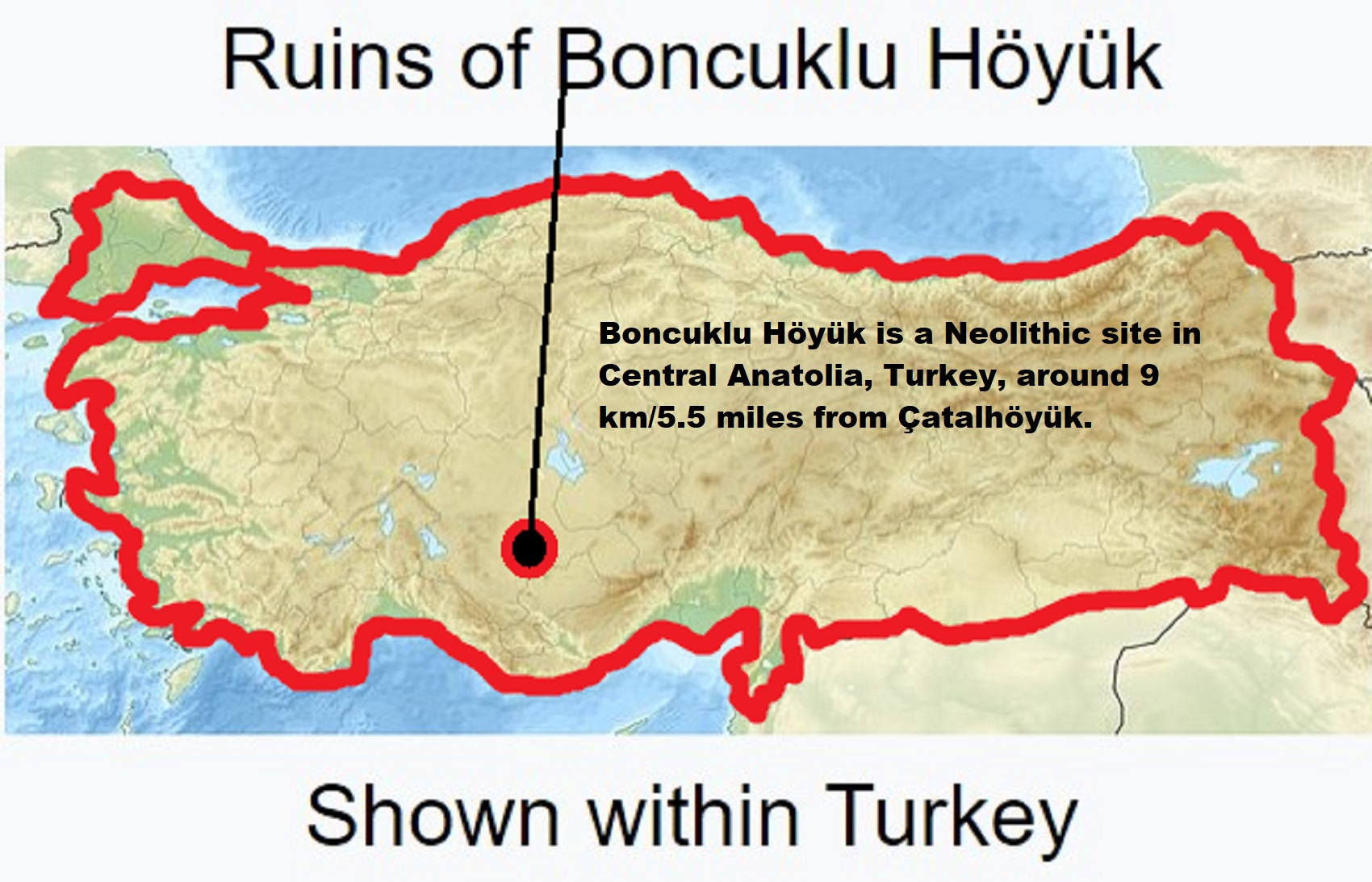
“Boncuklu Höyük is a Neolithic site in Central Anatolia, Turkey, around 9 km/5.5 miles from Çatalhöyük.” ref
“12 fired clay samples and an unfired marl sample from the late 9th and early 8th-millennium BCE site of Boncuklu Höyük (8300–7800 cal BCE) in the Konya Plain, Turkey, were analyzed by optical microscopy and SEM-EDX. The plant remains in the pottery fabrics were also examined in the variable pressure scanning electron microscope. Chemical analyses show that the same clays were used for multiple purposes, and more than one type of raw material was used to make the fired clay objects examined. Only one sherd showed signs of having added temper. The presence of scattered organic remains in the fabrics also suggests that the clay was minimally processed. Although the minerals present do not show any optical alteration, the shrinkage of the plant matter and the discoloring of bone inclusions suggested that all but one sample were fired, albeit at a relatively low temperature. These sherds are therefore regarded as among the earliest ceramic vessels known in southwest Asia, although the manufacturing technique was different to that used to make the contemporaneous PPNB ceramics found at Kfar HaHoresh in Israel.” ref
“The clay vessels from Boncuklu Höyük, an early Neolithic site in central Anatolia. The site dates to c. 8300 to 7800 cal BCE, much earlier than the accepted date for the introduction of pottery in Anatolia, c. 7000 cal BCE. Thus the primary question is whether the clay vessels constitute true ceramics, i.e. were fired intentionally. Boncuklu Höyük appears to have been established on a rise within a wetland area. Evidence for the use of crop plants at Boncuklu is clearly present but sparse, and foraging was probably more important than farming. Seasonality proxies suggest that the site was occupied throughout the year, but the community may well have included more mobile groups that were absent at different times.” ref
“Excavation of several areas with a combined exposure of over 400 m2 has revealed houses with painted floors, bucrania, and clay and plaster relief decoration, predating similar practices at the nearby site of Çatalhöyük by about a millennium. A sequence of six buildings, reconstructed one above another, has been excavated in one area (Area K); as at Çatalhöyük, continuous reconstruction in the same place appears to have been important. The buildings at Boncuklu were c. 3 × 5 m and ellipsoidal with the walls made from mudbrick. The buildings showed evidence of ground-level entry, unlike at Çatalhöyük where entry was from the roof. As at Çatalhöyük, however, there is strong evidence for a highly structured use of internal space, and the presence of plaster installations and painting. Extensive midden deposits accumulated in open areas and were associated with hearths and lightweight structures that may have formed shelters for work areas.” ref
“The inhabitants of Boncuklu made a variety of objects from clay, including vessels, storage structures, figurines, and a large number of other geometric and amorphous objects. Seventy-seven fragments of fine and coarse clay vessels which can be assigned to the assemblage related to Neolithic phases of occupation at the site were recovered from the site by 2012. Circa one third of these are from securely stratified Neolithic contexts, from different parts of the sequences dated directly by C14. Around half of the stratified examples were isolated sherds within ashy midden deposits and found in areas outside buildings. Middens were associated with activities involving food preparation and consumption, which occurred both outside and inside buildings. Sherds were also found within buildings, mainly in the ‘dirty’ areas surrounding hearths. One sherd was found in a grave fill in a house, but seems to have been deposited unintentionally when the grave was closed. Given the early date of the site in terms of pottery use in southwest Asia, the main question discussed here is whether these vessels were fired or only sun-dried, and if they were fired, at what temperature?” ref
“Five potential categories of ware-types were identified: fine wares, coarse wares, structural wares, fired marl, and unfired marl. Two examples of fine wares were from open bowls with flat rim profiles, and diameters of 220 mm and 280 mm. Both rim fragments were decorated with lateral incised lines. Each showed breakage in a manner consistent with poorly smoothed and bonded coils. Coarse ware sherds were from open bowls, hole mouth pots, and jars. These were pinched, slab- or coil-built and all had rounded rims (diameters varied from 40 to 220 mm). For some examples, thin layers of clay were used to create the exterior surface. It was not always clear whether the fragments of structural wares were from large vessels, oven walls, or sections of storage bins, perhaps intentionally fired in situ to make them more robust.” ref
“Examples were coil- or slab-built, with well-smoothed outer and inner surfaces. Two sections of rim were found, one from an open bowl (diameter 320 mm) and one from a straight-necked jar (diameter 250 mm). The thickness of the walls suggests they were used for hot stone cooking, a technique that focuses on insulation rather than conduction. Other examples of structural wares may be derived from fire installations and thereby have been baked by default. Sherds incorporated into the base of hearths have been found in the midden area (Area M) at Boncuklu; possibly they increased thermal shock resistance and thereby the hearths’ use-life. It is unclear, however, if they were fired before their incorporation into the hearth or as a result of it.” ref
“Examples within the fired marl category were thought to be broken/detached sections of the basins and channels that have been found in situ on site. They may have helped to drain liquids and a light firing may have increased their durability. Similar ‘water-channels’ have been identified for the Pottery Neolithic phase at Tell Seker al-Aheimar. Many of the exterior surfaces were notably rough and pitted. Others showed plant impressions suggesting they may have been formed around or over basketry. Examples categorized as unfired marl were made in the same way with the same materials as the fired marl but not baked at all. No sections of rim were recovered, which is probably indicative of the friable nature of these objects. Thirteen samples were analyzed: a figurine fragment (BK15), two fragments of fine ware vessels (BK1, 2), two fragments of coarse ware vessels (BK4, 5), four examples of structural wares (BK6, 7, 9 and 10); three fragments of fired marl (BK11, 12 and 13) and a section of unfired marl (BK14).” ref
“Boncuklu Höyük in Central Anatolia, Turkey, situated around 9 km from the more famous Çatalhöyük site, the remains of one of the world’s oldest villages, occupied between around 8300 to 7800 BCE. The buildings are small and oval-shaped with walls constructed of mudbricks. The remains of burials of human bodies were found below the floors of the buildings. The earliest known ceramics of Anatolia have been discovered there.” ref
“Çatalhöyük is a tell of a very large Neolithic and Chalcolithic proto-city settlement in southern Anatolia, which existed from approximately 7500 BC to 6400 BCE, and flourished around 7000 BCE. Çatalhöyük was composed entirely of domestic buildings, with no obvious public buildings. While some of the larger ones have rather ornate murals, the purpose of some rooms remains unclear. The population of the eastern mound has been estimated to be around 10,000 people, but the population likely varied over the community’s history. An average population of between 5,000 and 7,000 is a reasonable estimate.” ref
“Ceramics have always played a prominent role in archaeological material culture studies. Ceramic production represents the earliest chemical and physical transformation process deliberately operated by humans dating to 12,000 years ago in the Sahel and southern part of the Sahara and has since been ubiquitous in archaeological sites. Arguably, no class of artifacts has been as versatile as pottery in understanding human behavior. On the one hand, a pot is an object of daily use, relatively simple in form and very tangible. On the other hand, even an ordinary vessel concentrates human creativity, technological awareness, and social complexity.” ref
“Ceramic objects have been studied and interpreted from several perspectives, for their aesthetic value, as tools having technological and functional meanings, and for their social and cultural significance. Theoretical approaches to the study of pottery are as diverse as geography, local research traditions, and archaeological premises and questions. For example, for several years, pottery studies in central, eastern, and southern Africa used ceramics as proxies for recognizing ethnic groups and linguistic identities—e.g., the spread of the Bantu language speakers. This approach has been criticized, and alternative directions have been offered.” ref
“In Near Eastern archaeology, the standardization and innovations in ceramic forming techniques, such as the potter’s wheel, have been used to understand the paths toward social complexity and urban expansion. Some other theoretical, conceptual, and methodological developments can be recognized worldwide. For example, pottery has been studied as a craft object focusing on the analysis of manufacturing processes. There are also studies emphasizing ceramic functions through use-wear and residue analyses for reconstructing foodway traditions and practices. Moreover, there are ceramic studies that privilege cultural encounters, networks, and dynamics of cultural hybridization. There has also been an increasing application of hard science methods to archaeological material in general and ceramics in particular.” ref
“In Sudan, the earliest ceramics date from the mid-ninth millennium BC and come from Site 2-R-66—Amara West, northern Upper Nubia; Busharia I—Kerma, Upper Nubia; and Sorourab II—central Sudan. The early pottery in the region was produced by sedentary or semi-sedentary hunter-gatherers or pre-pastoral groups, who settled in the mosaic ecological environments of the early Holocene (c. 10,000–6300 BCE) that developed at the onset of the humid period. During this time, in the northernmost parts of the Sudanese Nile Valley (e.g., Sai Island, in northern Upper Nubia), precipitations occurred during the winter months and hunter-gatherers settled in an open savannah type of vegetation with seasonal fresh water.” ref
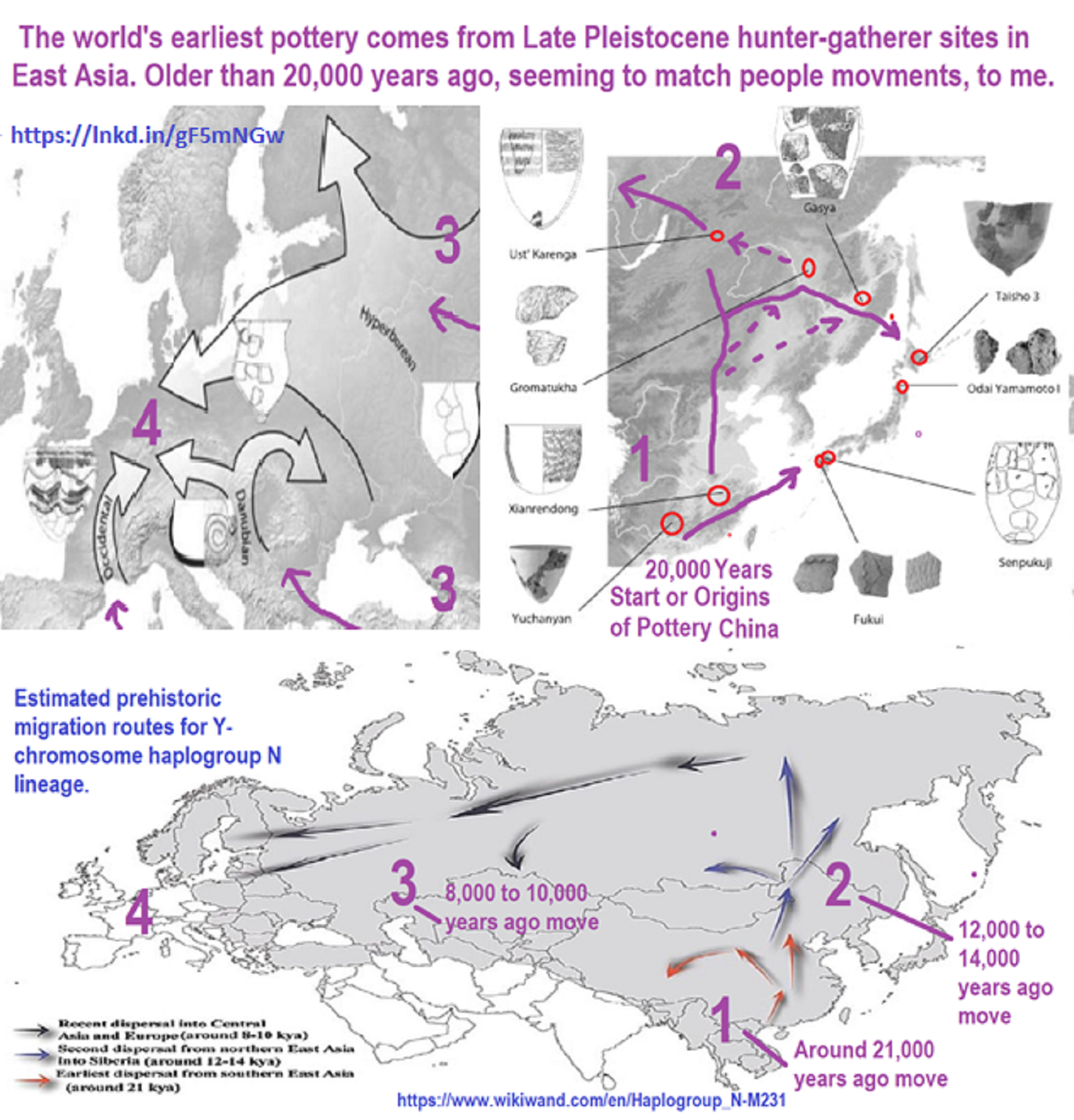
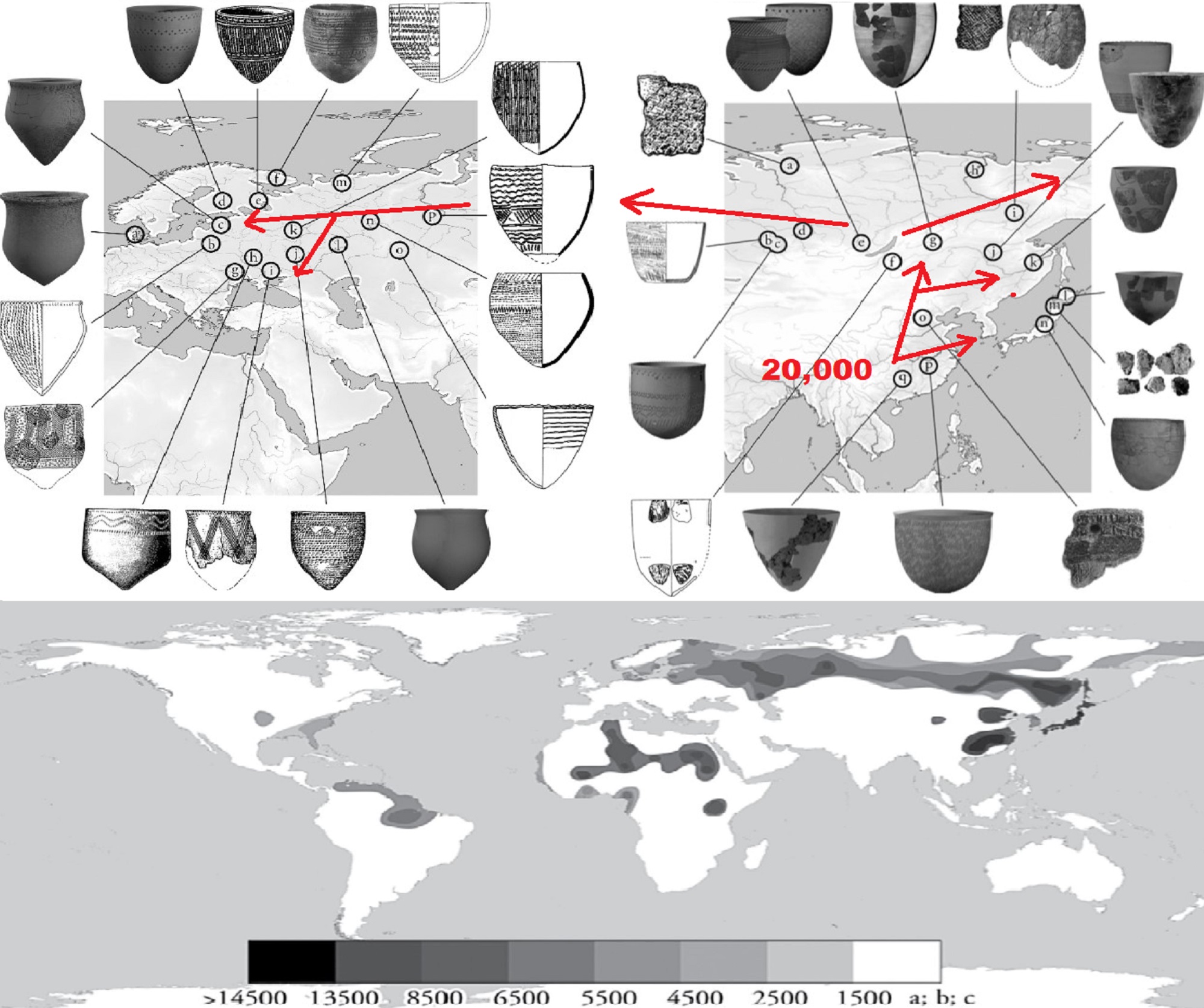
Pic ref
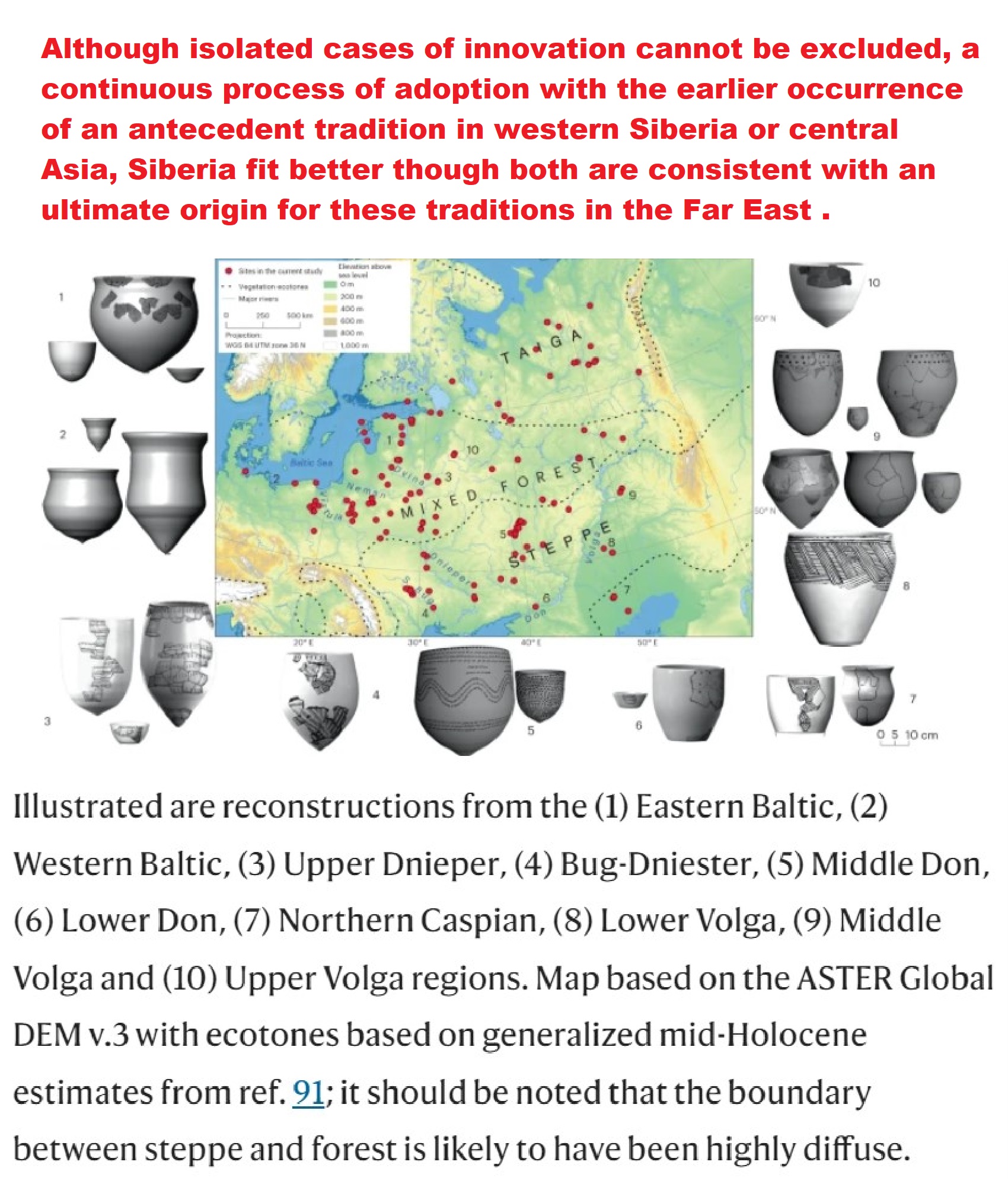
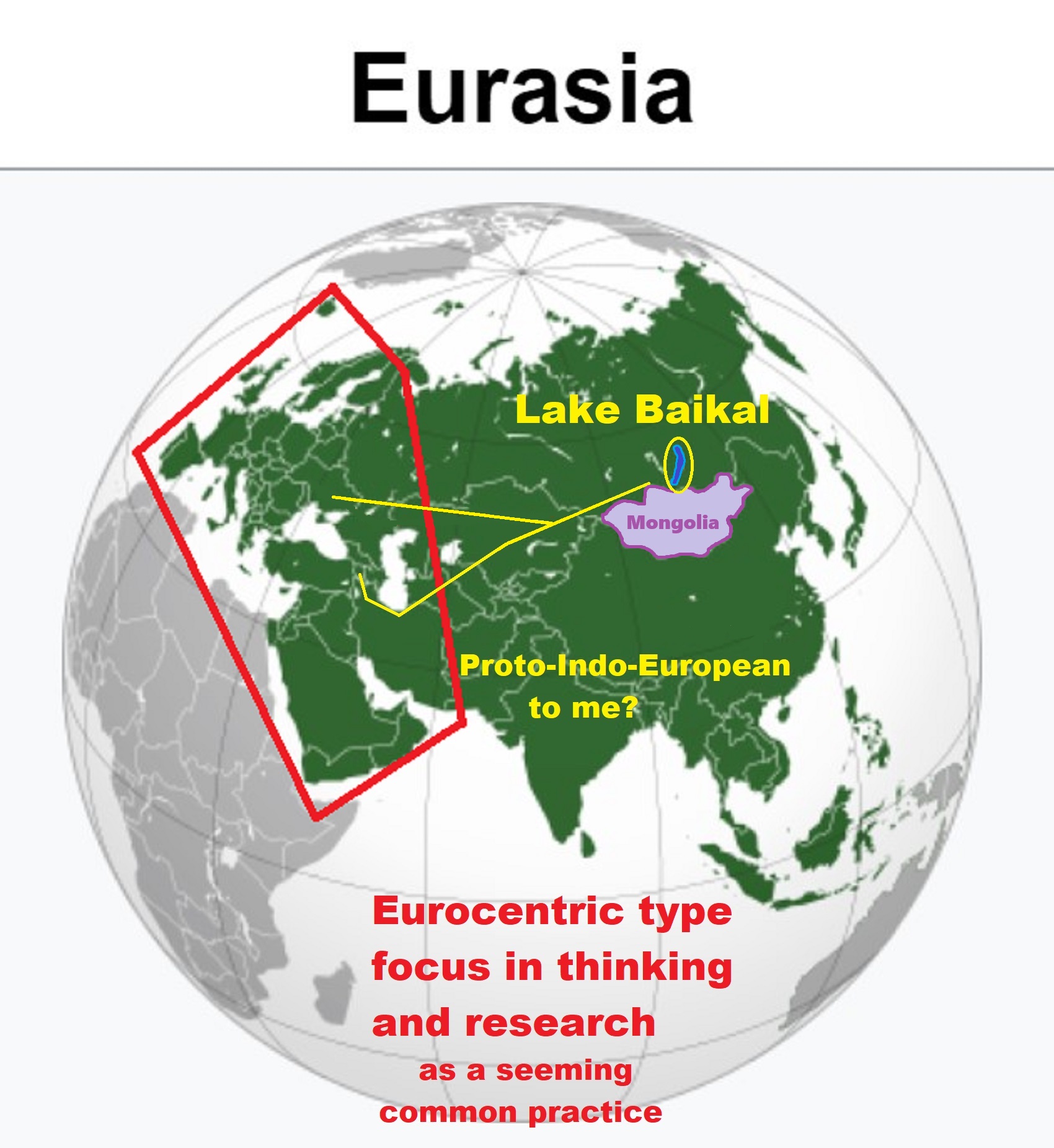
Origins of ‘Transeurasian’ languages traced to Neolithic millet farmers in north-eastern China about 9,000 years ago
“A study combining linguistic, genetic, and archaeological evidence has traced the origins of a family of languages including modern Japanese, Korean, Turkish and Mongolian and the people who speak them to millet farmers who inhabited a region in north-eastern China about 9,000 years ago. The findings outlined on Wednesday document a shared genetic ancestry for the hundreds of millions of people who speak what the researchers call Transeurasian languages across an area stretching more than 5,000 miles (8,000km).” ref
“Millet was an important early crop as hunter-gatherers transitioned to an agricultural lifestyle. There are 98 Transeurasian languages, including Korean, Japanese, and various Turkic languages in parts of Europe, Anatolia, Central Asia, and Siberia, various Mongolic languages, and various Tungusic languages in Manchuria and Siberia. This language family’s beginnings were traced to Neolithic millet farmers in the Liao River valley, an area encompassing parts of the Chinese provinces of Liaoning and Jilin and the region of Inner Mongolia. As these farmers moved across north-eastern Asia over thousands of years, the descendant languages spread north and west into Siberia and the steppes and east into the Korean peninsula and over the sea to the Japanese archipelago.” ref
“Eurasiatic is a proposed language with many language families historically spoken in northern, western, and southern Eurasia; which typically include Altaic (Mongolic, Tungusic, and Turkic), Chukchi-Kamchatkan, Eskimo–Aleut, Indo-European, and Uralic.” ref
“Voiced stops such as /d/ occur in the Indo-European, Yeniseian, Turkic, Mongolian, Tungusic, Japonic and Sino-Tibetan languages. They have also later arisen in several branches of Uralic.” ref
“Uralo-Siberian is a hypothetical language family of Uralic, Yukaghir, Eskimo–Aleut and besides linguistic evidence, several genetic studies, support a common origin in Northeast Asia.” ref

Ancient North Eurasian (ANE)
Ancient Beringian/Ancestral Native American (AB/ANA)
Eastern Hunter-Gatherer (EHG)
Western Hunter-Gatherers (WHG)
Western Steppe Herders (WSH)
Scandinavian Hunter-Gatherer (SHG)
Early European Farmers (EEF)
Jōmon people (Ainu people OF Hokkaido Island)
Neolithic Iranian farmers (Iran_N) (Iran Neolithic)
Haplogroup R possible time of origin about 27,000 years in Central Asia, South Asia, or Siberia:
- Mal’ta–Buret’ culture (24,000-15,000 years ago)
- Afontova Gora culture (21,000-12,000 years ago)
- Trialetian culture (16,000–8000 years ago)
- Samara culture (7,000-6,500 years ago)
- Khvalynsk culture (7,000-6,500 years ago)
- Afanasievo culture (5,300-4,500 years ago)
- Yamna/Yamnaya Culture (5,300-4,500 years ago)
- Andronovo culture (4,000–2,900 years ago) ref
Groups partially derived from the Ancient North Eurasians
“The ANE lineage is defined by association with the MA-1, or “Mal’ta boy”, remains of 24,000 years ago in central Siberia Mal’ta-Buret’ culture 24,000-15,000 years ago. The Ancient North Eurasians (ANE) samples (Afontova Gora 3, Mal’ta 1, and Yana-RHS) show evidence for minor gene flow from an East Asian-related group (simplified by the Amis, Han, or Tianyuan) but no evidence for ANE-related geneflow into East Asians (Amis, Han, Tianyuan), except the Ainu, of North Japan.” ref
“The ANE lineage is defined by association with the MA-1, or “Mal’ta boy”, remains of 24,000 years ago in central Siberia Mal’ta-Buret’ culture 24,000-15,000 years ago “basal to modern-day Europeans”. Some Ancient North Eurasians also carried East Asian populations, such as Tianyuan Man.” ref
“Bronze-age-steppe Yamnaya and Afanasevo cultures were ANE at around 50% and Eastern Hunter-Gatherer (EHG) at around 75% ANE. Karelia culture: Y-DNA R1a-M417 8,400 years ago, Y-DNA J, 7,200 years ago, and Samara, of Y-haplogroup R1b-P297 7,600 years ago is closely related to ANE from Afontova Gora, 18,000 years ago around the time of blond hair first seen there.” ref
Ancient North Eurasian
“In archaeogenetics, the term Ancient North Eurasian (often abbreviated as ANE) is the name given to an ancestral West Eurasian component that represents descent from the people similar to the Mal’ta–Buret’ culture and populations closely related to them, such as from Afontova Gora and the Yana Rhinoceros Horn Site. Significant ANE ancestry are found in some modern populations, including Europeans and Native Americans.” ref
“The ANE lineage is defined by association with the MA-1, or “Mal’ta boy“, the remains of an individual who lived during the Last Glacial Maximum, 24,000 years ago in central Siberia, Ancient North Eurasians are described as a lineage “which is deeply related to Paleolithic/Mesolithic hunter-gatherers in Europe,” meaning that they diverged from Paleolithic Europeans a long time ago.” ref
“The ANE population has also been described as having been “basal to modern-day Europeans” but not especially related to East Asians, and is suggested to have perhaps originated in Europe or Western Asia or the Eurasian Steppe of Central Asia. However, some samples associated with Ancient North Eurasians also carried ancestry from an ancient East Asian population, such as Tianyuan Man. Sikora et al. (2019) found that the Yana RHS sample (31,600 BP) in Northern Siberia “can be modeled as early West Eurasian with an approximately 22% contribution from early East Asians.” ref
“Populations genetically similar to MA-1 were an important genetic contributor to Native Americans, Europeans, Central Asians, South Asians, and some East Asian groups, in order of significance. Lazaridis et al. (2016:10) note “a cline of ANE ancestry across the east-west extent of Eurasia.” The ancient Bronze-age-steppe Yamnaya and Afanasevo cultures were found to have a noteworthy ANE component at ~50%.” ref
“According to Moreno-Mayar et al. 2018 between 14% and 38% of Native American ancestry may originate from gene flow from the Mal’ta–Buret’ people (ANE). This difference is caused by the penetration of posterior Siberian migrations into the Americas, with the lowest percentages of ANE ancestry found in Eskimos and Alaskan Natives, as these groups are the result of migrations into the Americas roughly 5,000 years ago.” ref
“Estimates for ANE ancestry among first wave Native Americans show higher percentages, such as 42% for those belonging to the Andean region in South America. The other gene flow in Native Americans (the remainder of their ancestry) was of East Asian origin. Gene sequencing of another south-central Siberian people (Afontova Gora-2) dating to approximately 17,000 years ago, revealed similar autosomal genetic signatures to that of Mal’ta boy-1, suggesting that the region was continuously occupied by humans throughout the Last Glacial Maximum.” ref
“The earliest known individual with a genetic mutation associated with blonde hair in modern Europeans is an Ancient North Eurasian female dating to around 16000 BCE from the Afontova Gora 3 site in Siberia. It has been suggested that their mythology may have included a narrative, found in both Indo-European and some Native American fables, in which a dog guards the path to the afterlife.” ref
“Genomic studies also indicate that the ANE component was introduced to Western Europe by people related to the Yamnaya culture, long after the Paleolithic. It is reported in modern-day Europeans (7%–25%), but not of Europeans before the Bronze Age. Additional ANE ancestry is found in European populations through paleolithic interactions with Eastern Hunter-Gatherers, which resulted in populations such as Scandinavian Hunter-Gatherers.” ref
“The Ancient North Eurasians (ANE) split from the ancestors of European peoples somewhere in the Middle East or South-central Asia, and used a northern dispersal route through Central Asia into Northern Asia and Siberia. Genetic analyses show that all ANE samples (Afontova Gora 3, Mal’ta 1, and Yana-RHS) show evidence for minor gene flow from an East Asian-related group (simplified by the Amis, Han, or Tianyuan). In contrast, no evidence for ANE-related geneflow into East Asians (Amis, Han, Tianyuan), except the Ainu, was found.” ref
“Genetic data suggests that the ANE formed during the Terminal Upper-Paleolithic (36+-1,5ka) period from a deeply European-related population, which was once widespread in Northern Eurasia, and from an early East Asian-related group, which migrated northwards into Central Asia and Siberia, merging with this deeply European-related population. These population dynamics and constant northwards geneflow of East Asian-related ancestry would later gave rise to the “Ancestral Native Americans” and Paleosiberians, which replaced the ANE as dominant population of Siberia.” ref
Groups partially derived from the Ancient North Eurasians
“Eastern Hunter-Gatherer (EHG) is a lineage derived predominantly (75%) from ANE. It is represented by two individuals from Karelia, one of Y-haplogroup R1a-M417, dated c. 8.4 kya, the other of Y-haplogroup J, dated c. 7.2 kya; and one individual from Samara, of Y-haplogroup R1b-P297, dated c. 7.6 kya. This lineage is closely related to the ANE sample from Afontova Gora, dated c. 18 kya. After the end of the Last Glacial Maximum, the Western Hunter-Gatherers (WHG) and EHG lineages merged in Eastern Europe, accounting for early presence of ANE-derived ancestry in Mesolithic Europe. Evidence suggests that as Ancient North Eurasians migrated West from Eastern Siberia, they absorbed Western Hunter-Gatherers and other West Eurasian populations as well.” ref
“Caucasian Hunter-Gatherer (CHG) is represented by the Satsurblia individual dated ~13 kya (from the Satsurblia cave in Georgia), and carried 36% ANE-derived admixture. While the rest of their ancestry is derived from the Dzudzuana cave individual dated ~26 kya, which lacked ANE-admixture, Dzudzuana affinity in the Caucasus decreased with the arrival of ANE at ~13 kya Satsurblia.” ref
“Scandinavian Hunter-Gatherer (SHG) is represented by several individuals buried at Motala, Sweden ca. 6000 BC. They were descended from Western Hunter-Gatherers who initially settled Scandinavia from the south, and later populations of EHG who entered Scandinavia from the north through the coast of Norway.” ref
“Iran Neolithic (Iran_N) individuals dated ~8.5 kya carried 50% ANE-derived admixture and 50% Dzudzuana-related admixture, marking them as different from other Near-Eastern and Anatolian Neolithics who didn’t have ANE admixture. Iran Neolithics were later replaced by Iran Chalcolithics, who were a mixture of Iran Neolithic and Near Eastern Levant Neolithic.” ref
“Ancient Beringian/Ancestral Native American are specific archaeogenetic lineages, based on the genome of an infant found at the Upward Sun River site (dubbed USR1), dated to 11,500 years ago. The AB lineage diverged from the Ancestral Native American (ANA) lineage about 20,000 years ago.” ref
“West Siberian Hunter-Gatherer (WSHG) are a specific archaeogenetic lineage, first reported in a genetic study published in Science in September 2019. WSGs were found to be of about 30% EHG ancestry, 50% ANE ancestry, and 20% to 38% East Asian ancestry.” ref
“Western Steppe Herders (WSH) is the name given to a distinct ancestral component that represents descent closely related to the Yamnaya culture of the Pontic–Caspian steppe. This ancestry is often referred to as Yamnaya ancestry or Steppe ancestry.” ref
“Late Upper Paeolithic Lake Baikal – Ust’Kyakhta-3 (UKY) 14,050-13,770 BP were mixture of 30% ANE ancestry and 70% East Asian ancestry.” ref
“Lake Baikal Holocene – Baikal Eneolithic (Baikal_EN) and Baikal Early Bronze Age (Baikal_EBA) derived 6.4% to 20.1% ancestry from ANE, while rest of their ancestry was derived from East Asians. Fofonovo_EN near by Lake Baikal were mixture of 12-17% ANE ancestry and 83-87% East Asian ancestry.” ref
“Hokkaido Jōmon people specifically refers to the Jōmon period population of Hokkaido in northernmost Japan. Though the Jōmon people themselves descended mainly from East Asian lineages, one study found an affinity between Hokkaido Jōmon with the Northern Eurasian Yana sample (an ANE-related group, related to Mal’ta), and suggest as an explanation the possibility of minor Yana gene flow into the Hokkaido Jōmon population (as well as other possibilities). A more recent study by Cooke et al. 2021, confirmed ANE-related geneflow among the Jōmon people, partially ancestral to the Ainu people. ANE ancestry among Jōmon people is estimated at 21%, however, there is a North to South cline within the Japanese archipelago, with the highest amount of ANE ancestry in Hokkaido and Tohoku.” ref
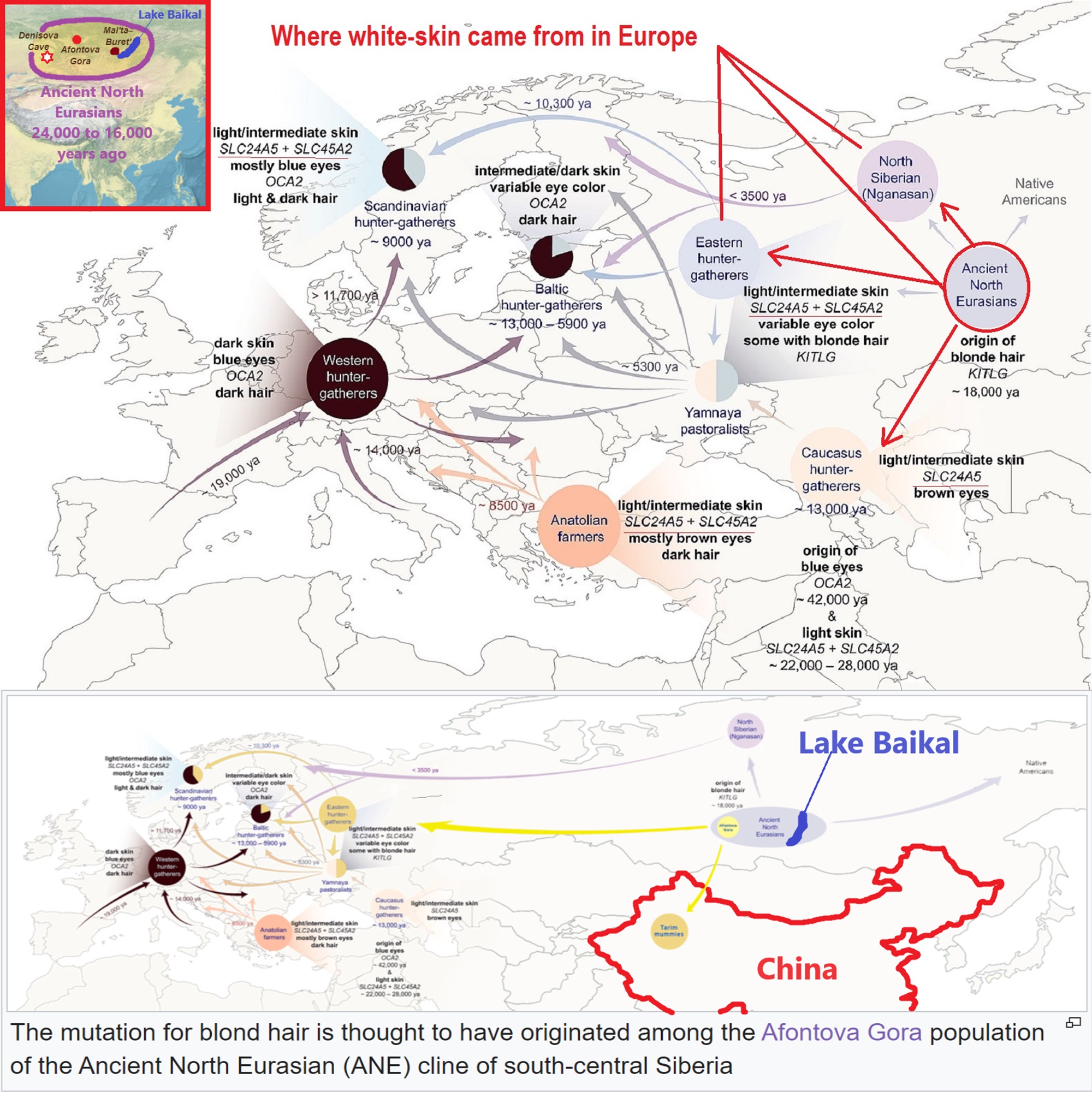
The Arrival of Siberian Ancestry Connecting the Eastern Baltic to Uralic Speakers further East
“Highlights:
-
Increase in hunter-gatherer ancestry in Bronze Age Eastern Baltic genomes
- Genetic input from Siberia to the Eastern Baltic during the transition to Iron Age
- Arrival of Siberian ancestry coincides with the proposed arrival of Uralic languages
- Light eyes, hair, and skin and lactose tolerance become frequent in the Bronze Age” ref
“In this study, we compare the genetic ancestry of individuals from two as yet genetically unstudied cultural traditions in Estonia in the context of available modern and ancient datasets: 15 from the Late Bronze Age stone-cist graves (1200–400 BCE) (EstBA) and 6 from the Pre-Roman Iron Age tarand cemeteries (800/500 BCE–50 CE) (EstIA). We also included 5 Pre-Roman to Roman Iron Age Ingrian (500 BCE–450 CE) (IngIA) and 7 Middle Age Estonian (1200–1600 CE) (EstMA) individuals to build a dataset for studying the demographic history of the northern parts of the Eastern Baltic from the earliest layer of Mesolithic to modern times. Our findings are consistent with EstBA receiving gene flow from regions with strong Western hunter-gatherer (WHG) affinities and EstIA from populations related to modern Siberians. The latter inference is in accordance with Y chromosome (chrY) distributions in present-day populations of the Eastern Baltic, as well as patterns of autosomal variation in the majority of the westernmost Uralic speakers. This ancestry reached the coasts of the Baltic Sea no later than the mid-first millennium BCE; i.e., in the same time window as the diversification of west Uralic (Finnic) languages. Furthermore, phenotypic traits often associated with modern Northern Europeans, like light eyes, hair, and skin, as well as lactose tolerance, can be traced back to the Bronze Age in the Eastern Baltic.” ref
“The Eastern Baltic has witnessed several population shifts since people reached its southern part during the Final Paleolithic ∼11,000–10,000 BCE and its northern part during the Mesolithic ∼9000 BCE. No genetic information is available from Paleolithic populations, but Mesolithic hunter-gatherers of the Kunda and Narva cultures were genetically most similar to Western hunter-gatherers (WHGs) widespread in Europe. A genetic shift toward Eastern hunter-gatherer (EHG) genetic ancestry occurred with the arrival of the Neolithic Comb Ceramic culture (CCC) people ∼3900 BCE. The Late Neolithic (LN) Corded Ware culture (CWC) people of Ponto-Caspian steppe origin brought farming into the Eastern Baltic ∼2800 BCE, contrary to most of Europe, where the Neolithic transition was mediated by Aegean early farmers. Human remains radiocarbon dated to the Early Bronze Age (ca. 1800–1200 BCE) are rare from this region, and no ancient DNA (aDNA) data are currently available. Genetic data from succeeding Bronze Age (BA) layers in Latvia and Lithuania indicate some genetic affinities with modern Eastern Baltic populations but also notable differences.” ref
“In this study, we present new genomic data from Estonian Late Bronze Age stone-cist graves (1200–400 BCE) (EstBA) and Pre-Roman Iron Age tarand cemeteries (800/500 BCE–50 CE) (EstIA). The cultural background of stone-cist graves indicates strong connections both to the west and the east. The Iron Age (IA) tarands have been proposed to mirror “houses of the dead” found among Uralic peoples of the Volga-Kama region. As this time window matches the proposed diversification period of western Uralic languages and the arrival of Proto-Finnic language in the Eastern Baltic from the east, our study considers linguistic, archaeological, and genetic data to inform on this. One of the most notable genetic features of Eastern Baltic populations is a high frequency of Y chromosome (chrY) haplogroup (hg) N3a (nomenclature of Karmin et al.), a characteristic shared mostly with Finno-Ugric-speaking groups in Europe and several populations all over Siberia. The rapid expansion of people carrying these lineages likely took place within the last 5,000 years, but their arrival time in the Eastern Baltic remains unresolved. The gene flow from Siberia to western-Uralic-speaking populations has also recently been inferred using autosomal data. However, available aDNA data have not revealed chrY hg N lineages in Eastern Baltic individuals.” ref
“To characterize the genetic ancestry of people from the so-far-unstudied cultural layers, we extracted DNA from the tooth roots of 56 individuals (Figure 1A; Table S1; STAR Methods). No individuals were included from later IA in Estonia because people were mostly cremated during that period. Individuals morphologically sexed as males were prioritized in sampling to make comparisons using autosomal and both sex chromosomes. We shotgun sequenced all samples and they formed 3 groups: (1) 15 with low endogenous DNA content and resulting coverage, which were excluded from further analyses; (2) 8 with sufficient mtDNA (and in some cases, chrY) coverage for determining hgs, but not for informative autosomal analyses; and (3) 33 that yielded sufficient autosomal data for informative analyses. The 33 individuals included 15 from EstBA, 6 from EstIA, 5 from Pre-Roman to Roman Iron Age Ingria (500 BCE–450 CE) (IngIA), and 7 from Middle Age Estonia (1200–1600 CE) (EstMA) and yielded endogenous DNA ∼4%–88%, average genomic coverages ∼0.017–0.734×, and contamination estimates <4% (Table S1). We analyzed the data in the context of modern and other ancient individuals, including from Neolithic Estonia.” ref
“We identified chrY hgs for 30 male individuals (Tables 1 and S2; STAR Methods). All 16 successfully haplogrouped EstBA males belonged to hg R1a, showing no change from the CWC period, when this was also the only chrY lineage detected in the Eastern Baltic. Three EstIA and two IngIA individuals also belonged to hg R1a, but three EstIA males belonged to hg N3a, the earliest so far observed in the Eastern Baltic. Three EstMA individuals belonged to hg N3a, two to hg R1a, and one to hg J2b. ChrY lineages found in the Baltic Sea region before the CWC belong to hgs I, R1b, R1a5, and Q. Thus, it appears that these lineages were substantially replaced in the Eastern Baltic by hg R1a, most likely through steppe migrations from the east. Although we did not detect N3a chrYs in our BA sample, unlike in BA Fennoscandia, we cannot rule out its presence due to small sample size. However, the frequency should not exceed 0.17 with 95% and 0.25 with 99% confidence. The frequency of hg N3a was significantly higher in our IA than our BA group (Fisher’s exact test p value 0.013). Our results enable us to conclude that, although the expansion time for R1a1 and N3a3′5 in Eastern Europe is similar, hg N3a likely reached Estonia or at least became comparably frequent to modern Estonia only during the BA-IA transition.” ref
“To assess whether the Eastern Eurasian influence indicated by chrY hg N3a is apparent elsewhere in the genome, we first applied principal-component analysis (PCA). We projected ancient genomes from previous studies (Table S3) and this study on two axes inferred using Estonian Biocenter Illumina genotyping array data (EBC-chipDB) of modern Western Eurasian individuals (Table S3) (Figure 1C). A clear shift toward West Eurasian hunter-gatherers is visible between European LN and BA (including Baltic CWC) and EstBA individuals, the latter clustering together with Latvian and Lithuanian BA individuals. EstIA, IngIA, and EstMA individuals project between BA individuals and modern Estonians, partially overlapping with both. We performed ADMIXTURE analysis by projecting aDNA data on worldwide EBC-chipDB modern data (Figures S1C and S1D; Table S3) and present results at K = 9 (Figures 1B, S1A, and S1B; STAR Methods). EstBA individuals are clearly distinguishable from Estonian CWC individuals as the former have more of the blue component most frequent in WHGs and less of the brown and yellow components maximized in Caucasus hunter-gatherers and modern Khanty, respectively. The individuals of EstBA, EstIA, IngIA, EstMA, and modern Estonia are quite similar to each other on average, indicating that the relatively high proportion of WHG ancestry in modern Eastern Baltic populations compared to other present-day Europeans traces back to the BA.” ref
“When comparing Estonian CWC and EstBA using autosomal outgroup f3 and Patterson’s D statistics (Table S3), the latter is more similar to other Baltic BA populations, to Baltic IA and Middle Age (MA) populations, and also to populations similar to WHGs and Scandinavian hunter-gatherers (SHGs), but not to Estonian CCC (Figures 2A and S2A; Data S1). The increase in WHG or SHG ancestry could be connected to western influences seen in material culture and facilitated by a decline in local population after the CCC-CWC period. A slight trend of bigger similarity of Estonian CWC to forest or steppe zone populations and of EstBA to European early farmer populations can also be seen. These differences remain when over 900,000 positions of the ‘1240k’ capture are used instead of ∼500,000 positions of the EBC-chipDB (Figure S2B; Data S1). When comparing to modern populations, Estonian CWC is slightly more similar to Caucasus individuals but EstBA to Baltic populations and Finnic speakers (Figure 2B; Data S1). Outgroup f3 and D statistics do not reveal apparent differences when comparing EstBA to EstIA, EstIA to IngIA, and EstIA to EstMA (Data S1). These results highlight how uniparental and autosomal data can lead to different demographic inferences—the genetic change between CWC and BA not seen in uniparental lineages is clear in autosomal data and the appearance of chrY hg N in the IA is not matched by a clear shift in autosomal profiles.” ref
“We imputed the genotypes of 37 phenotype informative SNVs from the HIrisPlex-S system, two from TLR1, and one from MCM6 gene and a 32-bp deletion (rs333) in the CCR5 gene for Mesolithic and Neolithic individuals from Latvia and Estonia and the individuals of this study. We inferred a sharp increase to >50% in the frequency of the lactase persistence variant (MCM6/rs4988235) in the Baltic area after the LN (Data S2), in line with previous indications of this variant becoming common in Europe in the last 4,000–3,500 years and of its fast increase in populations with steppe ancestry due to local adaptation. In contrast, the rs333, responsible for HIV resistance, which we first detect in a CWC individual, remains at 10%–25% frequency since then (Data S2), comparable to its present-day 14.8% frequency in Estonia. Both TLR1 variants involved in the protection against leprosy were already present in Europe at medium-high frequencies since the Mesolithic (Data S2). Notably, we infer a high proportion (40%–60%) of dark skin pigmentation in the hunter-gatherers and CWC farmers (Data S2). We infer dark skin and blue eyes for two individuals, similarly to another European Mesolithic individual. However, from BA onward, we infer pale or intermediate skin pigmentation for all individuals and an increase in the proportion of blue eyes and lighter shades of hair (Data S2). This is in line with previous suggestions that light skin pigmentation alleles reached high frequencies in Europe only recently.” ref
Conclusions
“We show that a component of possibly Siberian ancestry was added to the gene pool of the Eastern Baltic during the Bronze to Iron Age transition at the latest. This component is present in the autosomes and chrY of many northeastern European Uralic-speaking populations today but arrived in the Eastern Baltic probably later than 3,500 years ago (ya), when it reached Fennoscandia. Considering the archaeological context of the individuals, this seems to have followed the so-called southwestern route from the Volga-Ural region. Notably, the Bronze to Iron Age transition period also coincides with the hypothesized arrival of westernmost Uralic (Finnic) languages in the Eastern Baltic, supporting the idea that the spread of these languages was mediated by IA migrants from the east. The EstBA individuals of this study, as other Baltic BA individuals, display more WHG ancestry compared to both earlier CWC and modern Estonians. Interestingly, we do not detect this change in their uniparental lineages. However, half of the admittedly small EstIA sample and over one-third of modern Estonian men share a hg N3a chrY—common in other Uralic-speaking populations living much further east and not found in the Eastern Baltic earlier—although the autosomes of EstIA individuals only show 3%–5% Siberian ancestry on average. Furthermore, phenotypic characteristics often associated with modern Northern Europeans (light eyes, hair, and skin pigmentation, and lactose tolerance) can be traced back to the Bronze Age in the Eastern Baltic.” ref
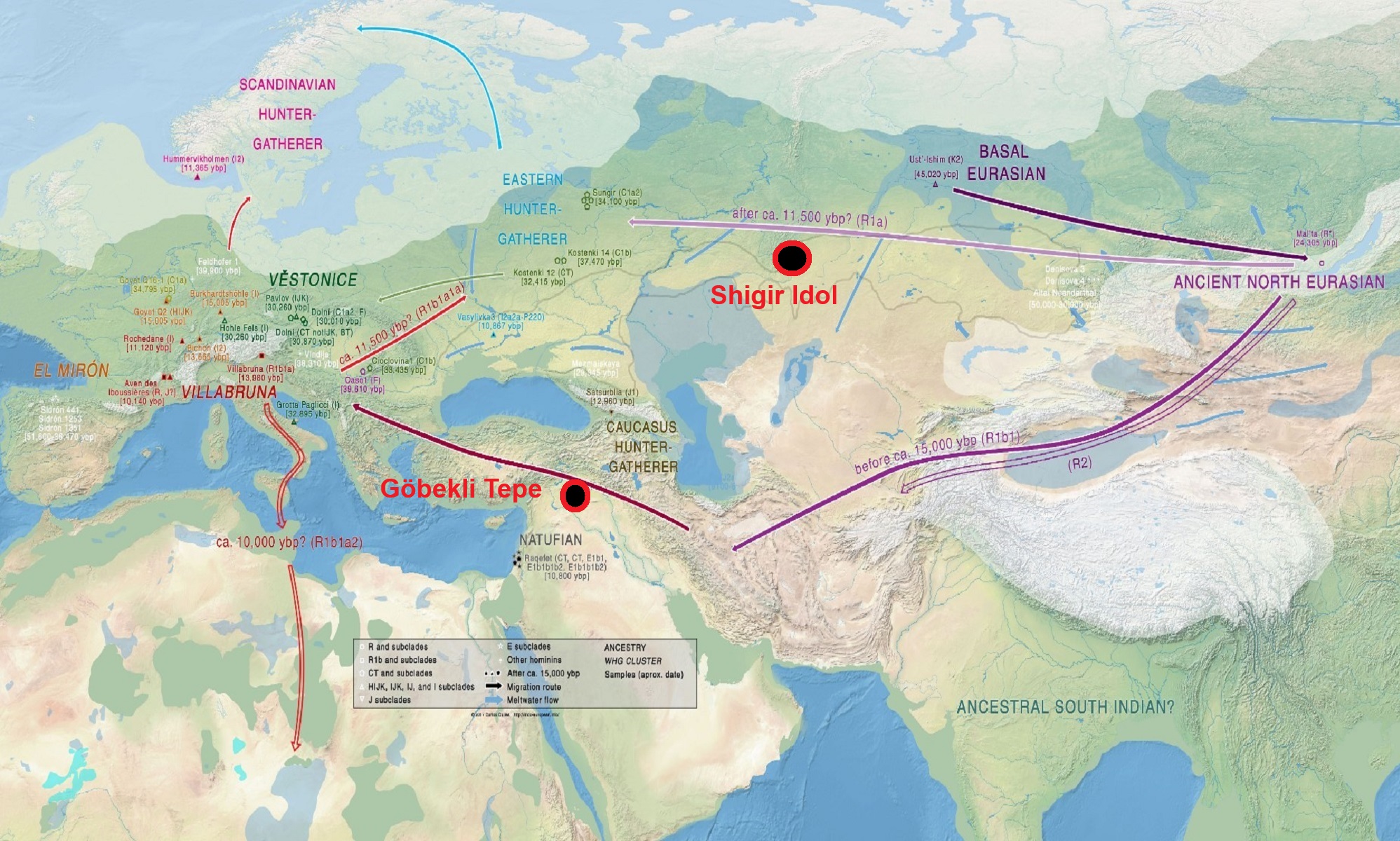
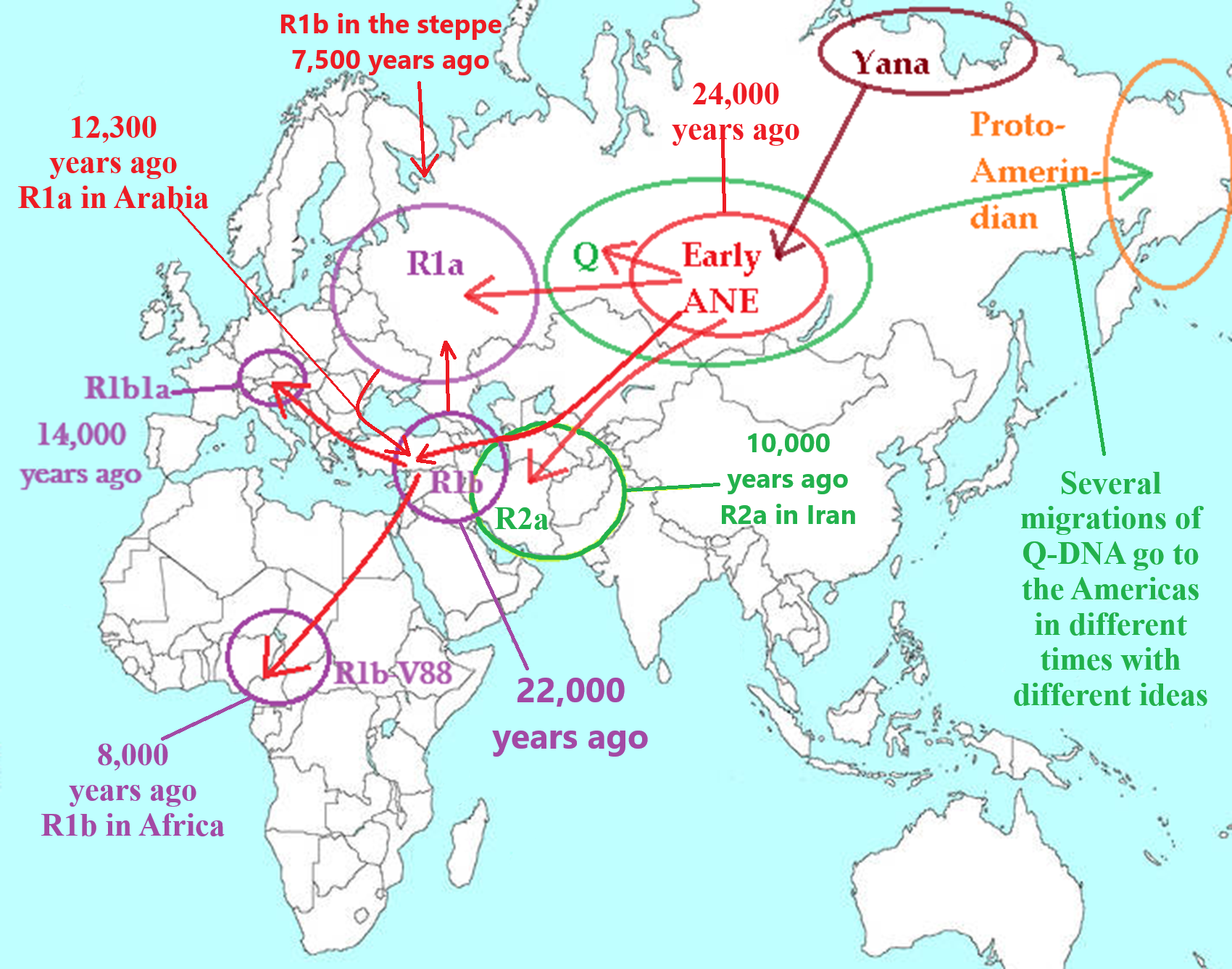
Haplogroup migrations related to the Ancient North Eurasians: I added stuff to this map to help explain.
People reached Lake Baikal Siberia around 25,000 years ago. They (to Damien) were likely Animistic Shamanists who were also heavily totemistic as well. Being animistic thinkers they likely viewed amazing things in nature as a part of or related to something supernatural/spiritual (not just natural as explained by science): spirit-filled, a sprit-being relates to or with it, it is a sprit-being, it is a supernatural/spiritual creature, or it is a great spirit/tutelary deity/goddess-god. From there comes mythology and faith in things not seen but are believed to somehow relate or interact with this “real world” we know exists.
Both areas of Lake Baikal, one on the west side with Ancient North Eurasian culture and one on the east side with Ancient Northern East Asian culture (later to become: Ancient Northeast Asian culture) areas are the connected areas that (to Damien) are the origin ancestry religion area for many mythologies and religious ideas of the world by means of a few main migrations and many smaller ones leading to a distribution of religious ideas that even though are vast in distance are commonly related to and centering on Lake Baikal and its surrounding areas like the Amur region and Altai Mountains region.
To an Animistic Thinker: “Things are not just as they seem, they may have a spirit, or spirit energy relates to them”
To a Totemistic Thinker: “Things are not just as they seem, they may have a spirit, or spirit energy relates to them; they may have religio-cultural importance.”
“Ancient North Eurasian population had Haplogroups R, P, U, and Q DNA types: defined by maternal West-Eurasian ancestry components (such as mtDNA haplogroup U) and paternal East-Eurasian ancestry components (such as yDNA haplogroup P1 (R*/Q*).” ref
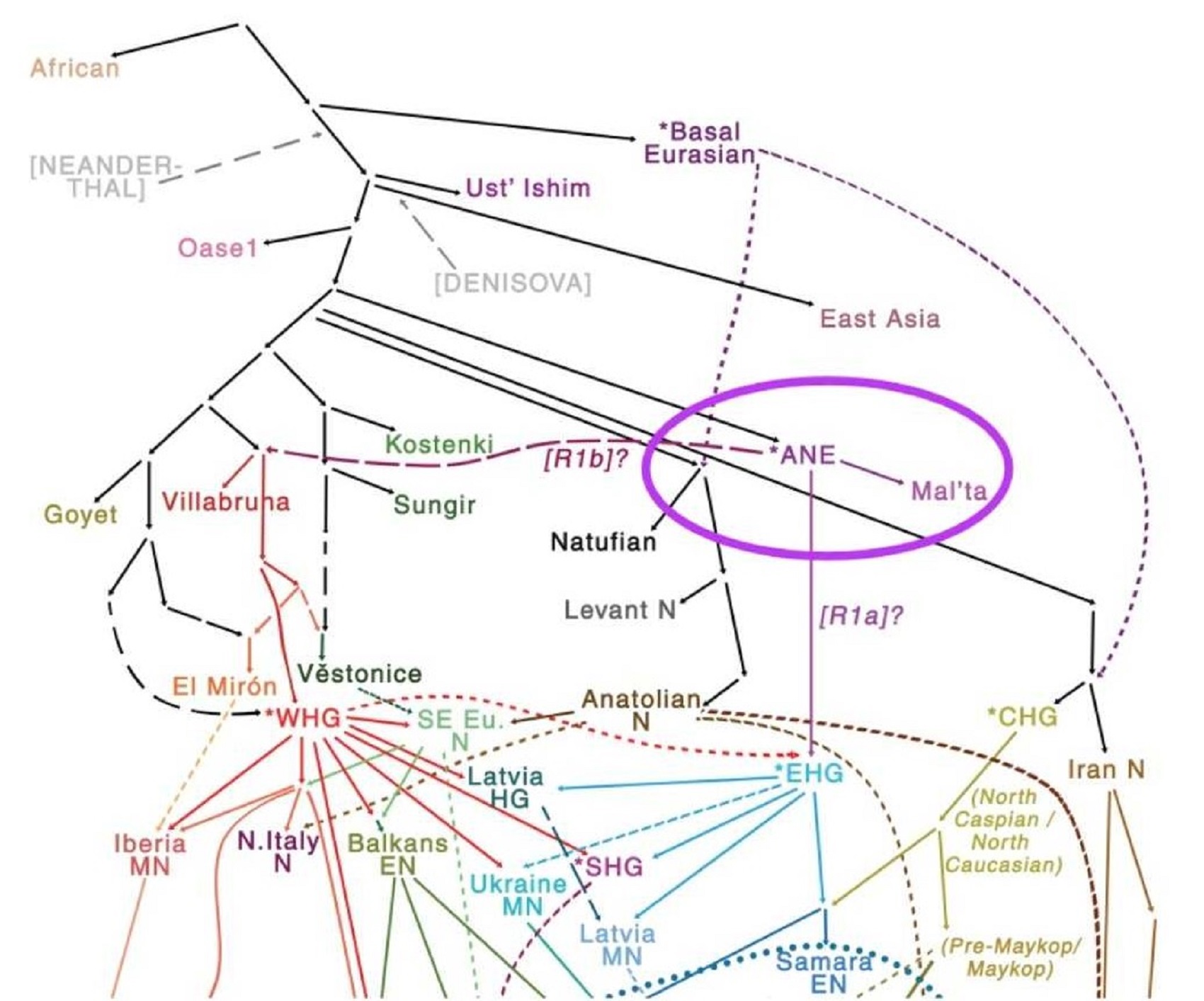
Haplogroup “R” Y-DNA Migrations
To me, there are at least three main migrations of Haplogroup “R” Y-DNA from Siberia to the Middle East areas. First was R1b Y-DNA at 22,000 years ago; next was R1a Y-DNA at 12,300 years ago in Arabia; and last was R2a Y-DNA at 10,000 years ago in Iran Neolithic.
1. R1b in the Middle East areas 22,000 years ago
2. R1a in Arabia 12,300 years ago
3. R2a in Iran 10,000 years ago
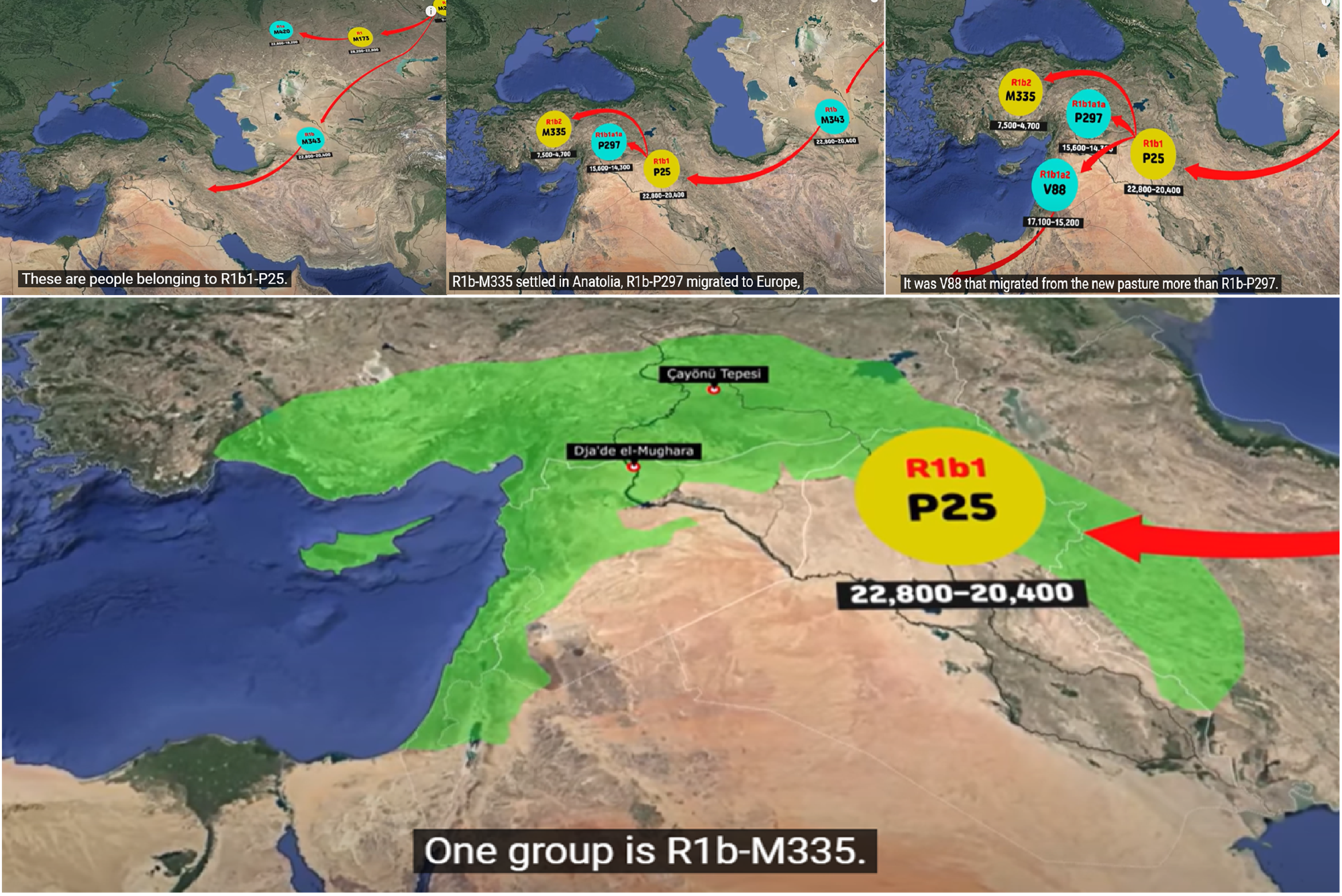
“Rb1-V88 around 8,000 years ago. R1b-V88 coalescence time was estimated between 9,200–5,600 years ago. Researchers suggest R1b-V88 is a paternal genetic record of the proposed mid-Holocene migration of proto-Chadic Afroasiatic speakers through the Central Sahara into the Lake Chad Basin, and geomorphological evidence is consistent with this view.” ref
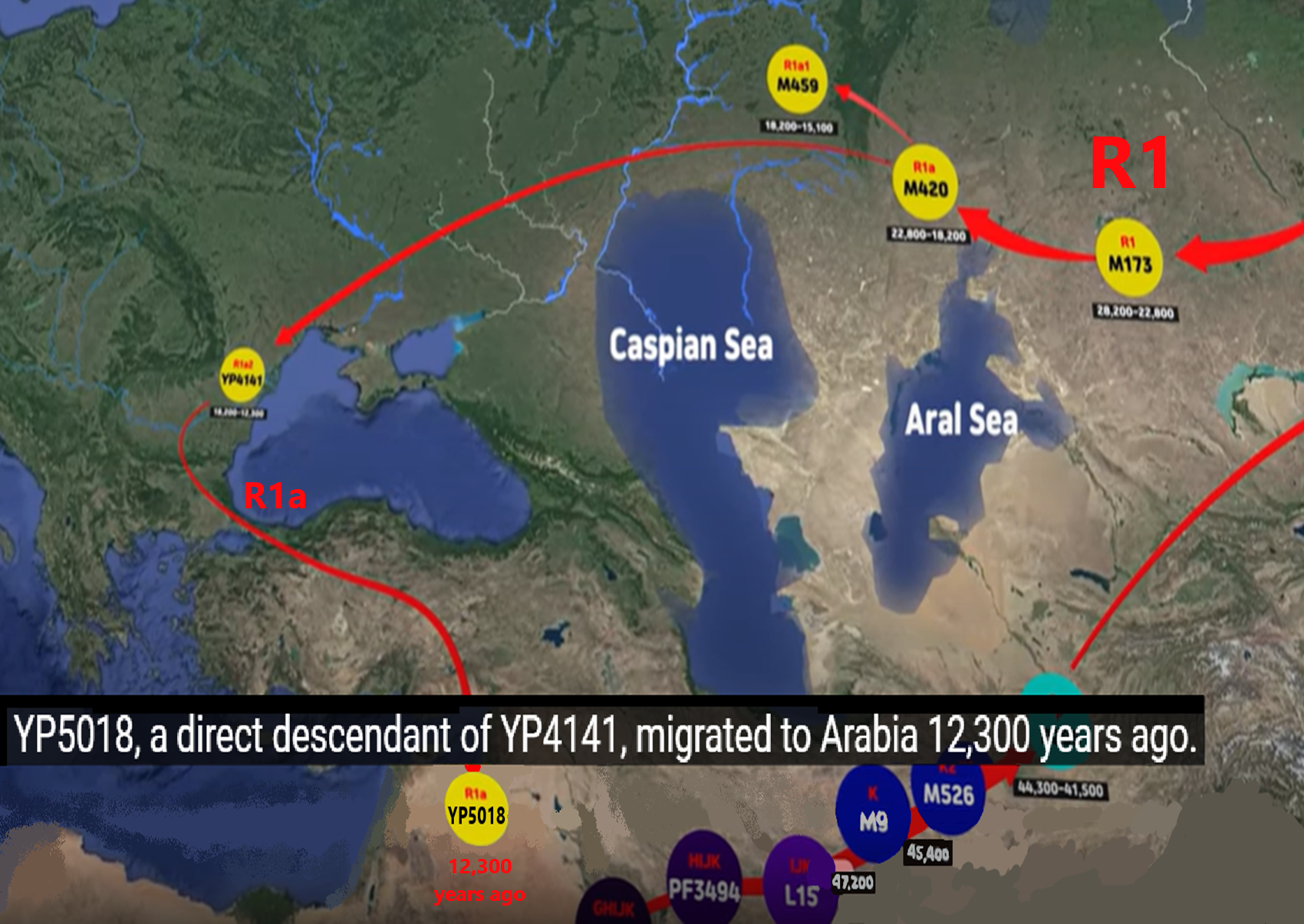

“Haplogroup R2a (R-M124) is characterized by SNPs M124, F820/Page4, L381, P249, and is mainly found in South Asia, with lower frequencies in Central Asia. R-M124 is also found in multiple Jewish populations: Iraqi Jews, Persian Jews, Mountain Jews, and Ashkenazi Jews. Most research has tested only for the presence of R-M479 (R2) and R-M124 (R2a) – or SNPs downstream from M124 like P249, P267, L266, PAGES00004, and L381 SNPs). Because the other primary branch, R2b (R-FGC21706) was discovered later than R2a, it has often not been tested for. Hence most results are best described as R2(xR2a). n addition, relatively little research has been done within South Asia, which is known to have the greatest concentration of R2. (Hence the figures cited in the table right may not be indicative of true frequencies, i.e. Pakistan is the only South Asian country that has been included.) In 2013, R2(xR2a) was found in 5 out of 19 males from the Burusho minority of North Pakistan. Haplogroup R2, or R-M479, has been concentrated geographically in South Asia and Central Asia since prehistory. It appears to reach its highest levels among the Burusho people in North Pakistan.” ref
Ganj Dareh
“The oldest settlement remains on the site date back to ca. 10,000 years ago, and have yielded the earliest evidence for goat domestication in the world. The only evidence for domesticated crops found at the site so far is the presence of two-row barley. Ganj Dareh is important in the study of Neolithic ceramics in Luristan and Kurdistan. This is a period beginning in the late 8th millennium, and continuing to the middle of the 6th millennium BCE. Also, the evidence from two other excavated sites nearby is important, from Tepe Guran, and Tepe Sarab (shown on the map in this article). They are all located southwest of Harsin, on the Mahidasht plain, and in the Hulailan valley.” ref
At Ganj Dareh, two early ceramic traditions are evident. One is based on the use of clay for figurines and small geometric pieces like cones and disks. These are dated ca. 7300-6900 BCE. The other ceramic tradition originated in the use of clay for mud-walled buildings (ca. 7300 BC). These traditions are also shared by Tepe Guran, and Tepe Sarab. Tepe Asiab is also located near Tepe Sarab, and may be the earliest of all these sites. Both sites appear to have been seasonally occupied. Another site from the same period is Chia Jani, also in Kermanshah. Chia Jani is located about 60 km southwest from Ganj Dareh. Ali Kosh is also a related site of the Neolithic period.” ref
“Researchers sequenced the genome from the petrous bone of a 30-50-year-old woman from Ganj Dareh, GD13a. mtDNA analysis shows that she belonged to Haplogroup X. She is phenotypically similar to the Anatolian early farmers and Caucasus Hunter-Gatherers. Her DNA revealed that she had black hair, brown eyes, and was lactose intolerant. The derived SLC45A2 variant associated with light skin was not observed in GD13a, but the derived SLC24A5 variant, which is also associated with the same trait, was observed. “GD13a is genetically closest to the ancient Caucasus hunter-gatherers identified from human remains from Georgia (Satsurblia Cave and Kotias Klde). She belonged to a population (Neolithic Iranians) that was genetically distinct from the Neolithic Anatolian farmers.” ref
“In terms of modern populations, she shows the relative highest genetic affinity with the Baloch people, Makran Baloch, and Brahui people. Also genetically close to GD13a were ancient samples from Steppe populations (Yamanya & Afanasievo) that were part of one or more Bronze Age migrations into Europe, as well as early Bronze Age cultures in that continent (Corded Ware) in line with previous relationships observed for the Caucasus Hunter-Gatherers. Most Neolithic Iranian specimens from Ganj Dareh were found to belong to the paternal haplogroup R2a. The to date oldest sample of haplogroup R2a was observed in the remains of a Neolithic human from Ganj Dareh in western Iran (c. 10,162 years old). A late Neolithic sample (I1671) was found to belong to Haplogroup G2a.” ref


ref, ref, ref, ref, ref, ref, ref, ref, ref, ref, ref, ref, ref, ref, ref, ref, ref, ref, ref
Here are my thoughts/speculations on where I believe is the possible origin of shamanism, which may have begun sometime around 35,000 to 30,000 years ago seen in the emergence of the Gravettian culture, just to outline his thinking, on what thousands of years later led to evolved Asian shamanism, in general, and thus WU shamanism as well. In both Europe-related “shamanism-possible burials” and in Gravettian mitochondrial DNA is a seeming connection to Haplogroup U. And the first believed Shaman proposed burial belonged to Eastern Gravettians/Pavlovian culture at Dolní Věstonice in southern Moravia in the Czech Republic, which is the oldest permanent human settlement that has ever been found. It is at Dolní Věstonice where approximately 27,000-25,000 years ago a seeming female shaman was buried and also there was an ivory totem portrait figure, seemingly of her.
And my thoughts on how cultural/ritual aspects were influenced in the area of Göbekli Tepe. I think it relates to a few different cultures starting in the area before the Neolithic. Two different groups of Siberians first from northwest Siberia with U6 haplogroup 40,000 to 30,000 or so. Then R Haplogroup (mainly haplogroup R1b but also some possible R1a both related to the Ancient North Eurasians). This second group added its “R1b” DNA of around 50% to the two cultures Natufian and Trialetian. To me, it is likely both of these cultures helped create Göbekli Tepe. Then I think the female art or graffiti seen at Göbekli Tepe to me possibly relates to the Epigravettians that made it into Turkey and have similar art in North Italy. I speculate that possibly the Totem pole figurines seen first at Kostenki, next went to Mal’ta in Siberia as seen in their figurines that also seem “Totem-pole-like”, and then with the migrations of R1a it may have inspired the Shigir idol in Russia and the migrations of R1b may have inspired Göbekli Tepe.
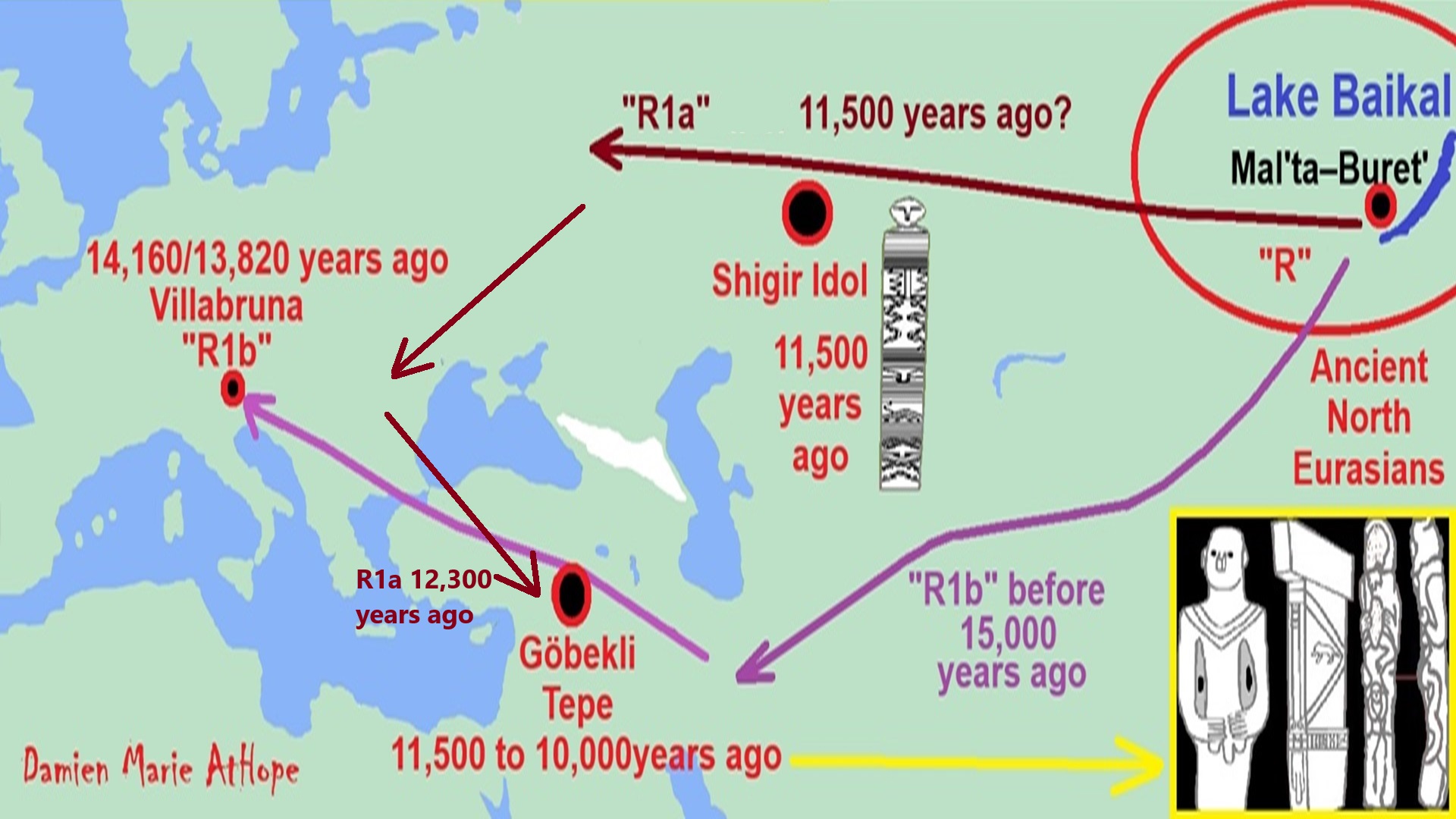

ref, ref, ref, ref, ref, ref, ref
Trialetian culture (16,000–8000 years ago) the Caucasus, Iran, and Turkey, likely involved in Göbekli Tepe. Migration 1?
Haplogroup R possible time of origin about 27,000 years in Central Asia, South Asia, or Siberia:
- Mal’ta–Buret’ culture (24,000-15,000 years ago)
- Afontova Gora culture (21,000-12,000 years ago)
- Trialetian culture (16,000–8000 years ago)
- Samara culture (7,000-6,500 years ago)
- Khvalynsk culture (7,000-6,500 years ago)
- Afanasievo culture (5,300-4,500 years ago)
- Yamna/Yamnaya Culture (5,300-4,500 years ago)
- Andronovo culture (4,000–2,900 years ago) ref
Trialetian sites
Caucasus and Transcaucasia:
- Edzani (Georgia)
- Chokh (Azerbaijan), layers E-C200
- Kotias Klde, layer B” ref
Eastern Anatolia:
- Hallan Çemi (from ca. 8.6-8.5k BC to 7.6-7.5k BCE)
- Nevali Çori shows some Trialetian admixture in a PPNB context” ref
Trialetian influences can also be found in:
- Cafer Höyük
- Boy Tepe” ref
Southeast of the Caspian Sea:
- Hotu (Iran)
- Ali Tepe (Iran) (from cal. 10,500 to 8,870 BCE)
- Belt Cave (Iran), layers 28-11 (the last remains date from ca. 6,000 BCE)
- Dam-Dam-Cheshme II (Turkmenistan), layers7,000-3,000 BCE)” ref


My Speculations are in Comparative Mythologies?
For instance, the mytheme of an ancient belief that is seemingly shared though changed and adapted, a fundamental generic unit of narrative structure seems to be shared a common relation with mountains/ancestors/gods or sacred animals with Sacred Mounds, Mountains, Kurgans, and Pyramids.
Sacred Mounds, Mountains, Kurgans, and Pyramids may hold deep Mythology connections?
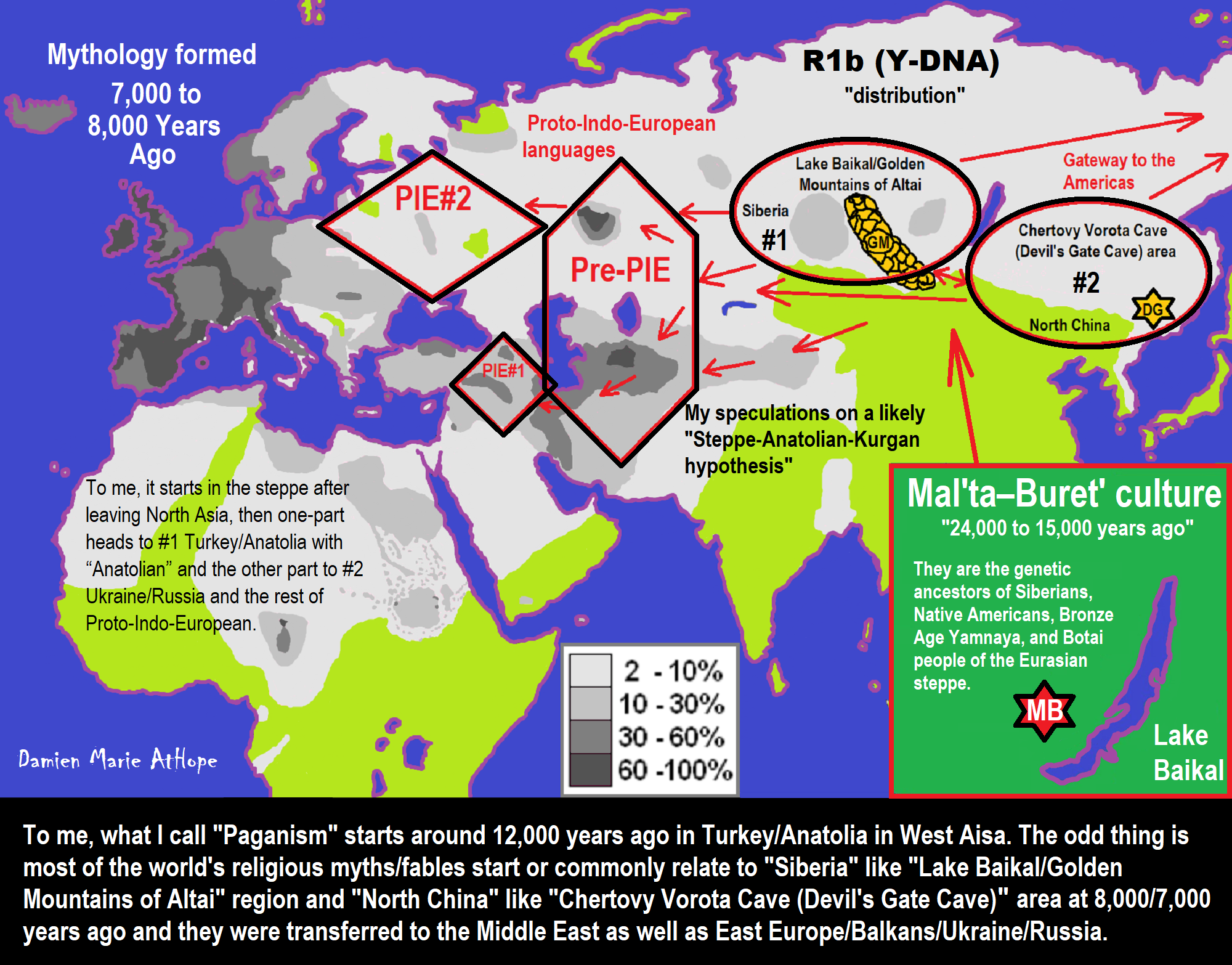
- My Thoughts on the Mal’ta–Buret’ culture‘s Ancient North Eurasian “R” (Y-DNA) Migrations and its Possible relations/influence on Afroasiatic and Proto-Indo-European languages
- My Thoughts on Possible Migrations of “R” DNA and Proto-Indo-European?
- Proto-Indo-European (PIE), ancestor of Indo-European languages: DNA, Society, Language, and Mythology
- Yamnaya culture or at least Proto-Indo-European Languages/Religions may actually relate back to North Asia?

ref, ref, ref, ref, ref, ref, ref, ref, ref, ref, ref, ref, ref, ref
- Indo-European language Trees fit an Agricultural expansion from Anatolia beginning 8,000 – 9,500 years ago?
- 7,020 to 6,020-year-old Proto-Indo-European Homeland of Urheimat or proposed home of their Language and Religion
- Understanding Proto-Indo-Europeans and Paganism Religions
- Hell and Underworld mythologies starting maybe as far back as 7,000 to 5,000 years ago with the Proto-Indo-Europeans?
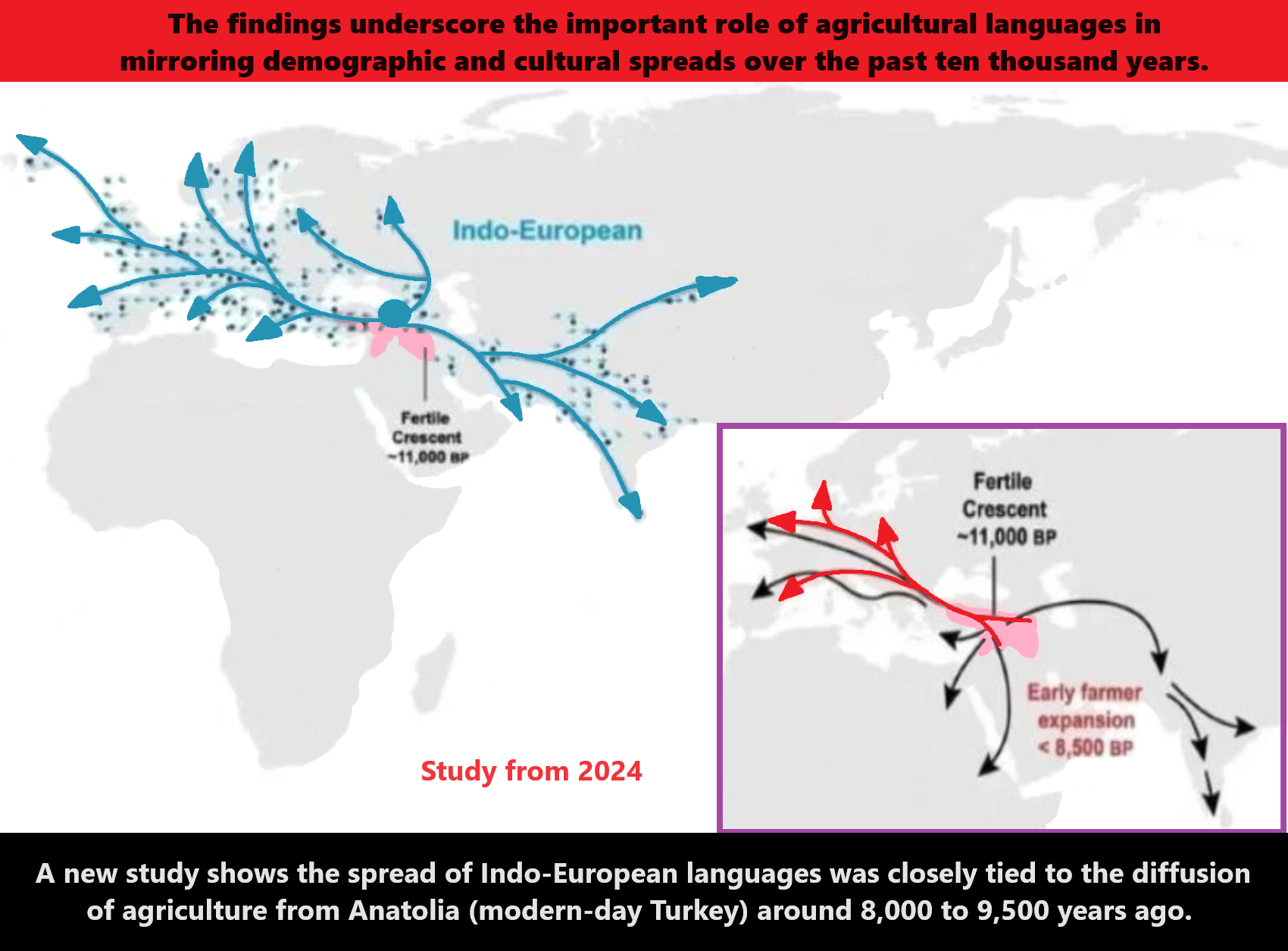
World’s oldest known fort was constructed by hunter-gatherers 8,000 years ago in Siberia
“The fact that this Stone Age fort was built by hunter-gatherers is transforming our understanding of ancient human societies. Hunter-gatherers built the oldest known fort in the world about 8,000 years ago in Siberia, a new study finds. Archaeologists have long associated fortresses with permanent agricultural settlements. However, this cluster of fortified structures reveals that prehistoric groups were constructing protective edifices much earlier than originally thought.” ref
“These hunter-gatherers “defy conventional stereotypes that depict such societies as basic and nomadic, unveiling their capacity to construct intricate structures,” study co-author Tanja Schreiber, an archaeologist at Free University of Berlin, told Live Science in an email. Located along the Amnya River in western Siberia, remains of the Amnya fort include roughly 20 pit-house depressions scattered across the site, which is divided into two sections: Amnya I and Amnya II. Radiocarbon dating confirmed that the settlement was first inhabited during the Mesolithic, or Middle Stone Age, according to the study. When constructed, each pit house would have been protected by earthen walls and wooden palisades — two construction elements that suggest “advanced agricultural and defensive capabilities” by the inhabitants, the archaeologists said in a statement.” ref
“One of the Amnya fort’s most astonishing aspects is the discovery that approximately 8,000 years ago, hunter-gatherers in the Siberian Taiga built intricate defense structures,” Schreiber said. “This challenges traditional assumptions that monumental constructions were solely the work of agricultural communities.” It’s unknown what triggered the need for these fortified structures in the first place, but the strategic location overlooking the river would have not only been an ideal lookout point for potential threats but also allowed hunter-gatherers to keep tabs on their fishing and hunting grounds, the researchers noted.” ref
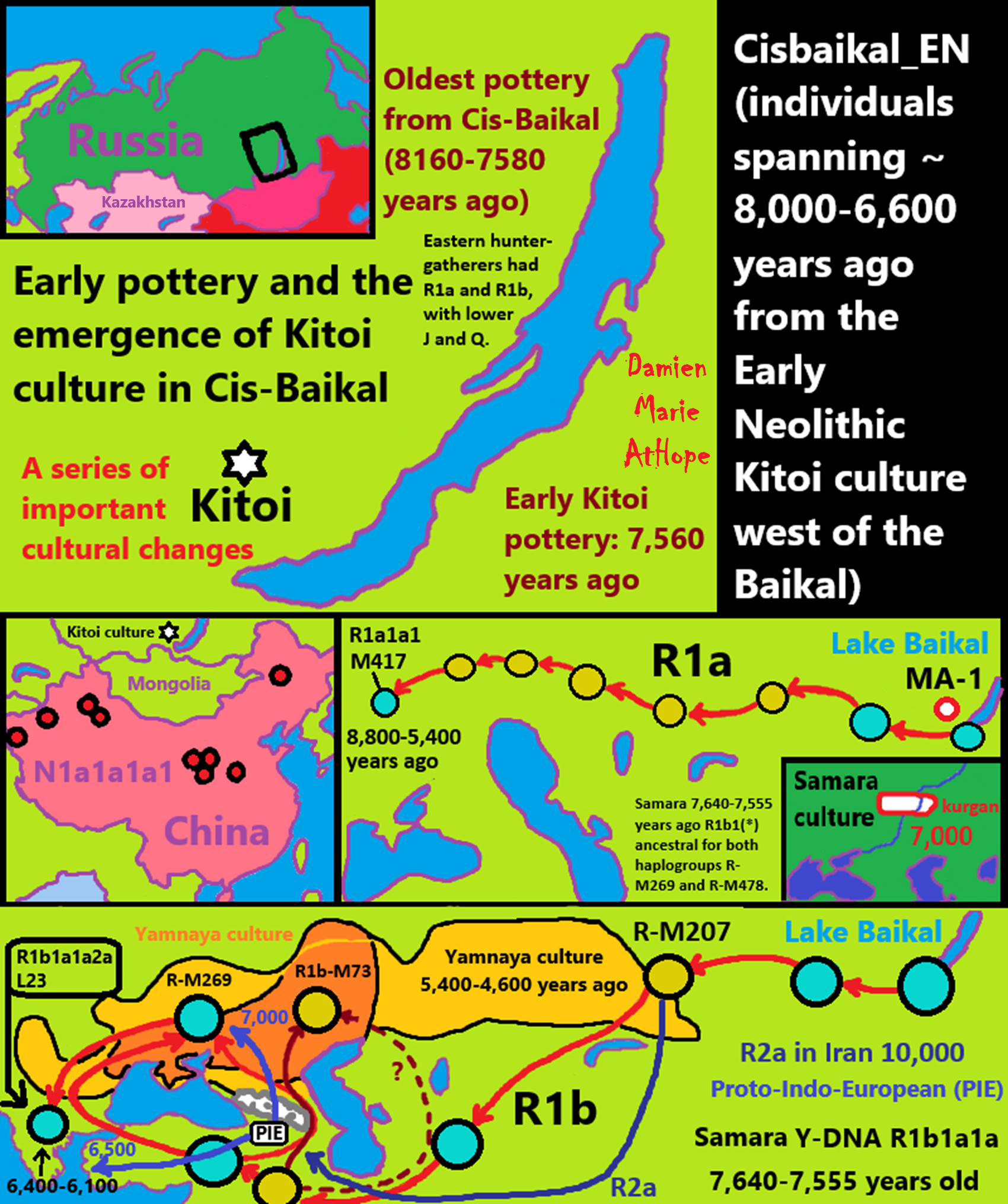
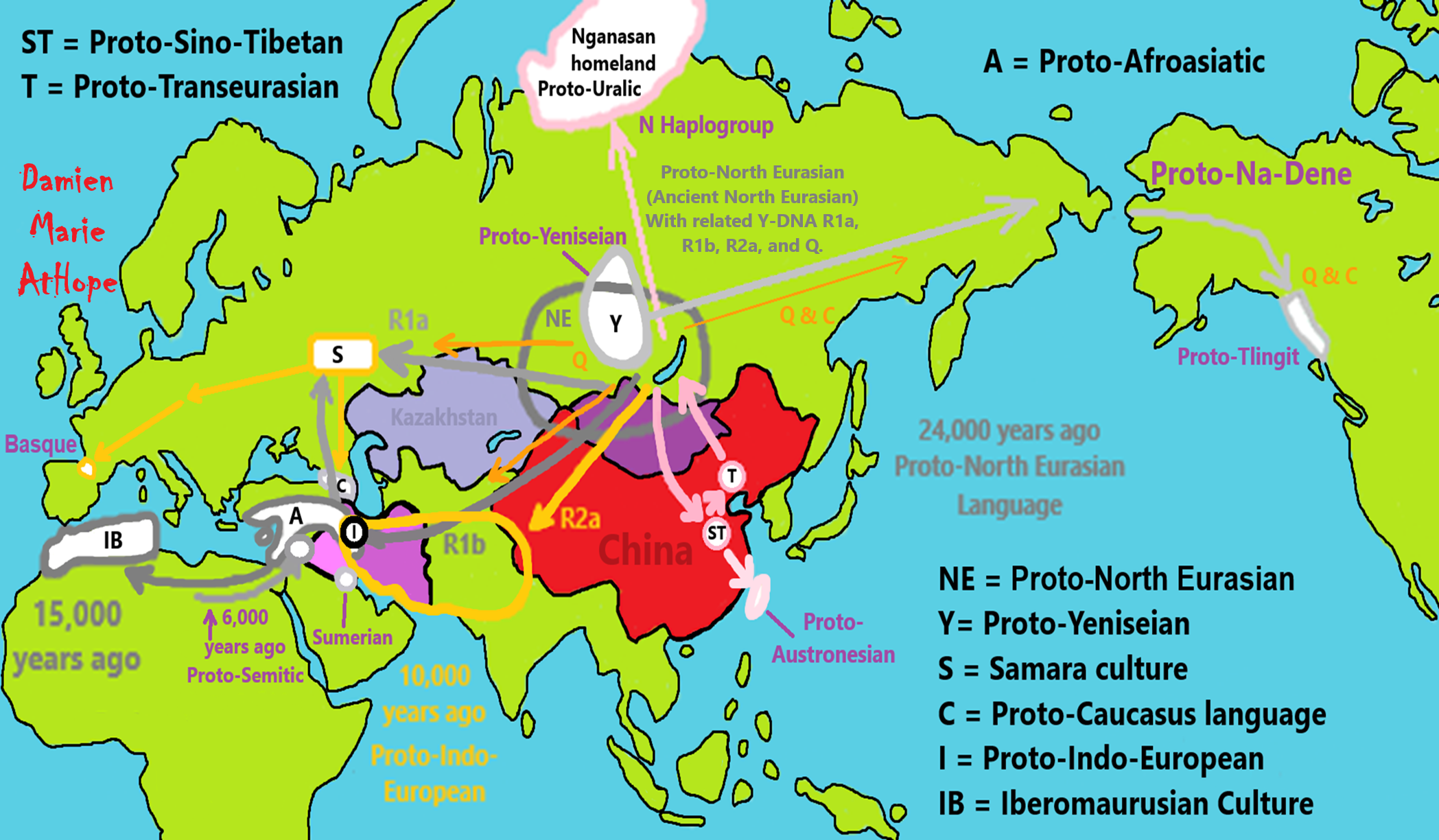
ref, ref, ref, ref, ref, ref, ref, ref, ref, ref, ref, ref, ref, ref, ref, ref, ref, ref, ref, ref, ref, ref, ref, ref, ref, ref, ref, ref, ref, ref, ref
This art above explains my thinking from my life of investigation
I am an anarchist (Social anarchism, Left-wing anarchism, or Socialist anarchism) trying to explain prehistory as I see it after studying it on my own starting 2006. Anarchists are for truth and believe in teaching the plain truth; misinformation is against this, and we would and should fight misinformation and disinformation.
I see anarchism as a social justice issue not limited to some political issue or monetary persuasion. People own themselves, have self/human rights, and deserve freedoms. All humanity is owed respect for its dignity; we are all born equal in dignity and human rights, and no plot of dirt we currently reside on changes this.
I fully enjoy the value (axiology) of archaeology (empirical evidence from fact or artifacts at a site) is knowledge (epistemology) of the past, adding to our anthropology (evidence from cultures both the present and past) intellectual (rational) assumptions of the likely reality of actual events from time past.
I am an Axiological Atheist, Philosopher & Autodidact Pre-Historical Writer/Researcher, Anti-theist, Anti-religionist, Anarcho Humanist, LGBTQI, Race, & Class equality. I am not an academic, I am a revolutionary sharing education and reason to inspire more deep thinking. I do value and appreciate Academics, Archaeologists, Anthropologists, and Historians as they provide us with great knowledge, informing us about our shared humanity.
I am a servant leader, as I serve the people, not myself, not my ego, and not some desire for money, but rather a caring teacher’s heart to help all I can with all I am. From such thoughtfulness may we all see the need for humanism and secularism, respecting all as helpful servant leaders assisting others as often as we can to navigate truth and the beauty of reality.
‘Reality’ ie. real/external world things, facts/evidence such as that confirmed by science, or events taken as a whole documented understanding of what occurred/is likely to have occurred; the accurate state of affairs. “Reason” is not from a mind devoid of “unreason” but rather demonstrates the potential ability to overcome bad thinking. An honest mind, enjoys just correction. Nothing is a justified true belief without valid or reliable reason and evidence; just as everything believed must be open to question, leaving nothing above challenge.
I don’t believe in gods or ghosts, and nor souls either. I don’t believe in heavens or hells, nor any supernatural anything. I don’t believe in Aliens, Bigfoot, nor Atlantis. I strive to follow reason and be a rationalist. Reason is my only master and may we all master reason. Thinking can be random, but reason is organized and sound in its Thinking. Right thinking is reason, right reason is logic, and right logic can be used in math and other scientific methods. I don’t see religious terms Animism, Totemism, Shamanism, or Paganism as primitive but original or core elements that are different parts of world views and their supernatural/non-natural beliefs or thinking.
I am inspired by philosophy, enlightened by archaeology, and grounded by science that religion claims, on the whole, along with their magical gods, are but dogmatic propaganda, myths, and lies. To me, religions can be summed up as conspiracy theories about reality, a reality mind you is only natural and devoid of magic anything. And to me, when people talk as if Atlantis is anything real, I stop taking them seriously. Like asking about the reality of Superman or Batman just because they seem to involve metropolitan cities in their stores. Or if Mother Goose actually lived in a shoe? You got to be kidding.
We are made great in our many acts of kindness, because we rise by helping each other.
NE = Proto-North Eurasian/Ancient North Eurasian/Mal’ta–Buret’ culture/Mal’ta Boy “MA-1” 24,000 years old burial
A = Proto-Afroasiatic/Afroasiatic
S = Samara culture
ST = Proto-Sino-Tibetan/Sino-Tibetan
T = Proto-Transeurasian/Altaic
C = Proto-Northwest Caucasus language/Northwest Caucasian/Languages of the Caucasus
I = Proto-Indo-European/Indo-European
IB = Iberomaurusian Culture/Capsian culture
Natufian culture (15,000–11,500 years ago, Syria, Lebanon, Jordan, the Sinai Peninsula, and the Negev desert)
Nganasan people/Nganasan language
Na-Dene languages/Dené–Yeniseian, Dené–Caucasian
Proto-Semitic/Semitic languages
24,000 years ago, Proto-North Eurasian Language (Ancient North Eurasian) migrations?
My thoughts:
Proto-North Eurasian Language (Ancient North Eurasian) With related Y-DNA R1a, R1b, R2a, and Q Haplogroups.
R1b 22,0000-15,000 years ago in the Middle east creates Proto-Afroasiatic languages moving into Africa around 15,000-10,000 years ago connecting with the Iberomaurusian Culture/Taforalt near the coasts of Morocco, Algeria, and Tunisia.
R2a 10,000 years ago in Iran brings/creates Proto-Indo-European language and also a possibility is R1a in Russia around 9,000 years ago may have had a version of Proto-Indo-European language.
Around 14,000-10,000 years ago??? Proto-North Eurasian Language goes to the Yellow River basin (eventually relating with the Yangshao culture) in China creates Proto-Sino-Tibetan language.
Proto-Sino-Tibetan language then moves to the West Liao River valley (eventually relating with the Hongshan culture) in China creating Proto-Transeurasian (Altaic) language around 9,000 years ago.
N Haplogroups 9,000 years ago with Proto-Transeurasian language possibly moves north to Lake Baikal. Then after living with Proto-North Eurasian Language 24,000-9,000 years ago?/Pre-Proto-Yeniseian language 9,000-7,000 years ago Q Haplogroups (eventually relating with the Ket language and the Ket people) until around 5,500 years ago, then N Haplogroups move north to the Taymyr Peninsula in North Siberia (Nganasan homeland) brings/creates the Proto-Uralic language.
Q Haplogroups with Proto-Yeniseian language /Proto-Na-Dene language likely emerge 8,000/7,000 years ago or so and migrates to the Middle East (either following R2a to Iraq or R1a to Russia (Samara culture) then south to Iraq creates the Sumerian language. It may have also created the Proto-Caucasian languages along the way. And Q Haplogroups with Proto-Yeniseian language to a migration to North America that relates to Na-Dené (and maybe including Haida) languages, of which the first branch was Proto-Tlingit language 5,000 years ago, in the Pacific Northwest.
Sino-Tibetan language then moves more east in China to the Hemudu culture pre-Austronesian culture, next moved to Taiwan creating the Proto-Austronesian language around 6,000-5,500 years ago.
R1b comes to Russia from the Middle East around 7,500 years ago, bringing a version of Proto-Indo-European languages to the (Samara culture), then Q Y-DNA with Proto-Yeniseian language moves south from the (Samara culture) and may have been the language that created the Proto-Caucasian language. And R1b from the (Samara culture) becomes the 4,200 years or so R1b associated with the Basques and Basque language it was taken with R1b, but language similarities with the Proto-Caucasian language implies language ties to Proto-Yeniseian language.
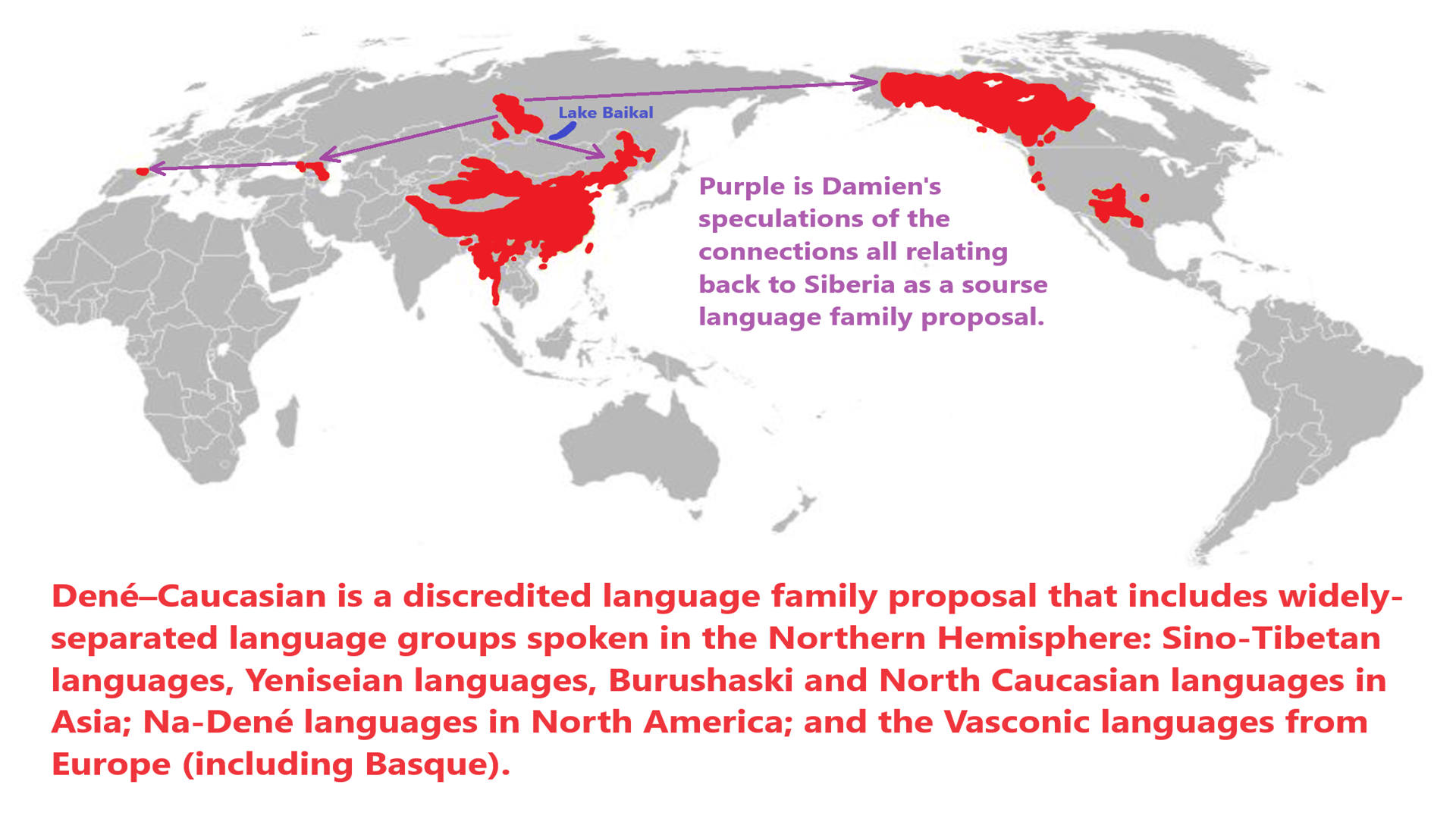
“Dené–Caucasian is a discredited language family proposal that includes widely-separated language groups spoken in the Northern Hemisphere: Sino-Tibetan languages, Yeniseian languages, Burushaski and North Caucasian languages in Asia; Na-Dené languages in North America; and the Vasconic languages from Europe (including Basque). A narrower connection specifically between North American Na-Dené and Siberian Yeniseian (the Dené–Yeniseian languages hypothesis) was proposed by Edward Vajda in 2008, and has met with some acceptance within the community of professional linguists. The validity of the rest of the family, however, is viewed as doubtful or rejected by nearly all historical linguists.” ref
“The Dené–Caucasian family tree and approximate divergence dates (estimated by modified glottochronology) proposed by S. A. Starostin and his colleagues from the Tower of Babel project:
- Dené–Caucasian languages [8,700 BCE or around 10,700 years ago]
- Na-Dené languages (Athabascan–Eyak–Tlingit)
- Sino-Vasconic languages [7,900 BCE or around 9,900 years ago]
- Vasconic (see below)
- Sino-Caucasian languages [6,200 BCE or around 8,200 years ago]
- Burushaski
- Caucaso-Sino-Yeniseian [5,900 BCE or around 7,900 years ago]
- North Caucasian languages
- Sino-Yeniseian [5,100 BCE or around 7,100 years ago]
“John D. Bengtson groups Basque, Caucasian and Burushaski together in a Macro-Caucasian (earlier Vasco-Caucasian) family (see the section on Macro-Caucasian below). According to him, it is as yet premature to propose other nodes or subgroupings, but he notes that Sumerian seems to share the same number of isoglosses with the (geographically) western branches as with the eastern ones:
- Dené–Caucasian
- The Macro-Caucasian family
- Basque
- North Caucasian
- Burushaski
- Sumerian
- Sino-Tibetan
- Yeniseian
- Na-Dené” ref
- The Macro-Caucasian family
“It has been conjectured that the North-West Caucasian languages may be genetically related to the Indo-European family, at a time depth of perhaps 12,000 years before the present. This hypothesized proto-language is called Proto-Pontic, but is not widely accepted. There does at least appear to have been extensive contact between the two proto-languages, and the resemblances may be due to this influence. A few linguists have proposed even broader relationships, of which the Dene–Caucasian hypothesis is perhaps the most popular. Dene–Caucasian links the North Caucasian (including Northwest Caucasian), Basque, Burushaski, Yeniseian, Sino-Tibetan, and Na–Dene families. However, this is an even more tentative hypothesis than Nostratic, which attempts to relate Kartvelian, Indo-European, Uralic, and Altaic, etc., and which is widely considered to be undemonstrated.” ref
“Nostratic is a hypothetical language macrofamily including many of the language families of northern Eurasia. Though a historically important proposal, in a contemporary context it is typically considered a fringe theory. Although the exact composition varies based on proponent, it typically comprises Kartvelian, Indo-European and Uralic languages; some languages from the similarly controversial Altaic family; the Afroasiatic languages; as well as the Dravidian languages (sometimes also Elamo-Dravidian).” ref
“Iran Neolithic (Iran_N) individuals dated ~8,500 years ago carried 50% Ancient North Eurasian-derived admixture and 50% Dzudzuana-related admixture, marking them as different from other Near-Eastern and Anatolian Neolithics who didn’t have Ancient North Eurasian admixture. Iran Neolithics were later replaced by Iran Chalcolithics, who were a mixture of Iran Neolithic and Near Eastern Levant Neolithic.” ref
I speculate that possibly this “Iran Neolithic” difference is a later migration relating to Ancient North Eurasian admixture, with the source languages from Siberia (pre-proto-indo-europeain, like some kind of pre/proto-Yeniseian, or Dené–Yeniseian languages/or Dené–Caucasian) that then merged into proto-indo-European languages seen just west of Iran in the Caucasus and East Turkey areas. Also, I speculate that the idea of pottery was likewise brought by these peoples and they, to me could have influenced the creation of the earliest pottery in Tell Hassuna and Jarmo (Iraq).
“Proto-Yeniseian or Proto-Yeniseic is the unattested reconstructed proto-language from which all Yeniseian languages are thought to descend from. It is uncertain whether Proto-Yeniseian had a similar tone/pitch accent system as Ket people, who practiced Shamanism and connected to Tengrism. Many studies about Proto-Yeniseian phonology have been done, however there are still many things unclear about Proto-Yeniseian. The probable location of the Yeniseian homeland is proposed on the basis of geographic names and genetic studies, which suggests a homeland in Southern Siberia.” ref
“Tengri (Old Turkic: 𐰚𐰇𐰚:𐱅𐰭𐰼𐰃, romanized: Kök Teŋri/Teŋiri, lit. ’Blue Heaven’; Old Uyghur: tängri; Middle Turkic: تآنغرِ; Ottoman Turkish: تڭری; Kyrgyz: Теңир; Kazakh: Тәңір; Turkish: Tanrı; Azerbaijani: Tanrı; Bulgarian: Тангра; Proto-Turkic *teŋri / *taŋrɨ; Mongolian script: ᠲᠩᠷᠢ, T’ngri; Mongolian: Тэнгэр, Tenger; Uyghur: تەڭرى tengri ) is the all-encompassing God of Heaven in the traditional Turkic, Yeniseian, Mongolic, and various other nomadic Altaic religious beliefs. Tengri is not considered a deity in the usual sense, but a personification of the universe. However, some qualities associated with Tengri as the judge and source of life, and being eternal and supreme, led European and Muslim writers to identify Tengri as a deity of Turkic and Mongolic peoples. According to Mongolian belief, Tengri’s will (jayayan) may break its own usual laws and intervene by sending a chosen person to earth. It is also one of the terms used for the primary chief deity of the early Turkic and Mongolic peoples. Worship surrounding Tengri is called Tengrism. The core beings in Tengrism are the Sky Father (Tenger Etseg) and the Earth Mother (Umay Ana). It involves ancestor worship, as Tengri was thought to have been the ancestral progenitor of mankind in Turkic regions and Mongolia, shamanism, animism, and totemism.” ref
“Tengrism (also known as Tengriism, Tengerism, or Tengrianism) is a religion originating in the Eurasian steppes, based on shamanism and animism. It generally involves the titular sky god Tengri, who is not considered a deity in the usual sense but a personification of the universe. According to some scholars, adherents of Tengrism view the purpose of life to be in harmony with the universe. It was the prevailing religion of the Göktürks, Xianbei, Bulgars, Xiongnu, Yeniseian, and Mongolic peoples and Huns, as well as the state religion of several medieval states: the First Turkic Khaganate, the Western Turkic Khaganate, the Eastern Turkic Khaganate, Old Great Bulgaria, the First Bulgarian Empire, Volga Bulgaria, Khazaria, and the Mongol Empire. In the Irk Bitig, a ninth century manuscript on divination, Tengri is mentioned as Türük Tängrisi (God of Turks). According to many academics, Tengrism was, and to some extent still is, a predominantly polytheistic religion based on the shamanistic concept of animism, and was first influenced by monotheism during the imperial period, especially by the 12th–13th centuries. Abdulkadir Inan argues that Yakut and Altai shamanism are not entirely equal to the ancient Turkic religion.” ref
“The term also describes several contemporary Turkic and Mongolic native religious movements and teachings. All modern adherents of “political” Tengrism are monotheists. Tengrism has been advocated for in intellectual circles of the Turkic nations of Central Asia (Kyrgyzstan with Kazakhstan) and Russia (Tatarstan, Bashkortostan) since the dissolution of the Soviet Union during the 1990s. Still practiced, it is undergoing an organized revival in Buryatia, Sakha (Yakutia), Khakassia, Tuva and other Turkic nations in Siberia. Altaian Burkhanism and Chuvash Vattisen Yaly are contemporary movements similar to Tengrism. The term tengri (compare with Kami) can refer to the sky deity Tenger Etseg – also Gök Tengri; Sky father, Blue sky – or to other deities. While Tengrism includes the worship of personified gods (tngri) such as Ülgen and Kaira,Tengri is considered an “abstract phenomenon”. In Mongolian folk religion, Genghis Khan is considered one of the embodiments, if not the main embodiment, of Tengri’s will. The forms of the name Tengri (Old Turkic: Täŋri) among the ancient and modern Turkic and Mongolic are Tengeri, Tangara, Tangri, Tanri, Tangre, Tegri, Tingir, Tenkri, Tangra, Teri, Ter, and Ture. The name Tengri (“the Sky”) is derived from Old Turkic: Tenk (“daybreak”) or Tan (“dawn”). Meanwhile, Stefan Georg proposed that the Turkic Tengri ultimately originates as a loanword from Proto-Yeniseian *tɨŋgɨr- “high”. Mongolia is sometimes poetically called the “Land of Eternal Blue Sky” (Mönkh Khökh Tengeriin Oron) by its inhabitants. According to some scholars, the name of the important deity Dangun (also Tangol) (God of the Mountains) of the Korean folk religion is related to the Siberian Tengri (“Heaven”), while the bear is a symbol of the Big Dipper (Ursa Major).” ref
“Tiān (天) is one of the oldest Chinese terms for heaven and a key concept in Chinese mythology, philosophy, and religion. During the Shang dynasty (17th―11th century BCE), the Chinese referred to their highest god as Shàngdì (上帝, “Lord Above”) or Dì (帝, “Lord”). During the following Zhou dynasty, Tiān became synonymous with this figure. Before the 20th century, worship of Tiān was an orthodox state religion of China. In Chinese culture, heaven tends to be “synonymous with order”, “containing the blueprints for creation”, “the mandate by which earthly rulers govern, and the standards by which to measure beauty, goodness, and truth.” Zhou dynasty nobles made the worship of heaven a major part of their political philosophy and viewed it as “many gods” who embodied order and kingship, as well as the mandate of heaven. For the etymology of tiān, Schuessler links it with the Mongolian word tengri “sky, heaven, heavenly deity” or the Tibeto-Burman words taleŋ (Adi) and tǎ-lyaŋ (Lepcha), both meaning “sky”. He also suggests a likely connection between Chinese tiān 天, diān 巔 “summit, mountaintop”, and diān 顛 “summit, top of the head, forehead”, which have cognates such as Zemeic Naga tiŋ “sky”. However, other reconstructions of 天’s OC pronunciation *qʰl’iːn or *l̥ˤi[n] reconstructed a voiceless lateral onset, either a cluster or a single consonant, respectively. Baxter & Sagart pointed to attested dialectal differences in Eastern Han Chinese, the use of 天 as a phonetic component in phono-semantic compound Chinese characters, and the choice of 天 to transcribe foreign syllables, all of which prompted them to conclude that, around 200 CE, 天’s onset had two pronunciations: coronal *tʰ & dorsal *x, both of which likely originated from an earlier voiceless lateral *l̥ˤ.” ref
“In Taoism and Confucianism, Tiān (the celestial aspect of the cosmos, often translated as “Heaven“) is mentioned in relationship to its complementary aspect of Dì (地, often translated as “Earth“). They are thought to maintain the two poles of the Three Realms (三界) of reality, with the middle realm occupied by Humanity (人, rén), and the lower world occupied by demons (魔, mó) and “ghosts”, the damned, (鬼, guǐ). Tiān was variously thought as a “supreme power reigning over lesser gods and human beings” that brought “order and calm…or catastrophe and punishment”, a god, destiny, an “impersonal” natural force that controlled various events, a holy world or afterlife containing other worlds or afterlives, or one or more of these. “Confucianism has a religious side with a deep reverence for Heaven and Earth (Di), whose powers regulate the flow of nature and influence human events.” Yin and yang are also thought to be integral to this relationship and permeate both, as well as humans and man-made constructs. This “cosmos” and its “principles” is something that “[t]he ways of man should conform to, or else” frustration will result. Many Confucianists, both historically and in current times, use the I Ching to divine events through the changes of Tiān and other “natural forces”. Historical and current Confucianists were/are often environmentalists out of their respect for Heaven and the other aspects of nature and the “Principle” that comes from their unity and, more generally, harmony as a whole, which is “the basis for a sincere mind.” The Emperor of China as Tianzi was formerly vital to Confucianism. Mount Tai is seen as a sacred place in Confucianism and was traditionally the most revered place where Chinese emperors offered sacrifices to heaven and earth. Some tiān in Chinese folk religion were thought to be many different or a hierarchy of multiple, sphere-like realms that contained morally ambiguous creatures and spirits such as huli jing and fire-breathing dragons. ” ref
“Paleo-Siberian languages, languages spoken in Asian Russia (Siberia) that belong to four genetically unrelated groups—Yeniseian, Luorawetlan, Yukaghir, and Nivkh.” ref
Proto-Indo-European mythology
“Proto-Indo-European mythology is the body of myths and deities associated with the Proto-Indo-Europeans, speakers of the hypothesized Proto-Indo-European language. Although the mythological motifs are not directly attested – since Proto-Indo-European speakers lived in preliterate societies – scholars of comparative mythology have reconstructed details from inherited similarities found among Indo-European languages, based on the assumption that parts of the Proto-Indo-Europeans’ original belief systems survived in the daughter traditions. The Proto-Indo-European pantheon includes a number of securely reconstructed deities, since they are both cognates – linguistic siblings from a common origin – and associated with similar attributes and body of myths: such as *Dyḗws Ph₂tḗr, the daylight-sky god; his consort *Dʰéǵʰōm, the earth mother; his daughter *H₂éwsōs, the dawn goddess; his sons the Divine Twins; and *Seh₂ul and *Meh₁not, a solar goddess and moon god, respectively. Some deities, like the weather god *Perkʷunos or the herding-god *Péh₂usōn, are only attested in a limited number of traditions – Western (i.e. European) and Graeco-Aryan, respectively – and could therefore represent late additions that did not spread throughout the various Indo-European dialects.” ref
“Some myths are also securely dated to Proto-Indo-European times, since they feature both linguistic and thematic evidence of an inherited motif: a story portraying a mythical figure associated with thunder and slaying a multi-headed serpent to release torrents of water that had previously been pent up; a creation myth involving two brothers, one of whom sacrifices the other in order to create the world; and probably the belief that the Otherworld was guarded by a watchdog and could only be reached by crossing a river. Various schools of thought exist regarding possible interpretations of the reconstructed Proto-Indo-European mythology. The main mythologies used in comparative reconstruction are Indo-Iranian, Baltic, Roman, and Norse, often supported with evidence from the Celtic, Greek, Slavic, Hittite, Armenian, Illyrian, and Albanian traditions as well.” ref
“Early agricultural communities such as Chogha Golan in 10,000 BCE or around 12,000 years ago, along with settlements such as Chogha Bonut (the earliest village in Elam) in 8000 BCE or around 10,000 years ago, began to flourish in and around the Zagros Mountains region in western Iran. Around about the same time, the earliest-known clay vessels and modeled human and animal terracotta figurines were produced at Ganj Dareh, also in western Iran. There are also 10,000-year-old human and animal figurines from Tepe Sarab in Kermanshah Province among many other ancient artifacts.” ref
I also speculate that there may be a connection with this to the earliest pottery in Turkey from Boncuklu Höyük as well.
“12 fired clay samples and an unfired marl sample from the late 9th and early 8th-millennium BCE site of Boncuklu Höyük (8300–7800 cal BCE or around 10,300 to 9,800 years ago) in the Konya Plain, Turkey. The clay vessels from Boncuklu Höyük, an early Neolithic site in central Anatolia, are much earlier than the accepted date for the introduction of pottery in Anatolia, c. 7000 cal BCE or around 9,000 years ago.” ref
Proto-Indo-European (PIE) is the reconstructed common ancestor of the Indo-European language family:
| Subdivisions |
|---|
“Western Iran was inhabited by a population genetically most similar to hunter-gatherers from the Caucasus, but distinct from the Neolithic Anatolian people who later brought food production into Europe. While some degree of cultural diffusion between Anatolia, Western Iran, and other neighboring regions is possible, the genetic dissimilarity between early Anatolian farmers and the inhabitants of Ganj Dareh supports a model in which Neolithic societies in these areas were distinct. The genome of an early Neolithic female from Ganj Dareh, GD13a, from the Central Zagros (Western Iran), dated to 10000-9700 cal years ago, a region located at the eastern edge of the Near East. Ganj Dareh is well known for providing the earliest evidence of herd management of goats beginning at 9,900 years ago. The mitochondrion of GD13a (91.74X) was assigned to haplogroup X, most likely to the subhaplogroup X2, which has been associated with an early expansion from the Near East and has been found in early Neolithic samples from Anatolia, Hungary, and Germany. GD13a did not cluster with any other early Neolithic individual from Eurasia in any of the analyses. Also genetically close to GD13a were ancient samples from Steppe populations (Yamanya & Afanasievo) that were part of one or more Bronze age migrations into Europe, as well as early Bronze age cultures in that continent (Corded Ware), in line with previous relationships observed for the Caucasus Hunter-Gatherers.” ref
“Subclade X2 appears to have undergone extensive population expansion and dispersal around or soon after the Last Glacial Maximum, roughly 20,000 years ago. It is more strongly represented in the Near East, the Caucasus, and southern Europe, and somewhat less strongly present in the rest of Europe. The highest concentrations are found in the Ojibwe (25%), Sioux (15%), Nuu-Chah-Nulth (12%), Georgia (8%), Orkney (7%), and amongst the Druze Assyrian community in Israel (27%). Subclades of X2 are not present in South Americans Amerindian populations. The oldest known human associated with X2 is Kennewick Man, whose c. 9000-year old remains were discovered in Washington State. The lineage of haplogroup X in the Americas is not derived from a European subclade, but rather represents an independent subclade, labeled X2a. The X2a subclade has not been found in Eurasia, and has most likely arisen within the early Paleo-Indian population, at roughly 13,000 years ago. A basal variant of X2a was found in the Kennewick Man fossil (ca. 9,000 years ago). No presence of mt-DNA ancestral to X2a has been found in Europe or the Near East. New World lineages X2a and X2g are not derived from the Old World lineages X2b, X2c, X2d, X2e, and X2f, indicating an early origin of the New World lineages “likely at the very beginning of their expansion and spread from the Near East.” ref
“Although it occurs only at a frequency of about 3% for the total current indigenous population of the Americas, it is a bigger haplogroup in northern North America, where among the Algonquian peoples it comprises up to 25% of mtDNA types. It is also present in lesser percentages to the west and south of this area—among the Sioux (15%), the Nuu-chah-nulth (11%–13%), the Navajo (7%), and the Yakama (5%). In Latin America, Haplotype X6 was present in the Tarahumara 1.8% (1/53) and Huichol 20% (3/15) X6 and X7 was also found in 12% in Yanomani people. Unlike the four main Native American mtDNA haplogroups (A, B, C, D), X is not strongly associated with East Asia. The main occurrence of X in Asia discovered so far is in the Altai people in Siberia. One theory of how the X Haplogroup ended up in North America is that the people carrying it migrated from central Asia along with haplogroups A, B, C, and D, from an ancestor from the Altai Region of Central Asia. Two sequences of haplogroup X2 were sampled further east of Altai among the Evenks of Central Siberia. These two sequences belong to X2* and X2b. It is uncertain if they represent a remnant of the migration of X2 through Siberia or a more recent input.” ref
“Haplogroup X has been found in various other bone specimens that were analysed for ancient DNA, including specimens associated with the Alföld Linear Pottery (X2b-T226C, Garadna-Elkerülő út site 2, 1/1 or 100%), Linearbandkeramik (X2d1, Halberstadt-Sonntagsfeld, 1/22 or ~5%), and Iberia Chalcolithic (X2b, La Chabola de la Hechicera, 1/3 or 33%; X2b, El Sotillo, 1/3 or 33%; X2b, El Mirador Cave, 1/12 or ~8%) cultures. Abel-beth-maachah 2201 was a man who lived between 1014 and 836 BCE during the Levant Iron Age and was found in the region now known as Abel Beth Maacah, Metula, Israel. He was associated with the Galilean cultural group. His direct maternal line belonged to mtDNA haplogroup X2b. Haplogroup X has been found in ancient Assyria and ancient Egyptian mummies excavated at the Abusir el-Meleq archaeological site in Middle Egypt, which date from the late New Kingdom and Roman periods. Fossils excavated at the Late Neolithic site of Kelif el Boroud in Morocco, which have been dated to around 5,000 years old, have also been found to carry the X2 subclade.” ref

“Migration from Siberia behind the formation of Göbeklitepe: Expert states. People who migrated from Siberia formed the Göbeklitepe, and those in Göbeklitepe migrated in five other ways to spread to the world, said experts about the 12,000-year-old Neolithic archaeological site in the southwestern province of Şanlıurfa.“ The upper paleolithic migrations between Siberia and the Near East is a process that has been confirmed by material culture documents,” he said.” ref
“Semih Güneri, a retired professor from Caucasia and Central Asia Archaeology Research Center of Dokuz Eylül University, and his colleague, Professor Ekaterine Lipnina, presented the Siberia-Göbeklitepe hypothesis they have developed in recent years at the congress held in Istanbul between June 11 and 13. There was a migration that started from Siberia 30,000 years ago and spread to all of Asia and then to Eastern and Northern Europe, Güneri said at the international congress.” ref
“The relationship of Göbeklitepe high culture with the carriers of Siberian microblade stone tool technology is no longer a secret,” he said while emphasizing that the most important branch of the migrations extended to the Near East. “The results of the genetic analyzes of Iraq’s Zagros region confirm the traces of the Siberian/North Asian indigenous people, who arrived at Zagros via the Central Asian mountainous corridor and met with the Göbeklitepe culture via Northern Iraq,” he added.” ref
“Emphasizing that the stone tool technology was transported approximately 7,000 kilometers from east to west, he said, “It is not clear whether this technology is transmitted directly to long distances by people speaking the Turkish language at the earliest, or it travels this long-distance through using way stations.” According to the archaeological documents, it is known that the Siberian people had reached the Zagros region, he said. “There seems to be a relationship between Siberian hunter-gatherers and native Zagros hunter-gatherers,” Güneri said, adding that the results of genetic studies show that Siberian people reached as far as the Zagros.” ref
“There were three waves of migration of Turkish tribes from the Southern Siberia to Europe,” said Osman Karatay, a professor from Ege University. He added that most of the groups in the third wave, which took place between 2600-2400 BCE, assimilated and entered the Germanic tribes and that there was a genetic kinship between their tribes and the Turks. The professor also pointed out that there are indications that there is a technology and tool transfer from Siberia to the Göbeklitepe region and that it is not known whether people came, and if any, whether they were Turkish.” ref
“Around 12,000 years ago, there would be no ‘Turks’ as we know it today. However, there may have been tribes that we could call our ‘common ancestors,’” he added. “Talking about 30,000 years ago, it is impossible to identify and classify nations in today’s terms,” said Murat Öztürk, associate professor from İnönü University. He also said that it is not possible to determine who came to where during the migrations that were accepted to have been made thousands of years ago from Siberia. On the other hand, Mehmet Özdoğan, an academic from Istanbul University, has an idea of where “the people of Göbeklitepe migrated to.” ref
“According to Özdoğan, “the people of Göbeklitepe turned into farmers, and they could not stand the pressure of the overwhelming clergy and started to migrate to five ways.” “Migrations take place primarily in groups. One of the five routes extends to the Caucasus, another from Iran to Central Asia, the Mediterranean coast to Spain, Thrace and [the northwestern province of] Kırklareli to Europe and England, and one route is to Istanbul via [Istanbul’s neighboring province of] Sakarya and stops,” Özdoğan said. In a very short time after the migration of farmers in Göbeklitepe, 300 settlements were established only around northern Greece, Bulgaria, and Thrace. “Those who remained in Göbeklitepe pulled the trigger of Mesopotamian civilization in the following periods, and those who migrated to Mesopotamia started irrigated agriculture before the Sumerians,” he said.” ref

“The arrival of haplogroup R1a-M417 in Eastern Europe, and the east-west diffusion of pottery through North Eurasia.” ref
R-M417 (R1a1a1)
“R1a1a1 (R-M417) is the most widely found subclade, in two variations which are found respectively in Europe (R1a1a1b1 (R-Z282) ([R1a1a1a*] (R-Z282) and Central and South Asia (R1a1a1b2 (R-Z93) ([R1a1a2*] (R-Z93).” ref
R-Z282 (R1a1a1b1a) (Eastern Europe)
“This large subclade appears to encompass most of the R1a1a found in Europe.
- R1a1a1b1a [R1a1a1a*] (R-Z282*) occurs in northern Ukraine, Belarus, and Russia at a frequency of c. 20%.
- R1a1a1b1a3 [R1a1a1a1] (R-Z284) occurs in Northwest Europe and peaks at c. 20% in Norway.
- R1a1a1c (M64.2, M87, M204) is apparently rare: it was found in 1 of 117 males typed in southern Iran.” ref
R1a1a1b2 (R-Z93) (Asia)
“This large subclade appears to encompass most of the R1a1a found in Asia, being related to Indo-European migrations (including Scythians, Indo-Aryan migrations, and so on).
- R-Z93* or R1a1a1b2* (R1a1a2* in Underhill (2014)) is most common (>30%) in the South Siberian Altai region of Russia, cropping up in Kyrgyzstan (6%) and in all Iranian populations (1-8%).
- R-Z2125 occurs at highest frequencies in Kyrgyzstan and in Afghan Pashtuns (>40%). At a frequency of >10%, it is also observed in other Afghan ethnic groups and in some populations in the Caucasus and Iran.
- R-M434 is a subclade of Z2125. It was detected in 14 people (out of 3667 people tested), all in a restricted geographical range from Pakistan to Oman. This likely reflects a recent mutation event in Pakistan.
- R-M560 is very rare and was only observed in four samples: two Burushaski speakers (north Pakistan), one Hazara (Afghanistan), and one Iranian Azerbaijani.
- R-M780 occurs at high frequency in South Asia: India, Pakistan, Afghanistan, and the Himalayas. The group also occurs at >3% in some Iranian populations and is present at >30% in Roma from Croatia and Hungary.” ref
R-M458 (R1a1a1b1a1)
“R-M458 is a mainly Slavic SNP, characterized by its own mutation, and was first called cluster N. Underhill et al. (2009) found it to be present in modern European populations roughly between the Rhine catchment and the Ural Mountains and traced it to “a founder effect that … falls into the early Holocene period, 7.9±2.6 KYA.” M458 was found in one skeleton from a 14th-century grave field in Usedom, Mecklenburg-Vorpommern, Germany. The paper by Underhill et al. (2009) also reports a surprisingly high frequency of M458 in some Northern Caucasian populations (for example 27.5% among Karachays and 23.5% among Balkars, 7.8% among Karanogays and 3.4% among Abazas).” ref

Pic ref
Abstract
“Ancient genomes have revolutionized our understanding of Holocene prehistory and, particularly, the Neolithic transition in western Eurasia. In contrast, East Asia has so far received little attention, despite representing a core region at which the Neolithic transition took place independently ~3 millennia after its onset in the Near East. We report genome-wide data from two hunter-gatherers from Devil’s Gate, an early Neolithic cave site (dated to ~7.7 thousand years ago) located in East Asia, on the border between Russia and Korea. Both of these individuals are genetically most similar to geographically close modern populations from the Amur Basin, all speaking Tungusic languages, and, in particular, to the Ulchi. The similarity to nearby modern populations and the low levels of additional genetic material in the Ulchi imply a high level of genetic continuity in this region during the Holocene, a pattern that markedly contrasts with that reported for Europe.” ref
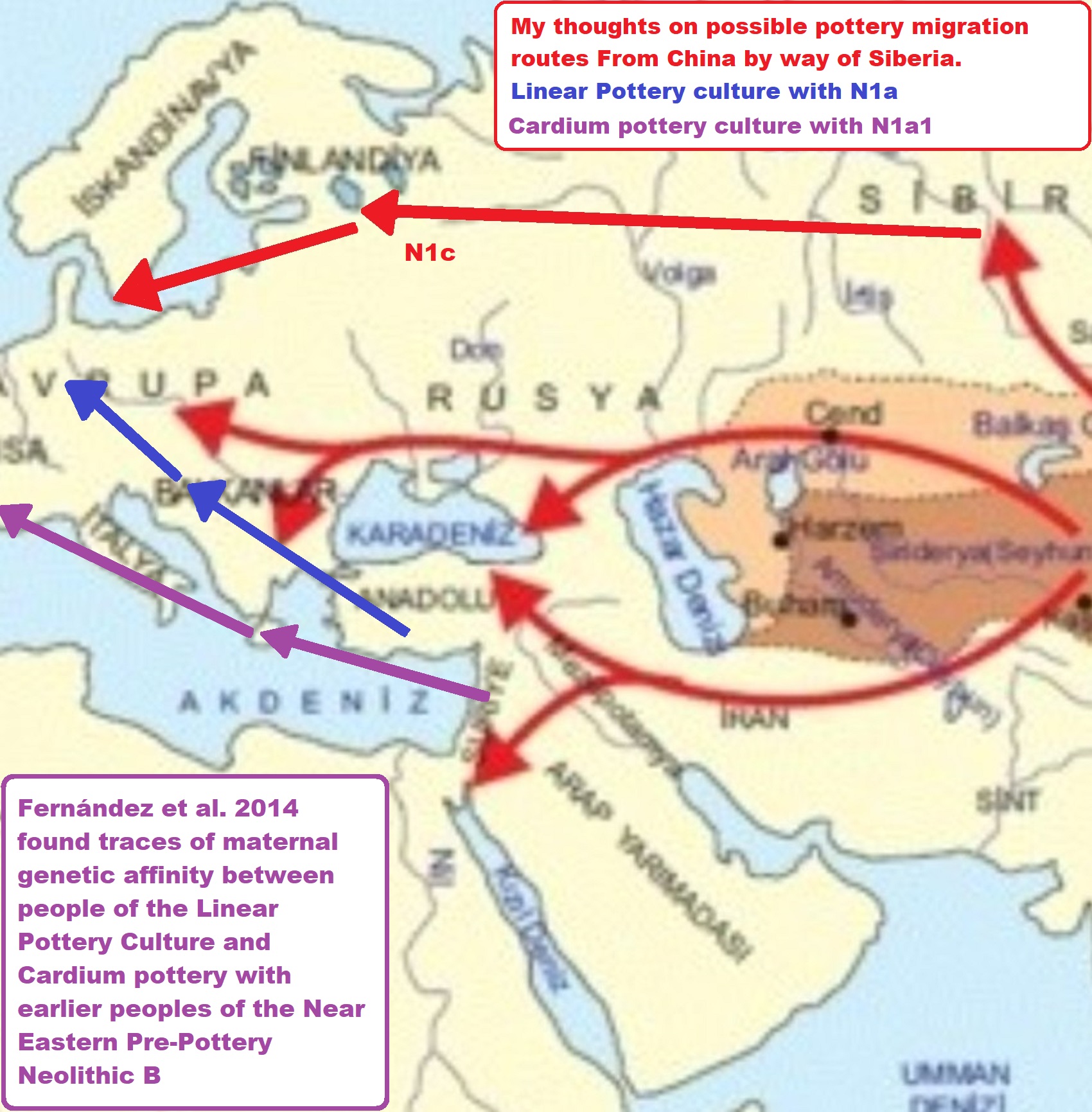
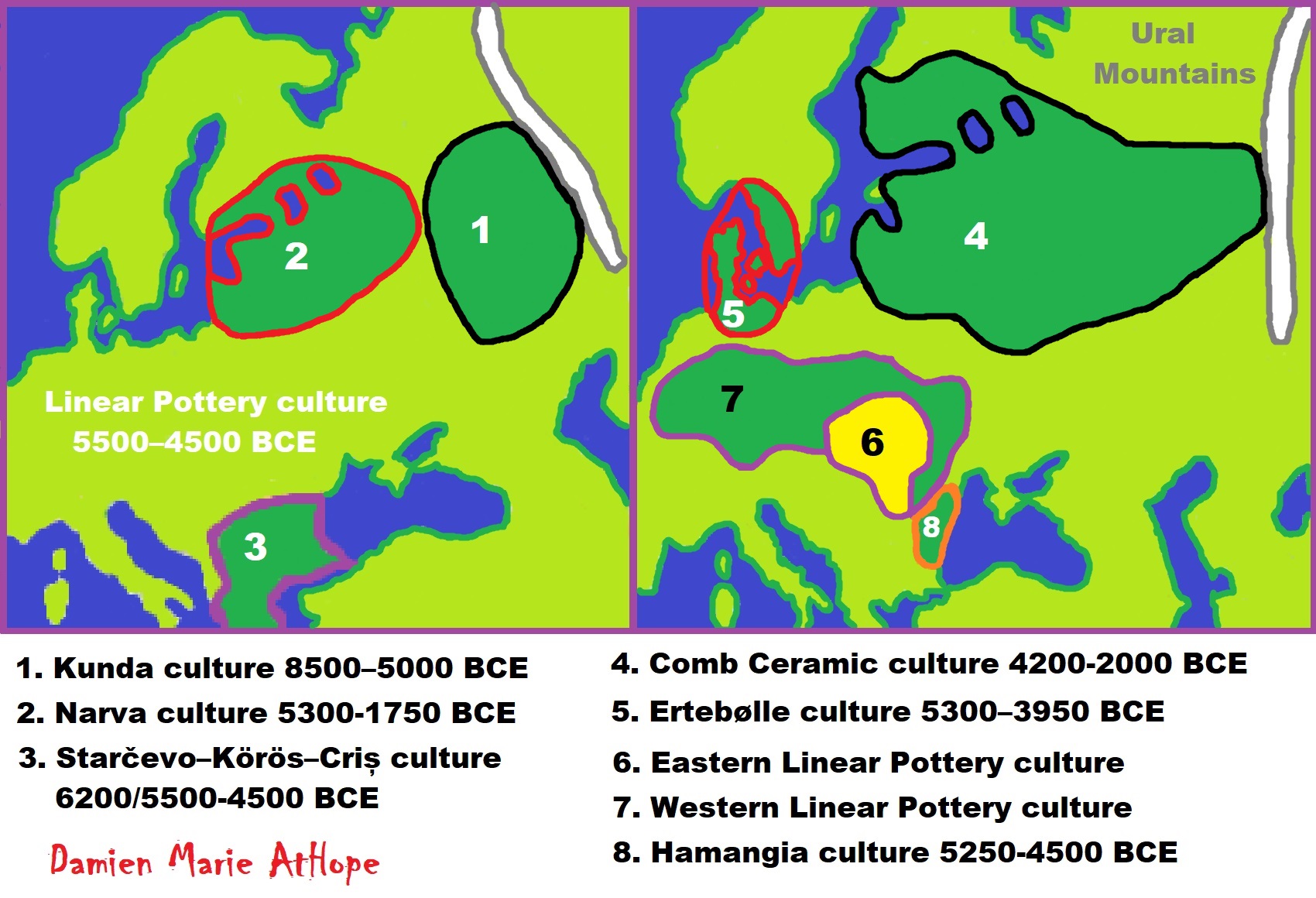
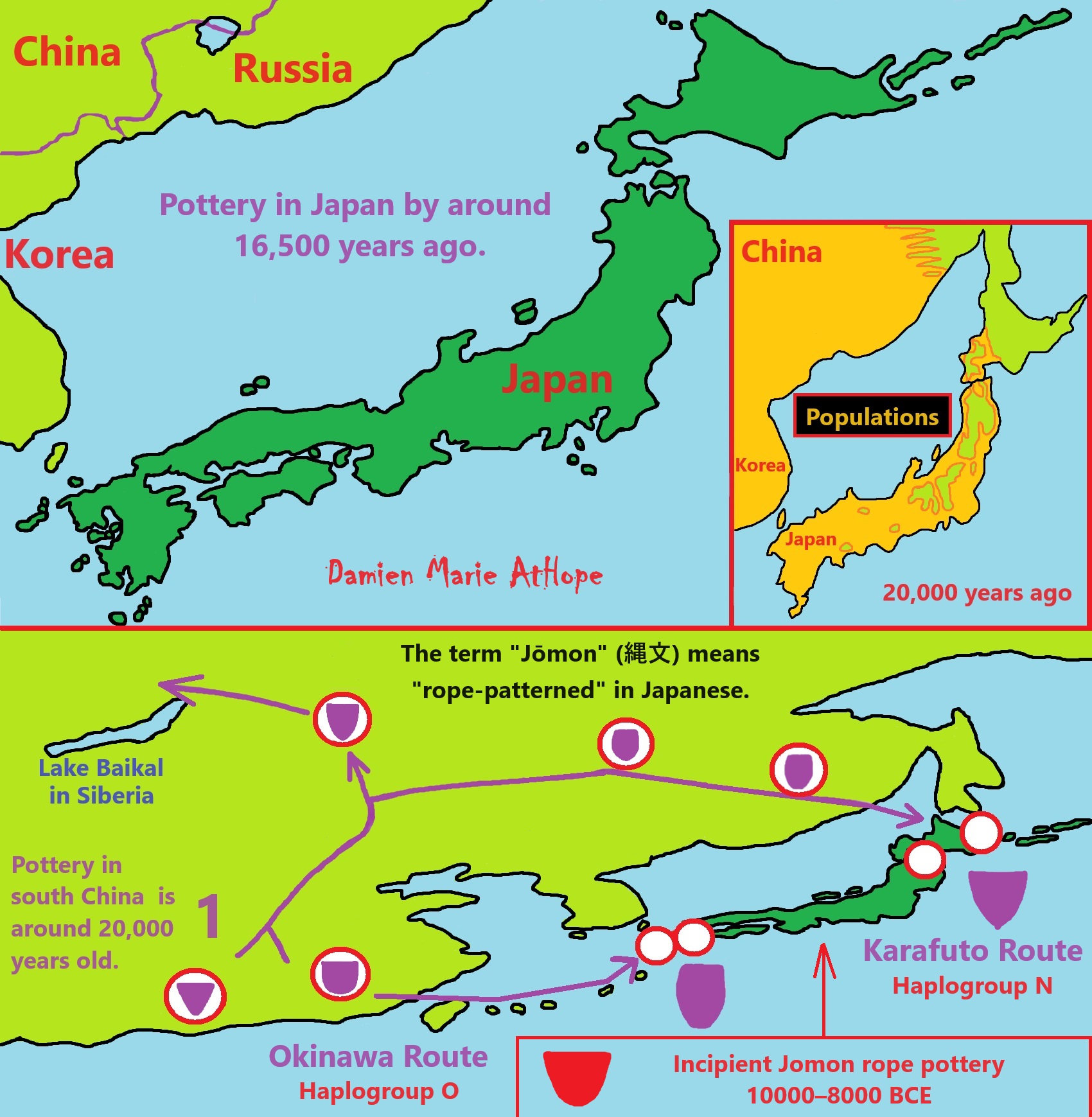
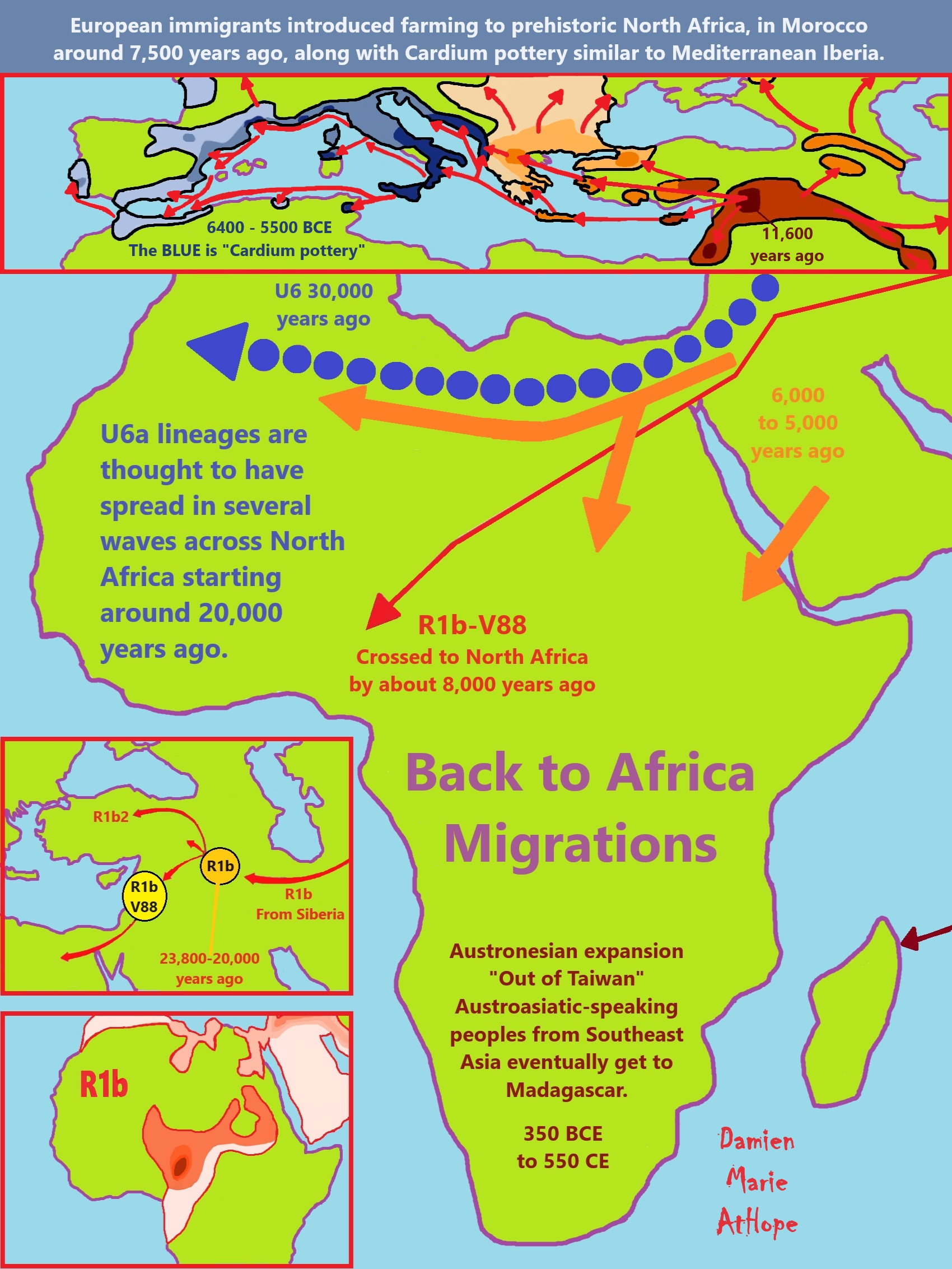

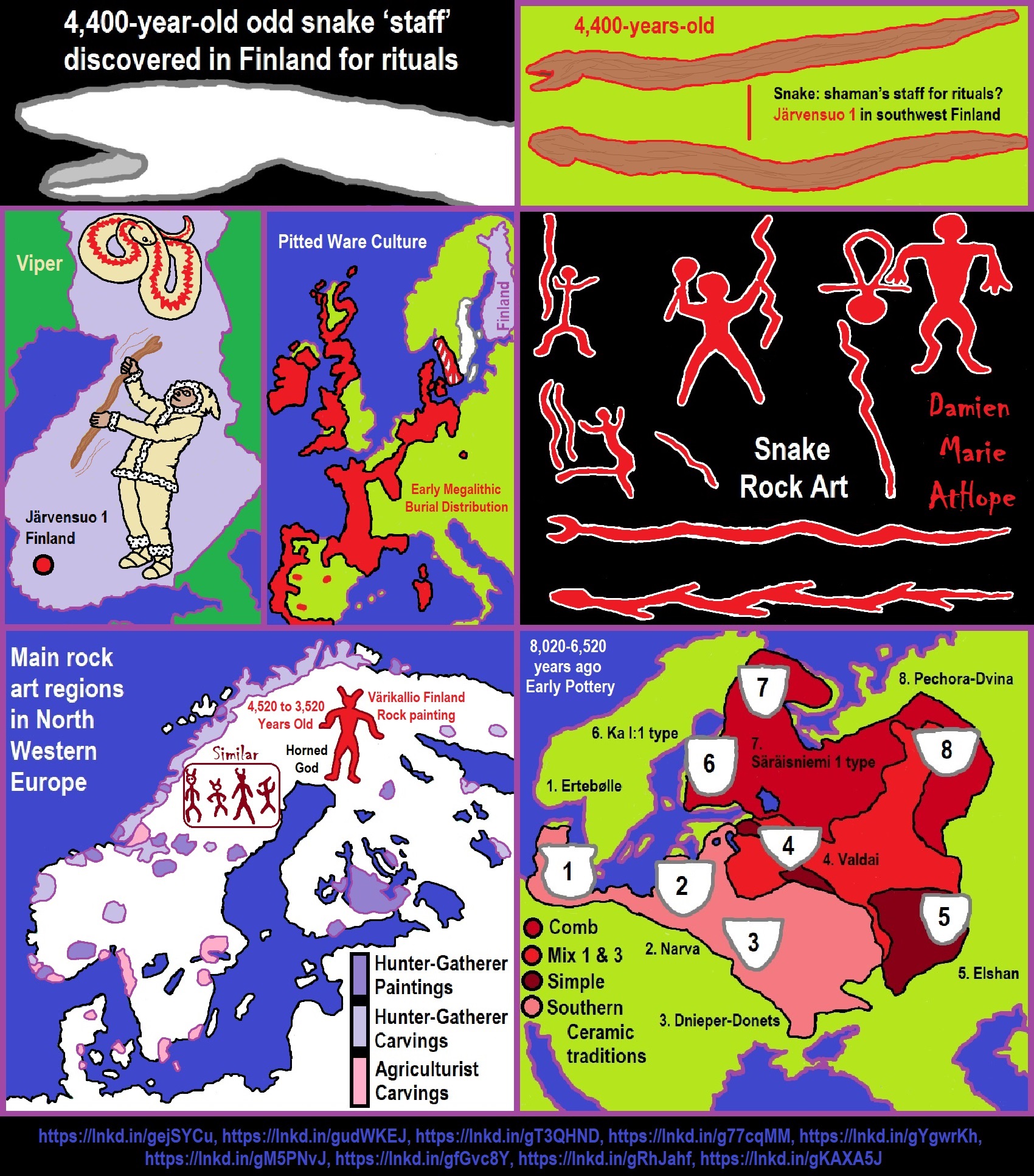
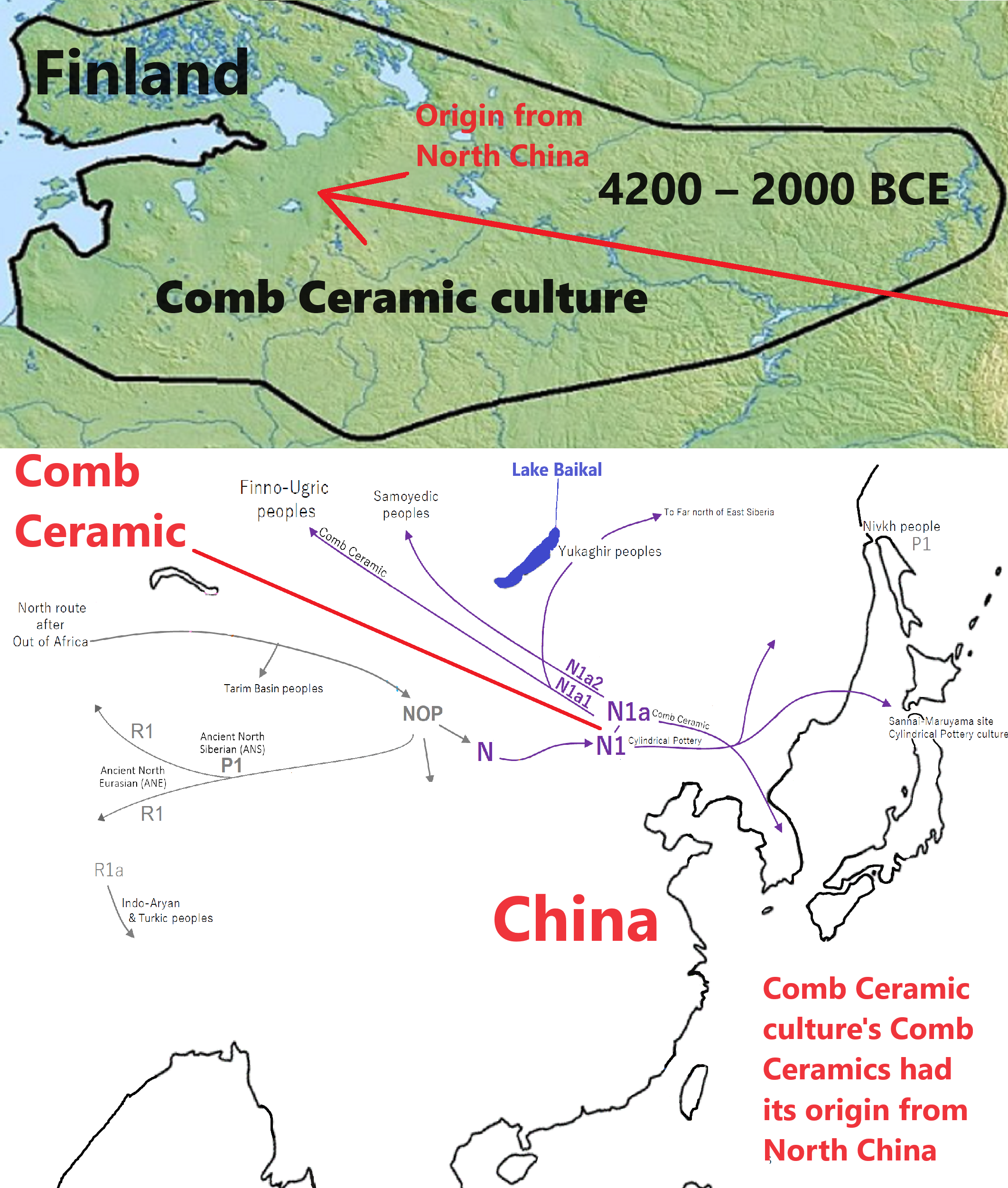
Comb Ceramic culture
“The Comb Ceramic culture or Pit-Comb Ware culture, often abbreviated as CCC or PCW, was a northeast European culture characterised by its Pit–Comb Ware. It existed from around 4200 BCE to around 2000 BCE. The bearers of the Comb Ceramic culture are thought to have still mostly followed the Mesolithic hunter-gatherer (Eastern Hunter-Gatherer) lifestyle, with traces of early agriculture. The distribution of the artifacts found includes Finnmark (Norway) in the north, the Kalix River (Sweden) and the Gulf of Bothnia (Finland) in the west and the Vistula River (Poland) in the south. It would include the Narva culture of Estonia and the Sperrings culture in Finland, among others. They are thought to have been essentially hunter-gatherers, though e.g. the Narva culture in Estonia shows some evidence of agriculture. Some of this region was absorbed by the later Corded Ware horizon. The Pit–Comb Ware culture is one of the few exceptions to the rule that pottery and farming coexist in Europe. In the Near East farming appeared before pottery, then when farming spread into Europe from the Near East, pottery-making came with it. However, in Asia, where the oldest pottery has been found, pottery was made long before farming. It appears that the Comb Ceramic Culture reflects influences from Siberia and distant China.” ref
“By dating according to the elevation of land, the ceramics have traditionally (Äyräpää 1930) been divided into the following periods: early (Ka I, c. 4200 BC – 3300 BC), typical (Ka II, c. 3300 BC – 2700 BC) and late Comb Ceramic (Ka III, c. 2800 BC – 2000 BC). However, calibrated radiocarbon dates for the comb-ware fragments found (e.g., in the Karelian isthmus), give a total interval of 5600 BC – 2300 BC (Geochronometria Vol. 23, pp 93–99, 2004). The settlements were located at sea shores or beside lakes and the economy was based on hunting, fishing, and the gathering of plants. In Finland, it was a maritime culture that became more and more specialized in hunting seals. The dominant dwelling was probably a teepee of about 30 square meters where some 15 people could live. Also, rectangular houses made of timber became popular in Finland from 4000 BC cal. Graves were dug at the settlements and the dead were covered with red ochre. The typical Comb Ceramic age shows an extensive use of objects made of flint and amber as grave offerings.” ref
“The stone tools changed very little over time. They were made of local materials such as slate and quartz. Finds suggest a fairly extensive exchange network: red slate originating from northern Scandinavia, asbestos from Lake Saimaa, green slate from Lake Onega, amber from the southern shores of the Baltic Sea, and flint from the Valdai area in northwestern Russia. The culture was characterized by small figurines of burnt clay and animal heads made of stone. The animal heads usually depict moose and bears and were derived from the art of the Mesolithic. There were also many rock paintings. There are sources noting that the typical comb ceramic pottery had a sense of luxury and that its makers knew how to wear precious amber pendants. The great westward dispersal of the Uralic languages is suggested to have happened long after the demise of the Comb Ceramic culture, perhaps in the 1st millennium BC.” ref
“Saag et al. (2017) analyzed three CCC individuals buried at Kudruküla as belonging to Y-hg R1a5-YP1272 (R1a1b~ after ISOGG 2020), along with three mtDNA samples of mt-hg U5b1d1, U4a and U2e1. Mittnik (2018) analyzed two CCC individuals. The male carried R1 (2021: R1b-M343) and U4d2, while the female carried U5a1d2b. Generally, the CCC individuals were mostly of Eastern Hunter-Gatherer (EHG) descent, with even more EHG than people of the Narva culture. Lamnidis et al. (2018) found 15% Western Hunter-Gatherer (WHG) ancestry, 65% Eastern Hunter-Gatherer (EHG) – higher than among earlier cultures of the eastern Baltic, and 20% Western Steppe Herder (WSH).” ref
Ritual, Religion, Elites, Language, and Civilization relating to Neolithic and Ancient China
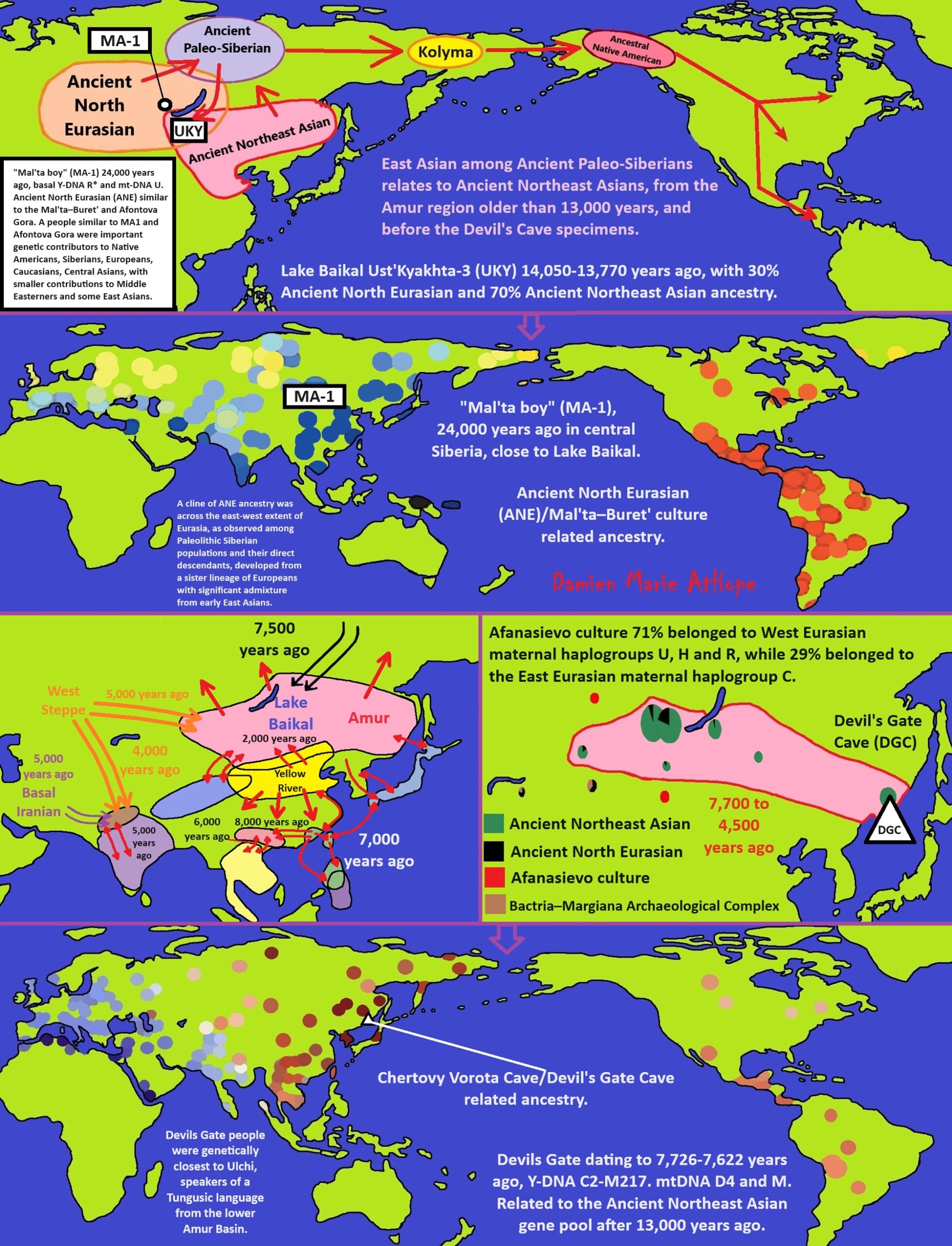
ref, ref, ref, ref, ref, ref, ref, ref, ref, ref, ref, ref, ref, ref, ref
“A 2016 study found that the global maximum of Ancient North Eurasian (ANE) ancestry occurs in modern-day Kets, Mansi, Native Americans, and Selkups. ANE ancestry has spread throughout Eurasia and the Americas in various migrations since the Upper Paleolithic, and more than half of the world’s population today derives between 5 and 42% of their genomes from the Ancient North Eurasians. Significant ANE ancestry can be found in Native Americans, as well as in regions of northern Europe, South Asia, Central Asia, and Siberia. It has been suggested that their mythology may have featured narratives shared by both Indo-European and some Native American cultures, such as the existence of a metaphysical world tree and a fable in which a dog guards the path to the afterlife.” ref
Ancient Northern East Asian/ later became Ancient Northeast Asian
Ancient Paleo-Siberian
Mal’ta–Buret’ culture (Mal’ta boy MA-1)
The Kolyma Shaitans: Legends and Reality (I only use just a small part)
“A unique “shaitan” burial was discovered on the bank of Omuk-Kuel Lake in the Middle-Kolyma ulus in Yakutia. According to the legends, buried in it are mummified remains of a shaman woman who died during a devastating smallpox epidemics in the 18th c. In an attempt to overcome the deadly disease, the shaman’s relatives used her remains as an emeget fetish. The author believes that these legends reflect the real events of those far-away years. The Arabic word “shaitan” came to the Russian language from Turkic languages. According to Islamic tradition, a shaitan is a genie, an evil spirit, a demon. During Russian colonization and Christianization of Siberia, all sacred things used by the aborigines as fetishes, patron spirits of the family, and the tribe, grew to be called “shaitans.” There are various facts, dating to the 18th and 19th cc., confirming that this word also referred to the mummified remains of outstanding shamans.” ref
“In the 1740s, a member of the Second Kamchatka Expedition Yakov Lindenau wrote, “Meat is scratched off the [shaman’s] bones and the bones are put together to form a skeleton, which is dressed in human’s clothes and worshipped as a deity. The Yukagirs place such dressed bones…in their yurts, their number can sometimes reach 10 or 15. If somebody commits even a minor sacrilege with respect to these bones, he stirs up rancor on the part of the Yukagirs… While traveling and hunting, the Yukagirs carry these bones in their sledges, and moreover, in their best sledges pulled by their best deer. When the Yukagirs are going to undertake something really important, they tell fortune using these skeletons: lift a skeleton up, and if it seems light, it means that their enterprise will have a favorable outcome. The Yukagirs call these skeletons stariks (old men), endow them with their best furs, and sit them on beds covered with deer hides, in a circle, as though they are alive.” (Lindenau, 1983, p. 155)” ref
“In the late 19th c., a famous explorer of aboriginal culture V. I. Jochelson noted the changes that occurred in the ritual in the last century and a half. So, the Yukagirs divided among themselves the shaman’s meat dried in the sun and then put it in separate tents. The dead bodies of killed dogs were left there as well. “After that,” V. I. Jochelson writes, “they would divide the shaman’s bones, dry them and wrap in clothes. The skull was an object of worshipping. It was put on top of a trunk (body) cut out of wood. A caftan and two hats – a winter and a summer one – were sewn for the idol. The caftan was all embroidered. On the skull, a special mask was put, with holes for the eyes and the mouth… The figure was placed in the front corner of the home. Before a meal, a piece of food was thrown into the fire and the idol was held above it. This feeding of the idol… was committed before each meal.” (V. I. Jochelson, 2005, pp. 236—237)” ref
“The idol was kept by the children of the dead shaman. One of them was inducted into the shamanism mysteries while his father was still alive. The idol was carried in a wooden box. Sometimes, in line with the air burial ritual, the box was erected on poles or trees, and the idol was taken out only before hunting or a long journey so that the outcome of the enterprise planned could be predicted. With time, the Yukagirs began using wooden idols as charms. V. I. Jochelson notes that by the late 19th c. the Yukagirs had developed a skeptical attitude towards idols and referred to them as “shaitans.” In this way, under the influence of Christianity, the worshipped ancestor’s spirit turned into its opposite – an evil spirit, a devil, a Satan.” ref
Ancestral Native American, Ancient Beringian
14,000-year-old Ust-Kyakhta-3 (UKY) individual found near Lake Baikal
Chertovy Vorota Cave/Devil’s Gate Cave
Bactria–Margiana Archaeological Complex
32,000-21,000 years ago Yana Culture, at the Yana Woolly Rhinoceros Horn Site in Siberia, with genetic proximity to Ancient North Eurasian populations (Mal’ta and Afontova Gora), but also Ust-Ishim, Sunghir, and to a lesser extent Tianyuan, as well as similarities with the Clovis culture

“The “Ancient North Eurasian” (ANE) network, consisted of several Paleolithic Siberian samples and contributed ancestry towards later groups one of which was the Neolithic Iranian farmers. The ANE lineage is defined by association with the MA-1, or “Mal’ta boy“, the remains of an individual who lived during the Last Glacial Maximum, 24,000 years ago in central Siberia. In archaeogenetics, the term Ancient North Eurasian (often abbreviated as ANE) is the name given to an ancestral West Eurasian component that represents descent from the people similar to the Mal’ta–Buret’ culture and populations closely related to them, such as from Afontova Gora and the Yana Rhinoceros Horn Site. Significant ANE ancestry are found in some modern populations, including North east Europeans, South central Asians, And Native Americans.” ref
“Haplogroup R* Y-DNA (xR1, R2) was found in 24,000-year-old remains from Mal’ta in Siberia near Lake Baikal. Only one confirmed example of basal R* has been found, in 24,000 year old remains, known as MA1, found at Mal’ta–Buret’ culture near Lake Baikal in Siberia.” ref
“Iran Neolithic (Iran_N) individuals dated ~8.5 kya carried 50% “Ancient North Eurasian” ANE-derived admixture and 50% Dzudzuana-related admixture, marking them as different from other Near-Eastern and Anatolian Neolithics who didn’t have ANE admixture. Iran Neolithics were later replaced by Iran Chalcolithics, who were a mixture of Iran Neolithic and Near Eastern Levant Neolithic.” ref
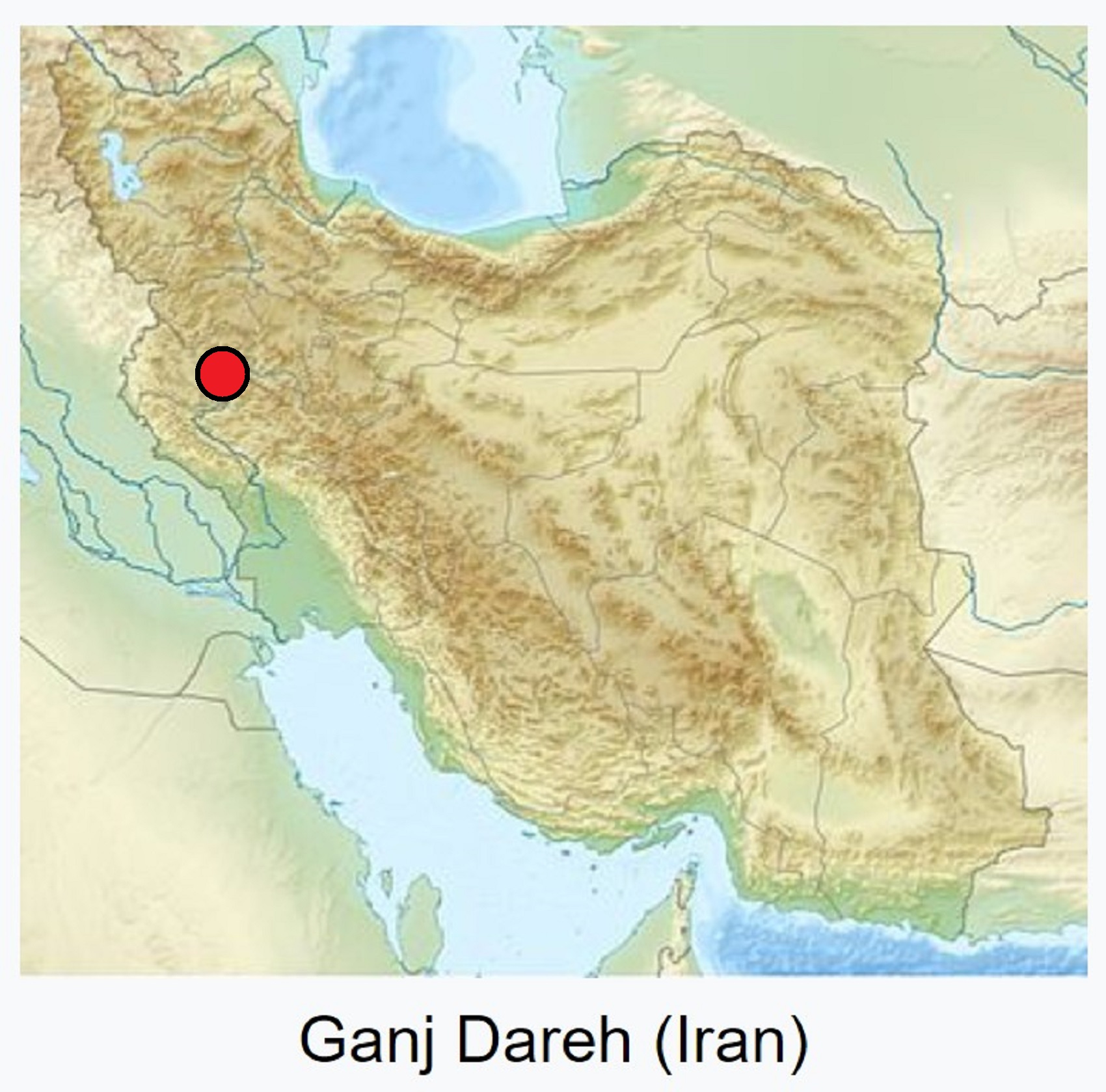
“The oldest sample of haplogroup R2a was observed in the remains of a Neolithic human from Ganj Dareh in western Iran. Ganj Dareh is important in the study of Neolithic ceramics in Luristan and Kurdistan. This is a period beginning in the late 8th millennium, and continuing to the middle of the 6th millennium BCE. Also, the evidence from two other excavated sites nearby is important, from Tepe Guran, and Tepe Sarab (shown on the map in this article). They are all located southwest of Harsin, on the Mahidasht plain, and in the Hulailan valley.” ref
“At Ganj Dareh, a Neolithic settlement in western Iran. It is located in the Harsin County east of Kermanshah Province, in the central Zagros Mountains there were two early ceramic traditions evident. One is based on the use of clay for figurines and small geometric pieces like cones and disks. These are dated ca. 7300-6900 BCE. The other ceramic tradition originated in the use of clay for mud-walled buildings (ca. 7300 BCE). These traditions are also shared by Tepe Guran, and Tepe Sarab. Tepe Asiab is also located near Tepe Sarab, and may be the earliest of all these sites. Both sites appear to have been seasonally occupied. Another site from the same period is Chia Jani, also in Kermanshah. Chia Jani is located about 60km southwest from Ganj Dareh. Ali Kosh is also a related site of the Neolithic period.” ref
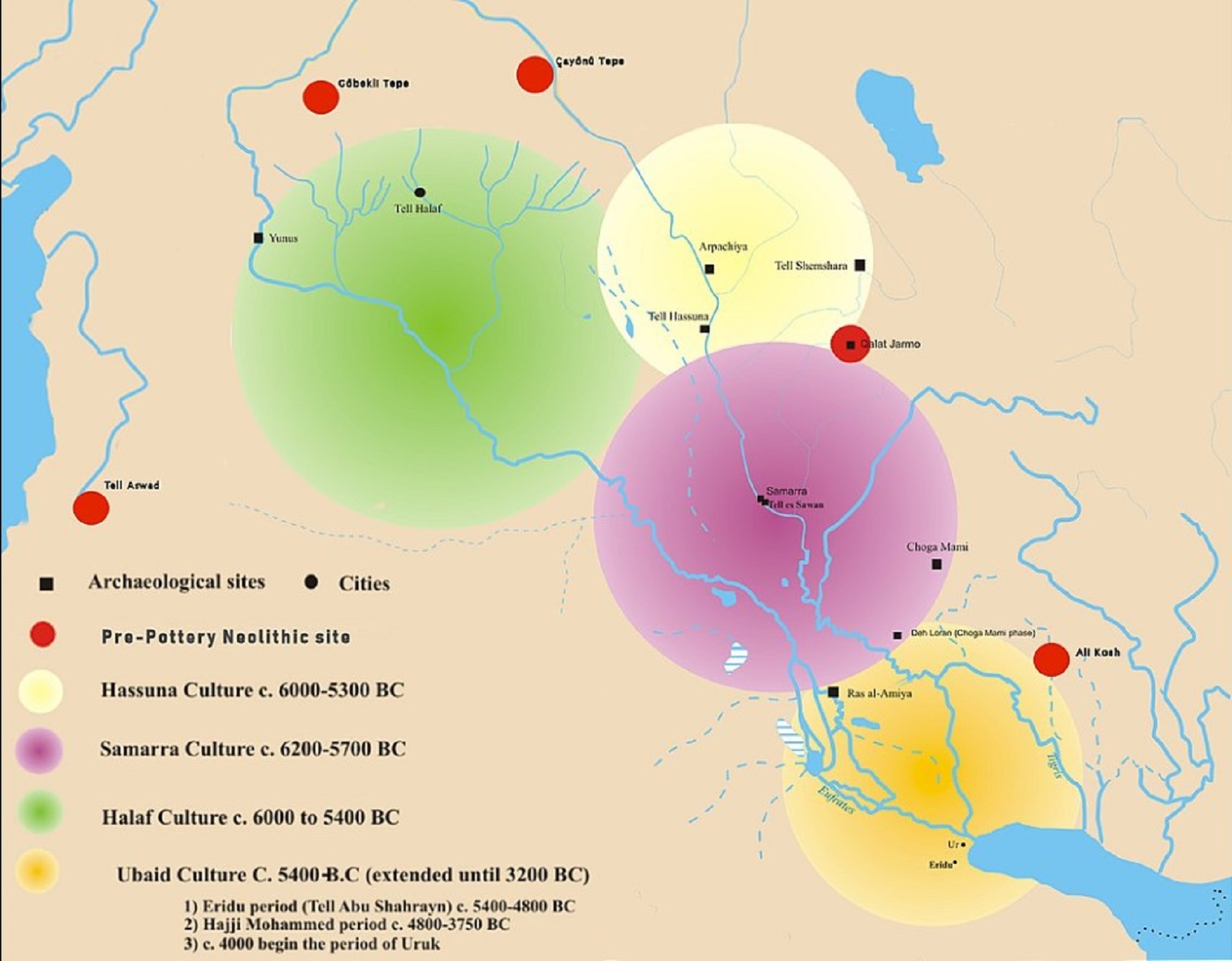
“Hassuna culture (in yellow), next to Samarra, Halaf, and Ubaid cultures.” ref
Hassuna culture
“Pre-Proto-Hassuna: More recently, the concept of a very early ‘Pre-Proto-Hassuna’ pottery tradition has been introduced by some scholars. This has been prompted by more recent discoveries of still earlier pottery traditions. Pre-Proto-Hassuna refers to the Late Neolithic period in Upper Mesopotamia when the ceramic containers were just being introduced. The pottery vessels were still very few in number in these early settlements. At that time, the main emphasis was on the pottery with a mineral temper, as opposed to the plant-tempered pottery which came to predominate later.” ref
“The time frame for this period was about 7000-6700 BCE, and at this time stone vessels and White Ware were still being used in addition to pottery. Nevertheless, all of these nomenclatures may refer to quite similar types of pottery, depending on some specific geographic region of Upper Mesopotamia.” ref
“Because of the narrow local emphasis in many pottery studies as of now, these earliest pottery traditions may be known in the literature as:
- Pre-Proto-Hassuna (in Khabur, and northern Iraq)
- Initial Pottery Neolithic (in Balikh River area, for example, Tell Sabi Abyad)
- Transitional (in the Turkish Euphrates area; the main sites are Mezraa Teleilat and Akarcay Tepe, with pottery dated to c. 6800 BCE)
- Halula I (in the Syrian Euphrates area; the main site is Tell Halula)
- Rouj 2a (in Northern Levant); several archaeological sites are located in the Rouj basin, Idlib, Syria).” ref
“Proto-Hassuna: This period denotes a higher use of ceramics than with the pre-proto-Hassuna period. The site of Umm Dabaghiyah (de:Umm Dabaghiyah-Sotto-Kultur), in the same area of Iraq, is believed to have the earliest pottery in this region, and is sometimes described as a ‘Proto-Hassuna culture’ site. Other related sites in the area are Sotto and Yarim Tepe I, having 585 recorded ceramic fragments. They were found by archaeologist A.A. Bobrinsky. Another pre-Hassuna or proto-Hassuna site in Iraq is Tell Maghzaliyah. Yet another site with proto-Hassuna pottery is Ginnig. The time frame for this period was about 6700-6300 BCE.” ref
“Archaic Hassuna: ‘Archaic Hassuna’ has been introduced more recently as a new period different to proto-Hassuna. This period is recorded to have a decrease in the concentration of dung in ceramic production and an increase in the use of two-layer slabs in construction, although they were used prior to this period. During this timeframe, pottery kilns start to show up in many sites. The changing patterns within pottery may also connect with an increase in cultural diffusion. The type site, Tell Hassuna, is also recorded to possess Archaic Hassuna artifacts. The time frame for this period was about 6300-6000 BCE.” ref
“The Hassuna culture is a Neolithic archaeological culture in northern Mesopotamia dating to the early sixth millennium BCE. It is named after the type site of Tell Hassuna in Iraq. Other sites where Hassuna material has been found include Tell Shemshara. By around 6000 BC people had moved into the foothills (piedmont) of northernmost Mesopotamia where there was enough rainfall to allow for “dry” agriculture in some places. These were the first farmers in northernmost Mesopotamia. They made Hassuna-style pottery (cream slip with reddish paint in linear designs). Hassuna people lived in small villages or hamlets ranging 2–8 acres (0.81–3.24 ha).” ref
“At Tell Hassuna, adobe dwellings built around open central courts with fine painted pottery replace earlier levels with crude pottery. Hand axes, sickles, grinding stones, bins, baking ovens, and numerous bones of domesticated animals reflect settled agricultural life. Female figurines have been related to worship and jar burials within which food was placed related to belief in an afterlife. The relationship of Hassuna pottery to that of Jericho suggests that village culture was becoming widespread.” ref
Samarra culture
“The Samarra culture is a Late Neolithic archaeological culture of northern Mesopotamia, roughly dated to between 5500 and 4800 BCE. It partially overlaps with Hassuna and early Ubaid. Samarran material culture was first recognized during excavations by German Archaeologist Ernst Herzfeld at the site of Samarra. Other sites where Samarran material has been found include Tell Shemshara, Tell es-Sawwan, and Yarim Tepe.” ref
“At Tell es-Sawwan, evidence of irrigation—including flax—establishes the presence of a prosperous settled culture with a highly organized social structure. The culture is primarily known for its finely made pottery decorated with stylized animals, including birds, and geometric designs on dark backgrounds. This widely exported type of pottery, one of the first widespread, relatively uniform pottery styles in the Ancient Near East, was first recognized at Samarra.” ref
“The Samarran Culture was the precursor to the Mesopotamian culture of the Ubaid period. At Tell Sabi Abyad and other Late Neolithic sites in Syria, scholars adopt increasingly vague terms such as Samarra “influenced”, Samarra-“related” or even Samarra “impulses”, largely because we do not understand the relationships with the traditional Samarra heartlands. The term may be extended to include sites in Syria such as Tell Chagar Bazar, Tell Boueid II, Tell Sabi Abyad, or Tell Halula, where similar pottery is currently being excavated in Pre-Halaf to Early Halaf Transitional contexts.” ref
Halaf culture
“The Halaf culture is a prehistoric period which lasted between about 6100 and 5100 BCE. The period is a continuous development out of the earlier Pottery Neolithic and is located primarily in the fertile valley of the Khabur River (Nahr al-Khabur), of south-eastern Turkey, Syria, and northern Iraq, although Halaf-influenced material is found throughout Greater Mesopotamia.” ref
“While the period is named after the site of Tell Halaf in north Syria, the earliest Halaf period material was excavated at the site of Sakce Gözü, then in Syria but now part of Turkey. Small amounts of Halaf material were also excavated at Carchemish, on the Turkish/Syrian border. However, the most important site for the Halaf tradition was the site of Tell Arpachiyah, now located in the suburbs of Mosul, Iraq. The Halaf period was succeeded by the Halaf-Ubaid Transitional period which comprised the late Halaf (c. 5400–5000 BCE), and then by the Ubaid period.” ref
“Previously, the Syrian plains were not considered as the homeland of Halaf culture, and the Halafians were seen either as hill people who descended from the nearby mountains of southeastern Anatolia, or herdsmen from northern Iraq. However, those views changed, which has produced new insights and perspectives about the rise of Halaf culture. A formerly unknown transitional culture between the pre-Halaf Neolithic‘s era and Halaf’s era was uncovered in the Balikh valley, at Tell Sabi Abyad (the Mound of the White Boy). The Halaf culture saw the earliest known appearance of stamp seals in the Near East. They featured essentially geometric patterns.” ref
“Currently, eleven occupational layers have been unearthed in Sabi Abyad. Levels from 11 to 7 are considered pre-Halaf; from 6 to 4, transitional; and from 3 to 1, early Halaf. No hiatus in occupation is observed except between levels 11 and 10. The new archaeology demonstrated that Halaf culture was not sudden and was not the result of foreign people, but rather a continuous process of indigenous cultural changes in northern Syria, that spread to the other regions. Halaf pottery has been found in other parts of northern Mesopotamia, such as at Nineveh and Tepe Gawra, Chagar Bazar, Tell Amarna, and at many sites in Anatolia (Turkey) suggesting that it was widely used in the region.” ref
“Halaf culture ended by 5000 BCE after entering the so-called Halaf-Ubaid Transitional period. Many Halafian settlements were abandoned, and the remaining ones showed Ubaidian characters. The new period is named Northern Ubaid to distinguish it from the proper Ubaid in southern Mesopotamia, and two explanations were presented for the transformation. The first maintains an invasion and a replacement of the Halafians by the Ubaidians, however, there is no hiatus between the Halaf and northern Ubaid which excludes the invasion theory. The most plausible theory is a Halafian adoption of the Ubaid culture, which is supported by most scholars including Oates, Breniquet, and Akkermans.” ref
Ubaid period
“The Ubaid period (c. 6500–3800 BCE) is a prehistoric period of Mesopotamia. The name derives from Tell al-‘Ubaid where the earliest large excavation of Ubaid period material was conducted initially in 1919 by Henry Hall and later by Leonard Woolley. In South Mesopotamia, the period is the earliest known period on the alluvial plain although it is likely earlier periods exist obscured under the alluvium. In the south, it has a very long duration between about 6500 and 3800 BCE when it is replaced by the Uruk period. In Northern Mesopotamia, the period runs only between about 5300 and 4300 BCE. It is preceded by the Halaf period and the Halaf-Ubaid Transitional period and succeeded by the Late Chalcolithic period.” ref
“The Ubaid period is divided into four principal phases:
- Ubaid 0, sometimes called Oueili, (6500–5400 BCE), an early Ubaid phase first excavated at Tell el-‘Oueili.
- Ubaid 1, sometimes called Eridu corresponding to the city Eridu, (5400–4700 BCE), a phase limited to the extreme south of Iraq, on what was then the shores of the Persian Gulf. This phase, showing a clear connection to the Samarra culture to the north, saw the establishment of the first permanent settlement south of the 5-inch rainfall isohyet. These people pioneered the growing of grains in the extreme conditions of aridity, thanks to the high water tables of Southern Iraq.
- Ubaid 2 (4800–4500 BCE). At that time, Hadji Muhammed-style ceramics were produced. This period also saw the development of extensive canal networks near major settlements. Irrigation agriculture, which seems to have developed first at Choga Mami (4700–4600 BCE) and rapidly spread elsewhere, form the first required collective effort and centralized coordination of labor in Mesopotamia.
- Ubaid 3: Tell al‐Ubaid style ceramics were dated c. 5300–4700 BCE. The appearance of these ceramics received different dates depending on the particular sites, which have a wide geographical distribution. In recent studies, there’s a tendency to narrow this period somewhat.
- Ubaid 4: Late Ubaid style ceramics, c.4700–4200 BCE.” ref
Indus Valley Civilization (5500–2000 BCE)
“The Fertile Crescent in the Ancient Near East is one of the independent origins of the Neolithic, the source from which farming and pottery-making spread across Europe from 9,000 to 6,000 years ago at an average rate of about 1 km/yr. There is also strong evidence for causal connections between the Near-Eastern Neolithic and that further east, up to the Indus Valley. There are several lines of evidence that support the idea of a connection between the Neolithic in the Near East and in the Indian subcontinent. The prehistoric site of Mehrgarh in Baluchistan (modern Pakistan) is the earliest Neolithic site in the north-west Indian subcontinent, dated as early as 8500 BCE.” ref
“Neolithic domesticated crops in Mehrgarh include more than barley and a small amount of wheat. There is good evidence for the local domestication of barley and the zebu cattle at Mehrgarh, but the wheat varieties are suggested to be of Near-Eastern origin, as the modern distribution of wild varieties of wheat is limited to Northern Levant and Southern Turkey. A detailed satellite map study of a few archaeological sites in the Baluchistan and Khybar Pakhtunkhwa regions also suggests similarities in early phases of farming with sites in Western Asia.” ref
“Pottery prepared by sequential slab construction, circular fire pits filled with burnt pebbles, and large granaries are common to both Mehrgarh and many Mesopotamian sites. The postures of the skeletal remains in graves at Mehrgarh bear a strong resemblance to those at Ali Kosh in the Zagros Mountains of southern Iran. Despite their scarcity, the 14C and archaeological age determinations for early Neolithic sites in Southern Asia exhibit remarkable continuity across the vast region from the Near East to the Indian Subcontinent, consistent with a systematic eastward spread at a speed of about 0.65 km/yr.” ref
“During the Mehrgarh Culture, a precursor of the Indus Valley civilization, Period II (5500–4800 BCE) and Merhgarh Period III (4800–3500 BCE) were ceramic Neolithic, using pottery, and later chalcolithic. Period II is at site MR4 and Period III is at MR2. Much evidence of manufacturing activity has been found and more advanced techniques were used. Glazed faience beads were produced and terracotta figurines became more detailed. Figurines of females were decorated with paint and had diverse hairstyles and ornaments. Two flexed burials were found in Period II with a red ochre cover on the body. The amount of burial goods decreased over time, becoming limited to ornaments and with more goods left with burials of females.” ref
“The first button seals were produced from terracotta and bone and had geometric designs. Technologies included stone and copper drills, updraft kilns, large pit kilns, and copper melting crucibles. There is further evidence of long-distance trade in Period II: important as an indication of this is the discovery of several beads of lapis lazuli, once again from Badakshan. Mehrgarh Periods II and III are also contemporaneous with an expansion of the settled populations of the borderlands at the western edge of South Asia, including the establishment of settlements like Rana Ghundai, Sheri Khan Tarakai, Sarai Kala, Jalilpur, and Ghaligai.” ref
But is Atlantis real?
No. Atlantis (an allegory: “fake story” interpreted to reveal a hidden meaning) can’t be found any more than one can locate the Jolly Green Giant that is said to watch over frozen vegetables. Lol


May Reason Set You Free
There are a lot of truly great things said by anarchists in history, and also some deeply vile things, too, from not supporting Women’s rights to Anti-Semitism. There are those who also reject those supporting women’s rights as well as fight anti-Semitism. This is why I push reason as my only master, not anarchist thinking, though anarchism, to me, should see all humans everywhere as equal in dignity and rights.
We—Cory and Damien—are following the greatness that can be found in anarchist thinking.
As an Anarchist Educator, Damien strives to teach the plain truth. Damien does not support violence as my method to change. Rather, I choose education that builds Enlightenment and Empowerment. I champion Dignity and Equality. We rise by helping each other. What is the price of a tear? What is the cost of a smile? How can we see clearly when others pay the cost of our indifference and fear? We should help people in need. Why is that so hard for some people? Rich Ghouls must End. Damien wants “billionaires” to stop being a thing. Tax then into equality. To Damien, there is no debate, Capitalism is unethical. Moreover, as an Anarchist Educator, Damien knows violence is not the way to inspire lasting positive change. But we are not limited to violence, we have education, one of the most lasting and powerful ways to improve the world. We empower the world by championing Truth and its supporters.
Anarchism and Education
“Various alternatives to education and their problems have been proposed by anarchists which have gone from alternative education systems and environments, self-education, advocacy of youth and children rights, and freethought activism.” ref
“Historical accounts of anarchist educational experiments to explore how their pedagogical practices, organization, and content constituted a radical alternative to mainstream forms of educational provision in different historical periods.” ref
“The Ferrer school was an early 20th century libertarian school inspired by the anarchist pedagogy of Francisco Ferrer. He was a proponent of rationalist, secular education that emphasized reason, dignity, self-reliance, and scientific observation. The Ferrer movement’s philosophy had two distinct tendencies: non-didactic freedom from dogma and the more didactic fostering of counter-hegemonic beliefs. Towards non-didactic freedom from dogma, and fulfilled the child-centered tradition.” ref

Teach Real History: all our lives depend on it.
Damien sees lies about history as crimes against humanity. And we all must help humanity by addressing “any and all” who make harmful lies about history.
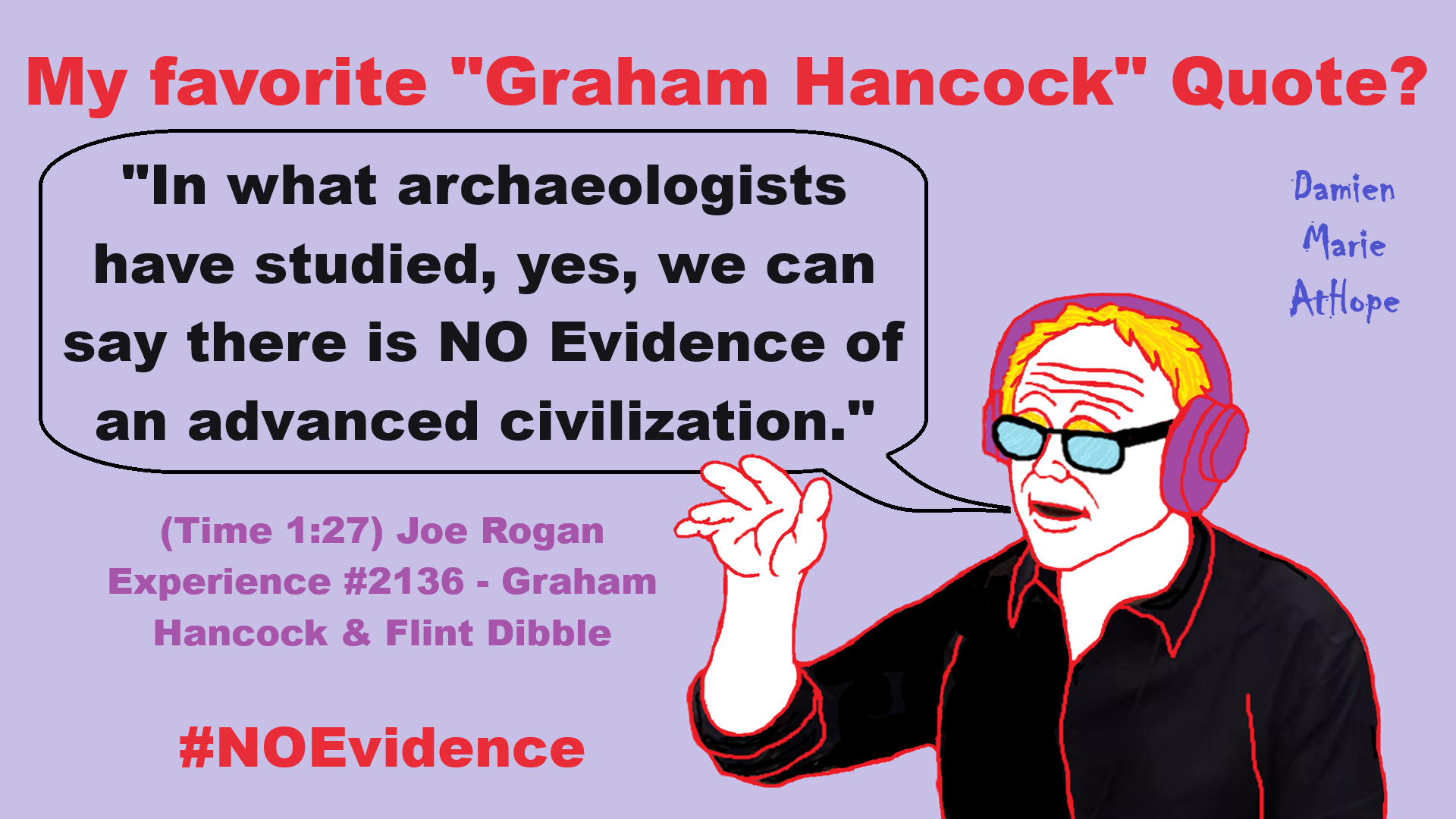
My favorite “Graham Hancock” Quote?
“In what archaeologists have studied, yes, we can say there is NO Evidence of an advanced civilization.” – (Time 1:27) Joe Rogan Experience #2136 – Graham Hancock & Flint Dibble

People don’t commonly teach religious history, even that of their own claimed religion. No, rather they teach a limited “pro their religion” history of their religion from a religious perspective favorable to the religion of choice.

Do you truly think “Religious Belief” is only a matter of some personal choice?
Do you not see how coercive one’s world of choice is limited to the obvious hereditary belief, in most religious choices available to the child of religious parents or caregivers? Religion is more commonly like a family, culture, society, etc. available belief that limits the belief choices of the child and that is when “Religious Belief” is not only a matter of some personal choice and when it becomes hereditary faith, not because of the quality of its alleged facts or proposed truths but because everyone else important to the child believes similarly so they do as well simply mimicking authority beliefs handed to them. Because children are raised in religion rather than being presented all possible choices but rather one limited dogmatic brand of “Religious Belief” where children only have a choice of following the belief as instructed, and then personally claim the faith hereditary belief seen in the confirming to the belief they have held themselves all their lives. This is obvious in statements asked and answered by children claiming a faith they barely understand but they do understand that their family believes “this or that” faith, so they feel obligated to believe it too. While I do agree that “Religious Belief” should only be a matter of some personal choice, it rarely is… End Hereditary Religion!

Animism: Respecting the Living World by Graham Harvey
“How have human cultures engaged with and thought about animals, plants, rocks, clouds, and other elements in their natural surroundings? Do animals and other natural objects have a spirit or soul? What is their relationship to humans? In this new study, Graham Harvey explores current and past animistic beliefs and practices of Native Americans, Maori, Aboriginal Australians, and eco-pagans. He considers the varieties of animism found in these cultures as well as their shared desire to live respectfully within larger natural communities. Drawing on his extensive casework, Harvey also considers the linguistic, performative, ecological, and activist implications of these different animisms.” ref

We are like believing machines we vacuum up ideas, like Velcro sticks to almost everything. We accumulate beliefs that we allow to negatively influence our lives, often without realizing it. Our willingness must be to alter skewed beliefs that impend our balance or reason, which allows us to achieve new positive thinking and accurate outcomes.

My thoughts on Religion Evolution with external links for more info:
- (Pre-Animism Africa mainly, but also Europe, and Asia at least 300,000 years ago), (Pre-Animism – Oxford Dictionaries)
- (Animism Africa around 100,000 years ago), (Animism – Britannica.com)
- (Totemism Europe around 50,000 years ago), (Totemism – Anthropology)
- (Shamanism Siberia around 30,000 years ago), (Shamanism – Britannica.com)
- (Paganism Turkey around 12,000 years ago), (Paganism – BBC Religion)
- (Progressed Organized Religion “Institutional Religion” Egypt around 5,000 years ago), (Ancient Egyptian Religion – Britannica.com)
- (CURRENT “World” RELIGIONS after 4,000 years ago) (Origin of Major Religions – Sacred Texts)
- (Early Atheistic Doubting at least by 2,600 years ago) (History of Atheism – Wikipedia)
“Religion is an Evolved Product” and Yes, Religion is Like Fear Given Wings…
Atheists talk about gods and religions for the same reason doctors talk about cancer, they are looking for a cure, or a firefighter talks about fires because they burn people and they care to stop them. We atheists too often feel a need to help the victims of mental slavery, held in the bondage that is the false beliefs of gods and the conspiracy theories of reality found in religions.
Understanding Religion Evolution:
- Pre-Animism (at least 300,000 years ago)
- Animism (Africa: 100,000 years ago)
- Totemism (Europe: 50,000 years ago)
- Shamanism (Siberia: 30,000 years ago)
- Paganism (Turkey: 12,000 years ago)
- Progressed organized religion (Egypt: 5,000 years ago), (Egypt, the First Dynasty 5,150 years ago)
- CURRENT “World” RELIGIONS (after 4,000 years ago)
- Early Atheistic Doubting (at least by 2,600 years ago)
“An Archaeological/Anthropological Understanding of Religion Evolution”
It seems ancient peoples had to survived amazing threats in a “dangerous universe (by superstition perceived as good and evil),” and human “immorality or imperfection of the soul” which was thought to affect the still living, leading to ancestor worship. This ancestor worship presumably led to the belief in supernatural beings, and then some of these were turned into the belief in gods. This feeble myth called gods were just a human conceived “made from nothing into something over and over, changing, again and again, taking on more as they evolve, all the while they are thought to be special,” but it is just supernatural animistic spirit-belief perceived as sacred.
Quick Evolution of Religion?
Pre-Animism (at least 300,000 years ago) pre-religion is a beginning that evolves into later Animism. So, Religion as we think of it, to me, all starts in a general way with Animism (Africa: 100,000 years ago) (theoretical belief in supernatural powers/spirits), then this is physically expressed in or with Totemism (Europe: 50,000 years ago) (theoretical belief in mythical relationship with powers/spirits through a totem item), which then enlists a full-time specific person to do this worship and believed interacting Shamanism (Siberia/Russia: 30,000 years ago) (theoretical belief in access and influence with spirits through ritual), and then there is the further employment of myths and gods added to all the above giving you Paganism (Turkey: 12,000 years ago) (often a lot more nature-based than most current top world religions, thus hinting to their close link to more ancient religious thinking it stems from). My hypothesis is expressed with an explanation of the building of a theatrical house (modern religions development). Progressed organized religion (Egypt: 5,000 years ago) with CURRENT “World” RELIGIONS (after 4,000 years ago).
Historically, in large city-state societies (such as Egypt or Iraq) starting around 5,000 years ago culminated to make religion something kind of new, a sociocultural-governmental-religious monarchy, where all or at least many of the people of such large city-state societies seem familiar with and committed to the existence of “religion” as the integrated life identity package of control dynamics with a fixed closed magical doctrine, but this juggernaut integrated religion identity package of Dogmatic-Propaganda certainly did not exist or if developed to an extent it was highly limited in most smaller prehistoric societies as they seem to lack most of the strong control dynamics with a fixed closed magical doctrine (magical beliefs could be at times be added or removed). Many people just want to see developed religious dynamics everywhere even if it is not. Instead, all that is found is largely fragments until the domestication of religion.
Religions, as we think of them today, are a new fad, even if they go back to around 6,000 years in the timeline of human existence, this amounts to almost nothing when seen in the long slow evolution of religion at least around 70,000 years ago with one of the oldest ritual worship. Stone Snake of South Africa: “first human worship” 70,000 years ago. This message of how religion and gods among them are clearly a man-made thing that was developed slowly as it was invented and then implemented peace by peace discrediting them all. Which seems to be a simple point some are just not grasping how devastating to any claims of truth when we can see the lie clearly in the archeological sites.
I wish people fought as hard for the actual values as they fight for the group/clan names political or otherwise they think support values. Every amount spent on war is theft to children in need of food or the homeless kept from shelter.
Here are several of my blog posts on history:
- To Find Truth You Must First Look
- (Magdalenian/Iberomaurusian) Connections to the First Paganists of the early Neolithic Near East Dating from around 17,000 to 12,000 Years Ago
- Natufians: an Ancient People at the Origins of Agriculture and Sedentary Life
- Possible Clan Leader/Special “MALE” Ancestor Totem Poles At Least 13,500 years ago?
- Jewish People with DNA at least 13,200 years old, Judaism, and the Origins of Some of its Ideas
- Baltic Reindeer Hunters: Swiderian, Lyngby, Ahrensburgian, and Krasnosillya cultures 12,020 to 11,020 years ago are evidence of powerful migratory waves during the last 13,000 years and a genetic link to Saami and the Finno-Ugric peoples.
- The Rise of Inequality: patriarchy and state hierarchy inequality
- Fertile Crescent 12,500 – 9,500 Years Ago: fertility and death cult belief system?
- 12,400 – 11,700 Years Ago – Kortik Tepe (Turkey) Pre/early-Agriculture Cultic Ritualism
- Ritualistic Bird Symbolism at Gobekli Tepe and its “Ancestor Cult”
- Male-Homosexual (female-like) / Trans-woman (female) Seated Figurine from Gobekli Tepe
- Could a 12,000-year-old Bull Geoglyph at Göbekli Tepe relate to older Bull and Female Art 25,000 years ago and Later Goddess and the Bull cults like Catal Huyuk?
- Sedentism and the Creation of goddesses around 12,000 years ago as well as male gods after 7,000 years ago.
- Alcohol, where Agriculture and Religion Become one? Such as Gobekli Tepe’s Ritualistic use of Grain as Food and Ritual Drink
- Neolithic Ritual Sites with T-Pillars and other Cultic Pillars
- Paganism: Goddesses around 12,000 years ago then Male Gods after 7,000 years ago
- First Patriarchy: Split of Women’s Status around 12,000 years ago & First Hierarchy: fall of Women’s Status around 5,000 years ago.
- Natufians: an Ancient People at the Origins of Agriculture and Sedentary Life
- J DNA and the Spread of Agricultural Religion (paganism)
- Paganism: an approximately 12,000-year-old belief system
- Paganism 12,000 years old: related to “Anarchism and Socialism” (Pre-Capitalism)
- Shaman burial in Israel 12,000 years ago and the Shamanism Phenomena
- Need to Mythicized: gods and goddesses
- 12,000 – 7,000 Years Ago – Paleo-Indian Culture (The Americas)
- 12,000 – 2,000 Years Ago – Indigenous-Scandinavians (Nordic)
- Norse did not wear helmets with horns?
- Pre-Pottery Neolithic Skull Cult around 11,500 to 8,400 Years Ago?
- 10,400 – 10,100 Years Ago, in Turkey the Nevail Cori Religious Settlement
- 9,000-6,500 Years Old Submerged Pre-Pottery/Pottery Neolithic Ritual Settlements off Israel’s Coast
- Catal Huyuk “first religious designed city” around 9,500 to 7,700 years ago (Turkey)
- Cultic Hunting at Catal Huyuk “first religious designed city”
- Special Items and Art as well as Special Elite Burials at Catal Huyuk
- New Rituals and Violence with the appearance of Pottery and People?
- Haplogroup N and its related Uralic Languages and Cultures
- Ainu people, Sámi people, Native Americans, the Ancient North Eurasians, and Paganistic-Shamanism with Totemism
- Ideas, Technology and People from Turkey, Europe, to China and Back again 9,000 to 5,000 years ago?
- First Pottery of Europe and the Related Cultures
- 9,000 years old Neolithic Artifacts Judean Desert and Hills Israel
- 9,000-7,000 years-old Sex and Death Rituals: Cult Sites in Israel, Jordan, and the Sinai
- 9,000-8500 year old Horned Female shaman Bad Dürrenberg Germany
- Neolithic Jewelry and the Spread of Farming in Europe Emerging out of West Turkey
- 8,600-year-old Tortoise Shells in Neolithic graves in central China have Early Writing and Shamanism
- Swing of the Mace: the rise of Elite, Forced Authority, and Inequality begin to Emerge 8,500 years ago?
- Migrations and Changing Europeans Beginning around 8,000 Years Ago
- My “Steppe-Anatolian-Kurgan hypothesis” 8,000/7,000 years ago
- Around 8,000-year-old Shared Idea of the Mistress of Animals, “Ritual” Motif
- Pre-Columbian Red-Paint (red ochre) Maritime Archaic Culture 8,000-3,000 years ago
- 7,522-6,522 years ago Linear Pottery culture which I think relates to Arcane Capitalism’s origins
- Arcane Capitalism: Primitive socialism, Primitive capital, Private ownership, Means of production, Market capitalism, Class discrimination, and Petite bourgeoisie (smaller capitalists)
- 7,500-4,750 years old Ritualistic Cucuteni-Trypillian culture of Moldova, Romania, and Ukraine
- Roots of a changing early society 7,200-6,700 years ago Jordan and Israel
- Agriculture religion (Paganism) with farming reached Britain between about 7,000 to 6,500 or so years ago and seemingly expressed in things like Western Europe’s Long Barrows
- My Thoughts on Possible Migrations of “R” DNA and Proto-Indo-European?
- “Millet” Spreading from China 7,022 years ago to Europe and related Language may have Spread with it leading to Proto-Indo-European
- Proto-Indo-European (PIE), ancestor of Indo-European languages: DNA, Society, Language, and Mythology
- The Dnieper–Donets culture and Asian varieties of Millet from China to the Black Sea region of Europe by 7,022 years ago
- Kurgan 6,000 years ago/dolmens 7,000 years ago: funeral, ritual, and other?
- 7,020 to 6,020-year-old Proto-Indo-European Homeland of Urheimat or proposed home of their Language and Religion
- Ancient Megaliths: Kurgan, Ziggurat, Pyramid, Menhir, Trilithon, Dolman, Kromlech, and Kromlech of Trilithons
- The Mytheme of Ancient North Eurasian Sacred-Dog belief and similar motifs are found in Indo-European, Native American, and Siberian comparative mythology
- Elite Power Accumulation: Ancient Trade, Tokens, Writing, Wealth, Merchants, and Priest-Kings
- Sacred Mounds, Mountains, Kurgans, and Pyramids may hold deep connections?
- Between 7,000-5,000 Years ago, rise of unequal hierarchy elite, leading to a “birth of the State” or worship of power, strong new sexism, oppression of non-elites, and the fall of Women’s equal status
- Paganism 7,000-5,000 years old: related to “Anarchism and Socialism” (Capitalism) (World War 0) Elite & their slaves
- Hell and Underworld mythologies starting maybe as far back as 7,000 to 5,000 years ago with the Proto-Indo-Europeans?
- The First Expression of the Male God around 7,000 years ago?
- White (light complexion skin) Bigotry and Sexism started 7,000 years ago?
- Around 7,000-year-old Shared Idea of the Divine Bird (Tutelary and/or Trickster spirit/deity), “Ritual” Motif
- Nekhbet an Ancient Egyptian Vulture Goddess and Tutelary Deity
- 6,720 to 4,920 years old Ritualistic Hongshan Culture of Inner Mongolia with 5,000-year-old Pyramid Mounds and Temples
- First proto-king in the Balkans, Varna culture around 6,500 years ago?
- 6,500–5,800 years ago in Israel Late Chalcolithic (Copper Age) Period in the Southern Levant Seems to Express Northern Levant Migrations, Cultural and Religious Transfer
- KING OF BEASTS: Master of Animals “Ritual” Motif, around 6,000 years old or older…
- Around 6000-year-old Shared Idea of the Solid Wheel & the Spoked Wheel-Shaped Ritual Motif
- “The Ghassulian Star,” a mysterious 6,000-year-old mural from Jordan; a Proto-Star of Ishtar, Star of Inanna or Star of Venus?
- Religious/Ritual Ideas, including goddesses and gods as well as ritual mounds or pyramids from Northeastern Asia at least 6,000 years old, seemingly filtering to Iran, Iraq, the Mediterranean, Europe, Egypt, and the Americas?
- Maykop (5,720–5,020 years ago) Caucasus region Bronze Age culture-related to Copper Age farmers from the south, influenced by the Ubaid period and Leyla-Tepe culture, as well as influencing the Kura-Araxes culture
- 5-600-year-old Tomb, Mummy, and First Bearded Male Figurine in a Grave
- Kura-Araxes Cultural 5,520 to 4,470 years old DNA traces to the Canaanites, Arabs, and Jews
- Minoan/Cretan (Keftiu) Civilization and Religion around 5,520 to 3,120 years ago
- Evolution Of Science at least by 5,500 years ago
- 5,500 Years old birth of the State, the rise of Hierarchy, and the fall of Women’s status
- “Jiroft culture” 5,100 – 4,200 years ago and the History of Iran
- Stonehenge: Paganistic Burial and Astrological Ritual Complex, England (5,100-3,600 years ago)
- Around 5,000-year-old Shared Idea of the “Tree of Life” Ritual Motif
- Complex rituals for elite, seen from China to Egypt, at least by 5,000 years ago
- Around 5,000 years ago: “Birth of the State” where Religion gets Military Power and Influence
- The Center of the World “Axis Mundi” and/or “Sacred Mountains” Mythology Could Relate to the Altai Mountains, Heart of the Steppe
- Progressed organized religion starts, an approximately 5,000-year-old belief system
- China’s Civilization between 5,000-3,000 years ago, was a time of war and class struggle, violent transition from free clans to a Slave or Elite society
- Origin of Logics is Naturalistic Observation at least by around 5,000 years ago.
- Paganism 5,000 years old: progressed organized religion and the state: related to “Anarchism and Socialism” (Kings and the Rise of the State)
- Ziggurats (multi-platform temples: 4,900 years old) to Pyramids (multi-platform tombs: 4,700 years old)
- Did a 4,520–4,420-year-old Volcano In Turkey Inspire the Bible God?
- Finland’s Horned Shaman and Pre-Horned-God at least 4,500 years ago?
- 4,000-year-Old Dolmens in Israel: A Connected Dolmen Religious Phenomenon?
- Creation myths: From chaos, Ex nihilo, Earth-diver, Emergence, World egg, and World parent
- Bronze Age “Ritual” connections of the Bell Beaker culture with the Corded Ware/Single Grave culture, which were related to the Yamnaya culture and Proto-Indo-European Languages/Religions
- Low Gods (Earth/ Tutelary deity), High Gods (Sky/Supreme deity), and Moralistic Gods (Deity enforcement/divine order)
- The exchange of people, ideas, and material-culture including, to me, the new god (Sky Father) and goddess (Earth Mother) religion between the Cucuteni-Trypillians and others which is then spread far and wide
- Koryaks: Indigenous People of the Russian Far East and Big Raven myths also found in Tlingit, Haida, Tsimshian, and other Indigenous People of North America
- 42 Principles Of Maat (Egyptian Goddess of the justice) around 4,400 years ago, 2000 Years Before Ten Commandments
- “Happy Easter” Well Happy Eostre/Ishter
- 4,320-3,820 years old “Shimao” (North China) site with Totemistic-Shamanistic Paganism and a Stepped Pyramid
- 4,250 to 3,400 Year old Stonehenge from Russia: Arkaim?
- 4,100-year-old beaker with medicinal & flowering plants in a grave of a woman in Scotland
- Early European Farmer ancestry, Kelif el Boroud people with the Cardial Ware culture, and the Bell Beaker culture Paganists too, spread into North Africa, then to the Canary Islands off West Africa
- Flood Accounts: Gilgamesh epic (4,100 years ago) Noah in Genesis (2,600 years ago)
- Paganism 4,000 years old: related to “Anarchism and Socialism” (First Moralistic gods, then the Origin time of Monotheism)
- When was the beginning: TIMELINE OF CURRENT RELIGIONS, which start around 4,000 years ago.
- Early Religions Thought to Express Proto-Monotheistic Systems around 4,000 years ago
- Kultepe? An archaeological site with a 4,000 years old women’s rights document.
- Single God Religions (Monotheism) = “Man-o-theism” started around 4,000 years ago with the Great Sky Spirit/God Tiān (天)?
- Confucianism’s Tiān (Shangdi god 4,000 years old): Supernaturalism, Pantheism or Theism?
- Yes, Your Male God is Ridiculous
- Mythology, a Lunar Deity is a Goddess or God of the Moon
- Sacred Land, Hills, and Mountains: Sami Mythology (Paganistic Shamanism)
- Horse Worship/Sacrifice: mythical union of Ruling Elite/Kingship and the Horse
- The Amorite/Amurru people’s God Amurru “Lord of the Steppe”, relates to the Origins of the Bible God?
- Bronze Age Exotic Trade Routes Spread Quite Far as well as Spread Religious Ideas with Them
- Sami and the Northern Indigenous Peoples Landscape, Language, and its Connection to Religion
- Prototype of Ancient Analemmatic Sundials around 3,900-3,150 years ago and a Possible Solar Connection to gods?
- Judaism is around 3,450 or 3,250 years old. (“Paleo-Hebrew” 3,000 years ago and Torah 2,500 years ago)
- The Weakening of Ancient Trade and the Strengthening of Religions around 3000 years ago?
- Are you aware that there are religions that worship women gods, explain now religion tears women down?
- Animistic, Totemistic, and Paganistic Superstition Origins of bible god and the bible’s Religion.
- Myths and Folklore: “Trickster gods and goddesses”
- Jews, Judaism, and the Origins of Some of its Ideas
- An Old Branch of Religion Still Giving Fruit: Sacred Trees
- Dating the BIBLE: naming names and telling times (written less than 3,000 years ago, provable to 2,200 years ago)
- Did a Volcano Inspire the bible god?
- The Amorite/Amurru people’s God Amurru “Lord of the Steppe”, relates to the Origins of the Bible God?
- Dené–Yeniseian language, Old Copper Complex, and Pre-Columbian Mound Builders?
- No “dinosaurs and humans didn’t exist together just because some think they are in the bible itself”
- Sacred Shit and Sacred Animals?
- Everyone Killed in the Bible Flood? “Nephilim” (giants)?
- Hey, Damien dude, I have a question for you regarding “the bible” Exodus.
- Archaeology Disproves the Bible
- Bible Battle, Just More, Bible Babble
- The Jericho Conquest lie?
- Canaanites and Israelites?
- Accurate Account on how did Christianity Began?
- Let’s talk about Christianity.
- So the 10 commandments isn’t anything to go by either right?
- Misinformed christian
- Debunking Jesus?
- Paulism vs Jesus
- Ok, you seem confused so let’s talk about Buddhism.
- Unacknowledged Buddhism: Gods, Savior, Demons, Rebirth, Heavens, Hells, and Terrorism
- His Foolishness The Dalai Lama
- Yin and Yang is sexist with an ORIGIN around 2,300 years ago?
- I Believe Archaeology, not Myths & Why Not, as the Religious Myths Already Violate Reason!
- Archaeological, Scientific, & Philosophic evidence shows the god myth is man-made nonsense.
- Aquatic Ape Theory/Hypothesis? As Always, Just Pseudoscience.
- Ancient Aliens Conspiracy Theorists are Pseudohistorians
- The Pseudohistoric and Pseudoscientific claims about “Bakoni Ruins” of South Africa
- Why do people think Religion is much more than supernaturalism and superstitionism?
- Religion is an Evolved Product
- Was the Value of Ancient Women Different?
- 1000 to 1100 CE, human sacrifice Cahokia Mounds a pre-Columbian Native American site
- Feminist atheists as far back as the 1800s?
- Promoting Religion as Real is Mentally Harmful to a Flourishing Humanity
- Screw All Religions and Their Toxic lies, they are all fraud
- Forget Religions’ Unfounded Myths, I Have Substantiated “Archaeology Facts.”
- Religion Dispersal throughout the World
- I Hate Religion Just as I Hate all Pseudoscience
- Exposing Scientology, Eckankar, Wicca and Other Nonsense?
- Main deity or religious belief systems
- Quit Trying to Invent Your God From the Scraps of Science.
- Archaeological, Scientific, & Philosophic evidence shows the god myth is man-made nonsense.
- Ancient Alien Conspiracy Theorists: Misunderstanding, Rhetoric, Misinformation, Fabrications, and Lies
- Misinformation, Distortion, and Pseudoscience in Talking with a Christian Creationist
- Judging the Lack of Goodness in Gods, Even the Norse God Odin
- Challenging the Belief in God-like Aliens and Gods in General
- A Challenge to Christian use of Torture Devices?
- Yes, Hinduism is a Religion
- Trump is One of the Most Reactionary Forces of Far-right Christian Extremism
- Was the Bull Head a Symbol of God? Yes!
- Primate Death Rituals
- Christian – “God and Christianity are objectively true”
- Australopithecus afarensis Death Ritual?
- You Claim Global Warming is a Hoax?
- Doubter of Science and Defamer of Atheists?
- I think that sounds like the Bible?
- History of the Antifa (“anti-fascist”) Movements
- Indianapolis Anti-Blasphemy Laws #Free Soheil Rally
- Damien, you repeat the golden rule in so many forms then you say religion is dogmatic?
- Science is a Trustable Methodology whereas Faith is not Trustable at all!
- Was I ever a believer, before I was an atheist?
- Atheists rise in reason
- Mistrust of science?
- Open to Talking About the Definition of ‘God’? But first, we address Faith.
- ‘United Monarchy’ full of splendor and power – Saul, David, and Solomon? Most likely not.
- Is there EXODUS ARCHAEOLOGY? The short answer is “no.”
- Lacking Proof of Bigfoots, Unicorns, and Gods is Just a Lack of Research?
- Religion and Politics: Faith Beliefs vs. Rational Thinking
- Hammer of Truth that lying pig RELIGION: challenged by an archaeologist
- “The Hammer of Truth” -ontology question- What do You Mean by That?
- Navigation of a bad argument: Ad Hominem vs. Attack
- Why is it Often Claimed that Gods have a Gender?
- Why are basically all monotheistic religions ones that have a male god?
- Shifting through the Claims in support of Faith
- Dear Mr. AtHope, The 20th Century is an Indictment of Secularism and a Failed Atheist Century
- An Understanding of the Worldwide Statistics and Dynamics of Terrorist Incidents and Suicide Attacks
- Intoxication and Evolution? Addressing and Assessing the “Stoned Ape” or “Drunken Monkey” Theories as Catalysts in Human Evolution
- Sacred Menstrual cloth? Inanna’s knot, Isis knot, and maybe Ma’at’s feather?
- Damien, why don’t the Hebrews accept the bible stories?
- Dealing with a Troll and Arguing Over Word Meaning
- Knowledge without Belief? Justified beliefs or disbeliefs worthy of Knowledge?
- Afrocentrism and African Religions
- Crecganford @crecganford offers history & stories of the people, places, gods, & culture
- Empiricism-Denier?
I am not an academic. I am a revolutionary that teaches in public, in places like social media, and in the streets. I am not a leader by some title given but from my commanding leadership style of simply to start teaching everywhere to everyone, all manner of positive education.


To me, Animism starts in Southern Africa, then to West Europe, and becomes Totemism. Another split goes near the Russia and Siberia border becoming Shamanism, which heads into Central Europe meeting up with Totemism, which also had moved there, mixing the two which then heads to Lake Baikal in Siberia. From there this Shamanism-Totemism heads to Turkey where it becomes Paganism.

Not all “Religions” or “Religious Persuasions” have a god(s) but
All can be said to believe in some imaginary beings or imaginary things like spirits, afterlives, etc.

Paganism 12,000-4,000 years old
12,000-7,000 years old: related to (Pre-Capitalism)
7,000-5,000 years old: related to (Capitalism) (World War 0) Elite and their slaves!
5,000 years old: related to (Kings and the Rise of the State)
4,000 years old: related to (First Moralistic gods, then the Origin time of Monotheism)

ref, ref, ref, ref, ref, ref, ref, ref, ref, ref, ref, ref, ref, ref, ref, ref, ref, ref, ref, ref, ref
Low Gods “Earth” or Tutelary deity and High Gods “Sky” or Supreme deity
“An Earth goddess is a deification of the Earth. Earth goddesses are often associated with the “chthonic” deities of the underworld. Ki and Ninhursag are Mesopotamian earth goddesses. In Greek mythology, the Earth is personified as Gaia, corresponding to Roman Terra, Indic Prithvi/Bhūmi, etc. traced to an “Earth Mother” complementary to the “Sky Father” in Proto-Indo-European religion. Egyptian mythology exceptionally has a sky goddess and an Earth god.” ref
“A mother goddess is a goddess who represents or is a personification of nature, motherhood, fertility, creation, destruction or who embodies the bounty of the Earth. When equated with the Earth or the natural world, such goddesses are sometimes referred to as Mother Earth or as the Earth Mother. In some religious traditions or movements, Heavenly Mother (also referred to as Mother in Heaven or Sky Mother) is the wife or feminine counterpart of the Sky father or God the Father.” ref
“Any masculine sky god is often also king of the gods, taking the position of patriarch within a pantheon. Such king gods are collectively categorized as “sky father” deities, with a polarity between sky and earth often being expressed by pairing a “sky father” god with an “earth mother” goddess (pairings of a sky mother with an earth father are less frequent). A main sky goddess is often the queen of the gods and may be an air/sky goddess in her own right, though she usually has other functions as well with “sky” not being her main. In antiquity, several sky goddesses in ancient Egypt, Mesopotamia, and the Near East were called Queen of Heaven. Neopagans often apply it with impunity to sky goddesses from other regions who were never associated with the term historically. The sky often has important religious significance. Many religions, both polytheistic and monotheistic, have deities associated with the sky.” ref
“In comparative mythology, sky father is a term for a recurring concept in polytheistic religions of a sky god who is addressed as a “father”, often the father of a pantheon and is often either a reigning or former King of the Gods. The concept of “sky father” may also be taken to include Sun gods with similar characteristics, such as Ra. The concept is complementary to an “earth mother“. “Sky Father” is a direct translation of the Vedic Dyaus Pita, etymologically descended from the same Proto-Indo-European deity name as the Greek Zeûs Pater and Roman Jupiter and Germanic Týr, Tir or Tiwaz, all of which are reflexes of the same Proto-Indo-European deity’s name, *Dyēus Ph₂tḗr. While there are numerous parallels adduced from outside of Indo-European mythology, there are exceptions (e.g. In Egyptian mythology, Nut is the sky mother and Geb is the earth father).” ref
Tutelary deity
“A tutelary (also tutelar) is a deity or spirit who is a guardian, patron, or protector of a particular place, geographic feature, person, lineage, nation, culture, or occupation. The etymology of “tutelary” expresses the concept of safety and thus of guardianship. In late Greek and Roman religion, one type of tutelary deity, the genius, functions as the personal deity or daimon of an individual from birth to death. Another form of personal tutelary spirit is the familiar spirit of European folklore.” ref
“A tutelary (also tutelar) in Korean shamanism, jangseung and sotdae were placed at the edge of villages to frighten off demons. They were also worshiped as deities. Seonangshin is the patron deity of the village in Korean tradition and was believed to embody the Seonangdang. In Philippine animism, Diwata or Lambana are deities or spirits that inhabit sacred places like mountains and mounds and serve as guardians. Such as: Maria Makiling is the deity who guards Mt. Makiling and Maria Cacao and Maria Sinukuan. In Shinto, the spirits, or kami, which give life to human bodies come from nature and return to it after death. Ancestors are therefore themselves tutelaries to be worshiped. And similarly, Native American beliefs such as Tonás, tutelary animal spirit among the Zapotec and Totems, familial or clan spirits among the Ojibwe, can be animals.” ref
“A tutelary (also tutelar) in Austronesian beliefs such as: Atua (gods and spirits of the Polynesian peoples such as the Māori or the Hawaiians), Hanitu (Bunun of Taiwan‘s term for spirit), Hyang (Kawi, Sundanese, Javanese, and Balinese Supreme Being, in ancient Java and Bali mythology and this spiritual entity, can be either divine or ancestral), Kaitiaki (New Zealand Māori term used for the concept of guardianship, for the sky, the sea, and the land), Kawas (mythology) (divided into 6 groups: gods, ancestors, souls of the living, spirits of living things, spirits of lifeless objects, and ghosts), Tiki (Māori mythology, Tiki is the first man created by either Tūmatauenga or Tāne and represents deified ancestors found in most Polynesian cultures). ” ref, ref, ref, ref, ref, ref, ref
Mesopotamian Tutelary Deities can be seen as ones related to City-States
“Historical city-states included Sumerian cities such as Uruk and Ur; Ancient Egyptian city-states, such as Thebes and Memphis; the Phoenician cities (such as Tyre and Sidon); the five Philistine city-states; the Berber city-states of the Garamantes; the city-states of ancient Greece (the poleis such as Athens, Sparta, Thebes, and Corinth); the Roman Republic (which grew from a city-state into a vast empire); the Italian city-states from the Middle Ages to the early modern period, such as Florence, Siena, Ferrara, Milan (which as they grew in power began to dominate neighboring cities) and Genoa and Venice, which became powerful thalassocracies; the Mayan and other cultures of pre-Columbian Mesoamerica (including cities such as Chichen Itza, Tikal, Copán and Monte Albán); the central Asian cities along the Silk Road; the city-states of the Swahili coast; Ragusa; states of the medieval Russian lands such as Novgorod and Pskov; and many others.” ref
“The Uruk period (ca. 4000 to 3100 BCE; also known as Protoliterate period) of Mesopotamia, named after the Sumerian city of Uruk, this period saw the emergence of urban life in Mesopotamia and the Sumerian civilization. City-States like Uruk and others had a patron tutelary City Deity along with a Priest-King.” ref
“Chinese folk religion, both past, and present, includes myriad tutelary deities. Exceptional individuals, highly cultivated sages, and prominent ancestors can be deified and honored after death. Lord Guan is the patron of military personnel and police, while Mazu is the patron of fishermen and sailors. Such as Tu Di Gong (Earth Deity) is the tutelary deity of a locality, and each individual locality has its own Earth Deity and Cheng Huang Gong (City God) is the guardian deity of an individual city, worshipped by local officials and locals since imperial times.” ref
“A tutelary (also tutelar) in Hinduism, personal tutelary deities are known as ishta-devata, while family tutelary deities are known as Kuladevata. Gramadevata are guardian deities of villages. Devas can also be seen as tutelary. Shiva is the patron of yogis and renunciants. City goddesses include: Mumbadevi (Mumbai), Sachchika (Osian); Kuladevis include: Ambika (Porwad), and Mahalakshmi. In NorthEast India Meitei mythology and religion (Sanamahism) of Manipur, there are various types of tutelary deities, among which Lam Lais are the most predominant ones. Tibetan Buddhism has Yidam as a tutelary deity. Dakini is the patron of those who seek knowledge.” ref
“A tutelary (also tutelar) The Greeks also thought deities guarded specific places: for instance, Athena was the patron goddess of the city of Athens. Socrates spoke of hearing the voice of his personal spirit or daimonion:
You have often heard me speak of an oracle or sign which comes to me … . This sign I have had ever since I was a child. The sign is a voice which comes to me and always forbids me to do something which I am going to do, but never commands me to do anything, and this is what stands in the way of my being a politician.” ref
“Tutelary deities who guard and preserve a place or a person are fundamental to ancient Roman religion. The tutelary deity of a man was his Genius, that of a woman her Juno. In the Imperial era, the Genius of the Emperor was a focus of Imperial cult. An emperor might also adopt a major deity as his personal patron or tutelary, as Augustus did Apollo. Precedents for claiming the personal protection of a deity were established in the Republican era, when for instance the Roman dictator Sulla advertised the goddess Victory as his tutelary by holding public games (ludi) in her honor.” ref
“Each town or city had one or more tutelary deities, whose protection was considered particularly vital in time of war and siege. Rome itself was protected by a goddess whose name was to be kept ritually secret on pain of death (for a supposed case, see Quintus Valerius Soranus). The Capitoline Triad of Juno, Jupiter, and Minerva were also tutelaries of Rome. The Italic towns had their own tutelary deities. Juno often had this function, as at the Latin town of Lanuvium and the Etruscan city of Veii, and was often housed in an especially grand temple on the arx (citadel) or other prominent or central location. The tutelary deity of Praeneste was Fortuna, whose oracle was renowned.” ref
“The Roman ritual of evocatio was premised on the belief that a town could be made vulnerable to military defeat if the power of its tutelary deity were diverted outside the city, perhaps by the offer of superior cult at Rome. The depiction of some goddesses such as the Magna Mater (Great Mother, or Cybele) as “tower-crowned” represents their capacity to preserve the city. A town in the provinces might adopt a deity from within the Roman religious sphere to serve as its guardian, or syncretize its own tutelary with such; for instance, a community within the civitas of the Remi in Gaul adopted Apollo as its tutelary, and at the capital of the Remi (present-day Rheims), the tutelary was Mars Camulus.” ref
Household deity (a kind of or related to a Tutelary deity)
“A household deity is a deity or spirit that protects the home, looking after the entire household or certain key members. It has been a common belief in paganism as well as in folklore across many parts of the world. Household deities fit into two types; firstly, a specific deity – typically a goddess – often referred to as a hearth goddess or domestic goddess who is associated with the home and hearth, such as the ancient Greek Hestia.” ref
“The second type of household deities are those that are not one singular deity, but a type, or species of animistic deity, who usually have lesser powers than major deities. This type was common in the religions of antiquity, such as the Lares of ancient Roman religion, the Gashin of Korean shamanism, and Cofgodas of Anglo-Saxon paganism. These survived Christianisation as fairy-like creatures existing in folklore, such as the Anglo-Scottish Brownie and Slavic Domovoy.” ref
“Household deities were usually worshipped not in temples but in the home, where they would be represented by small idols (such as the teraphim of the Bible, often translated as “household gods” in Genesis 31:19 for example), amulets, paintings, or reliefs. They could also be found on domestic objects, such as cosmetic articles in the case of Tawaret. The more prosperous houses might have a small shrine to the household god(s); the lararium served this purpose in the case of the Romans. The gods would be treated as members of the family and invited to join in meals, or be given offerings of food and drink.” ref
“In many religions, both ancient and modern, a god would preside over the home. Certain species, or types, of household deities, existed. An example of this was the Roman Lares. Many European cultures retained house spirits into the modern period. Some examples of these include:
- Brownie (Scotland and England) or Hob (England) / Kobold (Germany) / Goblin / Hobgoblin
- Domovoy (Slavic)
- Nisse (Norwegian or Danish) / Tomte (Swedish) / Tonttu (Finnish)
- Húsvættir (Norse)” ref
“Although the cosmic status of household deities was not as lofty as that of the Twelve Olympians or the Aesir, they were also jealous of their dignity and also had to be appeased with shrines and offerings, however humble. Because of their immediacy they had arguably more influence on the day-to-day affairs of men than the remote gods did. Vestiges of their worship persisted long after Christianity and other major religions extirpated nearly every trace of the major pagan pantheons. Elements of the practice can be seen even today, with Christian accretions, where statues to various saints (such as St. Francis) protect gardens and grottos. Even the gargoyles found on older churches, could be viewed as guardians partitioning a sacred space.” ref
“For centuries, Christianity fought a mop-up war against these lingering minor pagan deities, but they proved tenacious. For example, Martin Luther‘s Tischreden have numerous – quite serious – references to dealing with kobolds. Eventually, rationalism and the Industrial Revolution threatened to erase most of these minor deities, until the advent of romantic nationalism rehabilitated them and embellished them into objects of literary curiosity in the 19th century. Since the 20th century this literature has been mined for characters for role-playing games, video games, and other fantasy personae, not infrequently invested with invented traits and hierarchies somewhat different from their mythological and folkloric roots.” ref
“In contradistinction to both Herbert Spencer and Edward Burnett Tylor, who defended theories of animistic origins of ancestor worship, Émile Durkheim saw its origin in totemism. In reality, this distinction is somewhat academic, since totemism may be regarded as a particularized manifestation of animism, and something of a synthesis of the two positions was attempted by Sigmund Freud. In Freud’s Totem and Taboo, both totem and taboo are outward expressions or manifestations of the same psychological tendency, a concept which is complementary to, or which rather reconciles, the apparent conflict. Freud preferred to emphasize the psychoanalytic implications of the reification of metaphysical forces, but with particular emphasis on its familial nature. This emphasis underscores, rather than weakens, the ancestral component.” ref
“William Edward Hearn, a noted classicist, and jurist, traced the origin of domestic deities from the earliest stages as an expression of animism, a belief system thought to have existed also in the neolithic, and the forerunner of Indo-European religion. In his analysis of the Indo-European household, in Chapter II “The House Spirit”, Section 1, he states:
The belief which guided the conduct of our forefathers was … the spirit rule of dead ancestors.” ref
“In Section 2 he proceeds to elaborate:
It is thus certain that the worship of deceased ancestors is a vera causa, and not a mere hypothesis. …
In the other European nations, the Slavs, the Teutons, and the Kelts, the House Spirit appears with no less distinctness. … [T]he existence of that worship does not admit of doubt. … The House Spirits had a multitude of other names which it is needless here to enumerate, but all of which are more or less expressive of their friendly relations with man. … In [England] … [h]e is the Brownie. … In Scotland this same Brownie is well known. He is usually described as attached to particular families, with whom he has been known to reside for centuries, threshing the corn, cleaning the house, and performing similar household tasks. His favorite gratification was milk and honey.” ref

ref, ref, ref, ref, ref, ref, ref, ref, ref, ref, ref, ref, ref, ref, ref, ref, ref
“These ideas are my speculations from the evidence.”
I am still researching the “god‘s origins” all over the world. So you know, it is very complicated but I am smart and willing to look, DEEP, if necessary, which going very deep does seem to be needed here, when trying to actually understand the evolution of gods and goddesses. I am sure of a few things and less sure of others, but even in stuff I am not fully grasping I still am slowly figuring it out, to explain it to others. But as I research more I am understanding things a little better, though I am still working on understanding it all or something close and thus always figuring out more.
Sky Father/Sky God?
“Egyptian: (Nut) Sky Mother and (Geb) Earth Father” (Egypt is different but similar)
Turkic/Mongolic: (Tengri/Tenger Etseg) Sky Father and (Eje/Gazar Eej) Earth Mother *Transeurasian*
Hawaiian: (Wākea) Sky Father and (Papahānaumoku) Earth Mother *Austronesian*
New Zealand/ Māori: (Ranginui) Sky Father and (Papatūānuku) Earth Mother *Austronesian*
Proto-Indo-European: (Dyḗus/Dyḗus ph₂tḗr) Sky Father and (Dʰéǵʰōm/Pleth₂wih₁) Earth Mother
Indo-Aryan: (Dyaus Pita) Sky Father and (Prithvi Mata) Earth Mother *Indo-European*
Italic: (Jupiter) Sky Father and (Juno) Sky Mother *Indo-European*
Etruscan: (Tinia) Sky Father and (Uni) Sky Mother *Tyrsenian/Italy Pre–Indo-European*
Hellenic/Greek: (Zeus) Sky Father and (Hera) Sky Mother who started as an “Earth Goddess” *Indo-European*
Nordic: (Dagr) Sky Father and (Nótt) Sky Mother *Indo-European*
Slavic: (Perun) Sky Father and (Mokosh) Earth Mother *Indo-European*
Illyrian: (Deipaturos) Sky Father and (Messapic Damatura’s “earth-mother” maybe) Earth Mother *Indo-European*
Albanian: (Zojz) Sky Father and (?) *Indo-European*
Baltic: (Perkūnas) Sky Father and (Saulė) Sky Mother *Indo-European*
Germanic: (Týr) Sky Father and (?) *Indo-European*
Colombian-Muisca: (Bochica) Sky Father and (Huythaca) Sky Mother *Chibchan*
Aztec: (Quetzalcoatl) Sky Father and (Xochiquetzal) Sky Mother *Uto-Aztecan*
Incan: (Viracocha) Sky Father and (Mama Runtucaya) Sky Mother *Quechuan*
China: (Tian/Shangdi) Sky Father and (Dì) Earth Mother *Sino-Tibetan*
Sumerian, Assyrian and Babylonian: (An/Anu) Sky Father and (Ki) Earth Mother
Finnish: (Ukko) Sky Father and (Akka) Earth Mother *Finno-Ugric*
Sami: (Horagalles) Sky Father and (Ravdna) Earth Mother *Finno-Ugric*
Puebloan-Zuni: (Ápoyan Ta’chu) Sky Father and (Áwitelin Tsíta) Earth Mother
Puebloan-Hopi: (Tawa) Sky Father and (Kokyangwuti/Spider Woman/Grandmother) Earth Mother *Uto-Aztecan*
Puebloan-Navajo: (Tsohanoai) Sky Father and (Estsanatlehi) Earth Mother *Na-Dene*
ref, ref, ref, ref, ref, ref, ref, ref, ref, ref, ref, ref, ref, ref, ref, ref, ref, ref, ref, ref, ref, ref, ref, ref, ref, ref, ref

Hinduism around 3,700 to 3,500 years old. ref
Judaism around 3,450 or 3,250 years old. (The first writing in the bible was “Paleo-Hebrew” dated to around 3,000 years ago Khirbet Qeiyafa is the site of an ancient fortress city overlooking the Elah Valley. And many believe the religious Jewish texts were completed around 2,500) ref, ref
Judaism is around 3,450 or 3,250 years old. (“Paleo-Hebrew” 3,000 years ago and Torah 2,500 years ago)
“Judaism is an Abrahamic, its roots as an organized religion in the Middle East during the Bronze Age. Some scholars argue that modern Judaism evolved from Yahwism, the religion of ancient Israel and Judah, by the late 6th century BCE, and is thus considered to be one of the oldest monotheistic religions.” ref
“Yahwism is the name given by modern scholars to the religion of ancient Israel, essentially polytheistic, with a plethora of gods and goddesses. Heading the pantheon was Yahweh, the national god of the Israelite kingdoms of Israel and Judah, with his consort, the goddess Asherah; below them were second-tier gods and goddesses such as Baal, Shamash, Yarikh, Mot, and Astarte, all of whom had their own priests and prophets and numbered royalty among their devotees, and a third and fourth tier of minor divine beings, including the mal’ak, the messengers of the higher gods, who in later times became the angels of Judaism, Christianity and Islam. Yahweh, however, was not the ‘original’ god of Israel “Isra-El”; it is El, the head of the Canaanite pantheon, whose name forms the basis of the name “Israel”, and none of the Old Testament patriarchs, the tribes of Israel, the Judges, or the earliest monarchs, have a Yahwistic theophoric name (i.e., one incorporating the name of Yahweh).” ref
“El is a Northwest Semitic word meaning “god” or “deity“, or referring (as a proper name) to any one of multiple major ancient Near Eastern deities. A rarer form, ‘ila, represents the predicate form in Old Akkadian and in Amorite. The word is derived from the Proto-Semitic *ʔil-, meaning “god”. Specific deities known as ‘El or ‘Il include the supreme god of the ancient Canaanite religion and the supreme god of East Semitic speakers in Mesopotamia’s Early Dynastic Period. ʼĒl is listed at the head of many pantheons. In some Canaanite and Ugaritic sources, ʼĒl played a role as father of the gods, of creation, or both. For example, in the Ugaritic texts, ʾil mlk is understood to mean “ʼĒl the King” but ʾil hd as “the god Hadad“. The Semitic root ʾlh (Arabic ʾilāh, Aramaic ʾAlāh, ʾElāh, Hebrew ʾelōah) may be ʾl with a parasitic h, and ʾl may be an abbreviated form of ʾlh. In Ugaritic the plural form meaning “gods” is ʾilhm, equivalent to Hebrew ʾelōhîm “powers”. In the Hebrew texts this word is interpreted as being semantically singular for “god” by biblical commentators. However the documentary hypothesis for the Old Testament (corresponds to the Jewish Torah) developed originally in the 1870s, identifies these that different authors – the Jahwist, Elohist, Deuteronomist, and the Priestly source – were responsible for editing stories from a polytheistic religion into those of a monotheistic religion. Inconsistencies that arise between monotheism and polytheism in the texts are reflective of this hypothesis.” ref
Jainism around 2,599 – 2,527 years old. ref
Confucianism around 2,600 – 2,551 years old. ref
Buddhism around 2,563/2,480 – 2,483/2,400 years old. ref
Christianity around 2,o00 years old. ref
Shinto around 1,305 years old. ref
Islam around 1407–1385 years old. ref

Knowledge to Ponder:
Stars/Astrology:
- Possibly, around 30,000 years ago (in simpler form) to 6,000 years ago, Stars/Astrology are connected to Ancestors, Spirit Animals, and Deities.
- The star also seems to be a possible proto-star for Star of Ishtar, Star of Inanna, or Star of Venus.
- Around 7,000 to 6,000 years ago, Star Constellations/Astrology have connections to the “Kurgan phenomenon” of below-ground “mound” stone/wood burial structures and “Dolmen phenomenon” of above-ground stone burial structures.
- Around 6,500–5,800 years ago, The Northern Levant migrations into Jordon and Israel in the Southern Levant brought new cultural and religious transfer from Turkey and Iran.
- “The Ghassulian Star,” a mysterious 6,000-year-old mural from Jordan may have connections to the European paganstic kurgan/dolmens phenomenon.
“Astrology is a range of divinatory practices, recognized as pseudoscientific since the 18th century, that claim to discern information about human affairs and terrestrial events by studying the apparent positions of celestial objects. Different cultures have employed forms of astrology since at least the 2nd millennium BCE, these practices having originated in calendrical systems used to predict seasonal shifts and to interpret celestial cycles as signs of divine communications. Most, if not all, cultures have attached importance to what they observed in the sky, and some—such as the Hindus, Chinese, and the Maya—developed elaborate systems for predicting terrestrial events from celestial observations. Western astrology, one of the oldest astrological systems still in use, can trace its roots to 19th–17th century BCE Mesopotamia, from where it spread to Ancient Greece, Rome, the Islamicate world and eventually Central and Western Europe. Contemporary Western astrology is often associated with systems of horoscopes that purport to explain aspects of a person’s personality and predict significant events in their lives based on the positions of celestial objects; the majority of professional astrologers rely on such systems.” ref
Around 5,500 years ago, Science evolves, The first evidence of science was 5,500 years ago and was demonstrated by a body of empirical, theoretical, and practical knowledge about the natural world. ref
Around 5,000 years ago, Origin of Logics is a Naturalistic Observation (principles of valid reasoning, inference, & demonstration) ref
Around 4,150 to 4,000 years ago: The earliest surviving versions of the Sumerian Epic of Gilgamesh, which was originally titled “He who Saw the Deep” (Sha naqba īmuru) or “Surpassing All Other Kings” (Shūtur eli sharrī) were written. ref
Hinduism:
- 3,700 years ago or so, the oldest of the Hindu Vedas (scriptures), the Rig Veda was composed.
- 3,500 years ago or so, the Vedic Age began in India after the collapse of the Indus Valley Civilization.
Judaism:
- around 3,000 years ago, the first writing in the bible was “Paleo-Hebrew”
- around 2,500 years ago, many believe the religious Jewish texts were completed
Myths: The bible inspired religion is not just one religion or one myth but a grouping of several religions and myths
- Around 3,450 or 3,250 years ago, according to legend, is the traditionally accepted period in which the Israelite lawgiver, Moses, provided the Ten Commandments.
- Around 2,500 to 2,400 years ago, a collection of ancient religious writings by the Israelites based primarily upon the Hebrew Bible, Tanakh, or Old Testament is the first part of Christianity’s bible.
- Around 2,400 years ago, the most accepted hypothesis is that the canon was formed in stages, first the Pentateuch (Torah).
- Around 2,140 to 2,116 years ago, the Prophets was written during the Hasmonean dynasty, and finally the remaining books.
- Christians traditionally divide the Old Testament into four sections:
- The first five books or Pentateuch (Torah).
- The proposed history books telling the history of the Israelites from their conquest of Canaan to their defeat and exile in Babylon.
- The poetic and proposed “Wisdom books” dealing, in various forms, with questions of good and evil in the world.
- The books of the biblical prophets, warning of the consequences of turning away from God:
- Henotheism:
- Exodus 20:23 “You shall not make other gods besides Me (not saying there are no other gods just not to worship them); gods of silver or gods of gold, you shall not make for yourselves.”
- Polytheism:
- Judges 10:6 “Then the sons of Israel again did evil in the sight of the LORD, served the Baals and the Ashtaroth, the gods of Aram, the gods of Sidon, the gods of Moab, the gods of the sons of Ammon, and the gods of the Philistines; thus they forsook the LORD and did not serve Him.”
- 1 Corinthians 8:5 “For even if there are so-called gods whether in heaven or on earth, as indeed there are many gods and many lords.”
- Monotheism:
- Isaiah 43:10 “You are my witnesses,” declares the LORD, “and my servant whom I have chosen, so that you may know and believe me and understand that I am he. Before me no god was formed, nor will there be one after me.
Around 2,570 to 2,270 Years Ago, there is a confirmation of atheistic doubting as well as atheistic thinking, mainly by Greek philosophers. However, doubting gods is likely as old as the invention of gods and should destroy the thinking that belief in god(s) is the “default belief”. The Greek word is apistos (a “not” and pistos “faithful,”), thus not faithful or faithless because one is unpersuaded and unconvinced by a god(s) claim. Short Definition: unbelieving, unbeliever, or unbelief.

Expressions of Atheistic Thinking:
- Around 2,600 years ago, Ajita Kesakambali, ancient Indian philosopher, who is the first known proponent of Indian materialism. ref
- Around 2,535 to 2,475 years ago, Heraclitus, Greek pre-Socratic philosopher, a native of the Greek city Ephesus, Ionia, on the coast of Anatolia, also known as Asia Minor or modern Turkey. ref
- Around 2,500 to 2,400 years ago, according to The Story of Civilization book series certain African pygmy tribes have no identifiable gods, spirits, or religious beliefs or rituals, and even what burials accrue are without ceremony. ref
- Around 2,490 to 2,430 years ago, Empedocles, Greek pre-Socratic philosopher and a citizen of Agrigentum, a Greek city in Sicily. ref
- Around 2,460 to 2,370 years ago, Democritus, Greek pre-Socratic philosopher considered to be the “father of modern science” possibly had some disbelief amounting to atheism. ref
- Around 2,399 years ago or so, Socrates, a famous Greek philosopher was tried for sinfulness by teaching doubt of state gods. ref
- Around 2,341 to 2,270 years ago, Epicurus, a Greek philosopher known for composing atheistic critics and famously stated, “Is God willing to prevent evil, but not able? Then he is not omnipotent. Is he able, but not willing? Then he is malevolent. Is he both able and willing? Then whence cometh evil? Is he neither able nor willing? Then why call him god?” ref
This last expression by Epicurus, seems to be an expression of Axiological Atheism. To understand and utilize value or actually possess “Value Conscious/Consciousness” to both give a strong moral “axiological” argument (the problem of evil) as well as use it to fortify humanism and positive ethical persuasion of human helping and care responsibilities. Because value-blindness gives rise to sociopathic/psychopathic evil.

“Theists, there has to be a god, as something can not come from nothing.”
Well, thus something (unknown) happened and then there was something. This does not tell us what the something that may have been involved with something coming from nothing. A supposed first cause, thus something (unknown) happened and then there was something is not an open invitation to claim it as known, neither is it justified to call or label such an unknown as anything, especially an unsubstantiated magical thinking belief born of mythology and religious storytelling.

While hallucinogens are associated with shamanism, it is alcohol that is associated with paganism.
The Atheist-Humanist-Leftist Revolutionaries Shows in the prehistory series:
Show two: Pre-animism 300,000 years old and animism 100,000 years old: related to “Anarchism and Socialism”
Show tree: Totemism 50,000 years old: related to “Anarchism and Socialism”
Show four: Shamanism 30,000 years old: related to “Anarchism and Socialism”
Show five: Paganism 12,000 years old: related to “Anarchism and Socialism”
Show six: Emergence of hierarchy, sexism, slavery, and the new male god dominance: Paganism 7,000-5,000 years old: related to “Anarchism and Socialism” (Capitalism) (World War 0) Elite and their slaves!
Prehistory: related to “Anarchism and Socialism” the division of labor, power, rights, and recourses: VIDEO
Pre-animism 300,000 years old and animism 100,000 years old: related to “Anarchism and Socialism”: VIDEO
Totemism 50,000 years old: related to “Anarchism and Socialism”: VIDEO
Shamanism 30,000 years old: related to “Anarchism and Socialism”: VIDEO
Paganism 12,000 years old: related to “Anarchism and Socialism” (Pre-Capitalism): VIDEO
Paganism 7,000-5,000 years old: related to “Anarchism and Socialism” (Capitalism) (World War 0) Elite and their slaves: VIEDO
Paganism 5,000 years old: progressed organized religion and the state: related to “Anarchism and Socialism” (Kings and the Rise of the State): VIEDO
Paganism 4,000 years old: related to “Anarchism and Socialism” (First Moralistic gods, then the Origin time of Monotheism): VIEDO
I do not hate simply because I challenge and expose myths or lies any more than others being thought of as loving simply because of the protection and hiding from challenge their favored myths or lies.
The truth is best championed in the sunlight of challenge.
An archaeologist once said to me “Damien religion and culture are very different”
My response, So are you saying that was always that way, such as would you say Native Americans’ cultures are separate from their religions? And do you think it always was the way you believe?
I had said that religion was a cultural product. That is still how I see it and there are other archaeologists that think close to me as well. Gods too are the myths of cultures that did not understand science or the world around them, seeing magic/supernatural everywhere.
I personally think there is a goddess and not enough evidence to support a male god at Çatalhöyük but if there was both a male and female god and goddess then I know the kind of gods they were like Proto-Indo-European mythology.
This series idea was addressed in, Anarchist Teaching as Free Public Education or Free Education in the Public: VIDEO
Our 12 video series: Organized Oppression: Mesopotamian State Force and the Politics of power (9,000-4,000 years ago), is adapted from: The Complete and Concise History of the Sumerians and Early Bronze Age Mesopotamia (7000-2000 BC): https://www.youtube.com/watch?v=szFjxmY7jQA by “History with Cy“
Show #1: Mesopotamian State Force and the Politics of Power (Samarra, Halaf, Ubaid)
Show #2: Mesopotamian State Force and the Politics of Power (Eridu “Tell Abu Shahrain”)
Show #3: Mesopotamian State Force and the Politics of Power (Uruk and the First Cities)
Show #4: Mesopotamian State Force and the Politics of Power (First Kings)
Show #5: Mesopotamian State Force and the Politics of Power (Early Dynastic Period)
Show #6: Mesopotamian State Force and the Politics of Power (King/Ruler Lugalzagesi)
Show #7: Mesopotamian State Force and the Politics of Power (Sargon and Akkadian Rule)
Show #9: Mesopotamian State Force and the Politics of Power (Gudea of Lagash and Utu-hegal)
Show #12: Mesopotamian State Force and the Politics of Power (Aftermath and Legacy of Sumer)

The “Atheist-Humanist-Leftist Revolutionaries”
Cory Johnston ☭ Ⓐ Atheist Leftist @Skepticallefty & I (Damien Marie AtHope) @AthopeMarie (my YouTube & related blog) are working jointly in atheist, antitheist, antireligionist, antifascist, anarchist, socialist, and humanist endeavors in our videos together, generally, every other Saturday.
Why Does Power Bring Responsibility?
Think, how often is it the powerless that start wars, oppress others, or commit genocide? So, I guess the question is to us all, to ask, how can power not carry responsibility in a humanity concept? I know I see the deep ethical responsibility that if there is power their must be a humanistic responsibility of ethical and empathic stewardship of that power. Will I be brave enough to be kind? Will I possess enough courage to be compassionate? Will my valor reach its height of empathy? I as everyone, earns our justified respect by our actions, that are good, ethical, just, protecting, and kind. Do I have enough self-respect to put my love for humanity’s flushing, over being brought down by some of its bad actors? May we all be the ones doing good actions in the world, to help human flourishing.
I create the world I want to live in, striving for flourishing. Which is not a place but a positive potential involvement and promotion; a life of humanist goal precision. To master oneself, also means mastering positive prosocial behaviors needed for human flourishing. I may have lost a god myth as an atheist, but I am happy to tell you, my friend, it is exactly because of that, leaving the mental terrorizer, god belief, that I truly regained my connected ethical as well as kind humanity.
Cory and I will talk about prehistory and theism, addressing the relevance to atheism, anarchism, and socialism.
At the same time as the rise of the male god, 7,000 years ago, there was also the very time there was the rise of violence, war, and clans to kingdoms, then empires, then states. It is all connected back to 7,000 years ago, and it moved across the world.
Cory Johnston: https://damienmarieathope.com/2021/04/cory-johnston-mind-of-a-skeptical-leftist/?v=32aec8db952d
The Mind of a Skeptical Leftist (YouTube)
Cory Johnston: Mind of a Skeptical Leftist @Skepticallefty
The Mind of a Skeptical Leftist By Cory Johnston: “Promoting critical thinking, social justice, and left-wing politics by covering current events and talking to a variety of people. Cory Johnston has been thoughtfully talking to people and attempting to promote critical thinking, social justice, and left-wing politics.” http://anchor.fm/skepticalleft
Cory needs our support. We rise by helping each other.
Cory Johnston ☭ Ⓐ @Skepticallefty Evidence-based atheist leftist (he/him) Producer, host, and co-host of 4 podcasts @skeptarchy @skpoliticspod and @AthopeMarie
Damien Marie AtHope (“At Hope”) Axiological Atheist, Anti-theist, Anti-religionist, Secular Humanist. Rationalist, Writer, Artist, Poet, Philosopher, Advocate, Activist, Psychology, and Armchair Archaeology/Anthropology/Historian.
Damien is interested in: Freedom, Liberty, Justice, Equality, Ethics, Humanism, Science, Atheism, Antiteism, Antireligionism, Ignosticism, Left-Libertarianism, Anarchism, Socialism, Mutualism, Axiology, Metaphysics, LGBTQI, Philosophy, Advocacy, Activism, Mental Health, Psychology, Archaeology, Social Work, Sexual Rights, Marriage Rights, Woman’s Rights, Gender Rights, Child Rights, Secular Rights, Race Equality, Ageism/Disability Equality, Etc. And a far-leftist, “Anarcho-Humanist.”
I am not a good fit in the atheist movement that is mostly pro-capitalist, I am anti-capitalist. Mostly pro-skeptic, I am a rationalist not valuing skepticism. Mostly pro-agnostic, I am anti-agnostic. Mostly limited to anti-Abrahamic religions, I am an anti-religionist.
To me, the “male god” seems to have either emerged or become prominent around 7,000 years ago, whereas the now favored monotheism “male god” is more like 4,000 years ago or so. To me, the “female goddess” seems to have either emerged or become prominent around 11,000-10,000 years ago or so, losing the majority of its once prominence around 2,000 years ago due largely to the now favored monotheism “male god” that grow in prominence after 4,000 years ago or so.
My Thought on the Evolution of Gods?
Animal protector deities from old totems/spirit animal beliefs come first to me, 13,000/12,000 years ago, then women as deities 11,000/10,000 years ago, then male gods around 7,000/8,000 years ago. Moralistic gods around 5,000/4,000 years ago, and monotheistic gods around 4,000/3,000 years ago.
To me, animal gods were likely first related to totemism animals around 13,000 to 12,000 years ago or older. Female as goddesses was next to me, 11,000 to 10,000 years ago or so with the emergence of agriculture. Then male gods come about 8,000 to 7,000 years ago with clan wars. Many monotheism-themed religions started in henotheism, emerging out of polytheism/paganism.

Damien Marie AtHope (Said as “At” “Hope”)/(Autodidact Polymath but not good at math):
Axiological Atheist, Anti-theist, Anti-religionist, Secular Humanist, Rationalist, Writer, Artist, Jeweler, Poet, “autodidact” Philosopher, schooled in Psychology, and “autodidact” Armchair Archaeology/Anthropology/Pre-Historian (Knowledgeable in the range of: 1 million to 5,000/4,000 years ago). I am an anarchist socialist politically. Reasons for or Types of Atheism
My Website, My Blog, & Short-writing or Quotes, My YouTube, Twitter: @AthopeMarie, and My Email: damien.marie.athope@gmail.com

